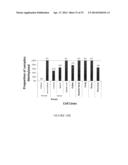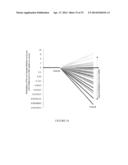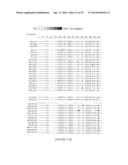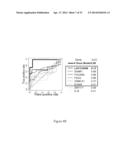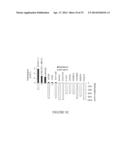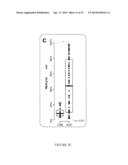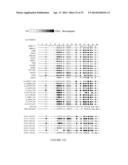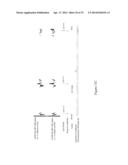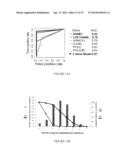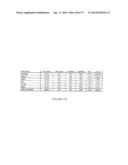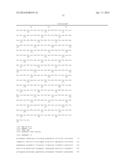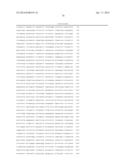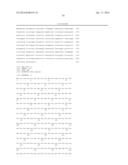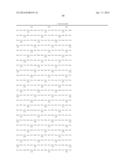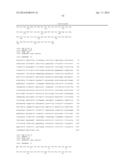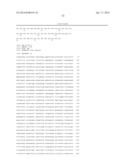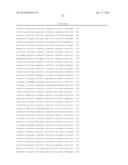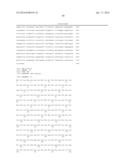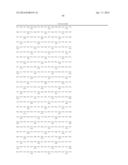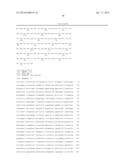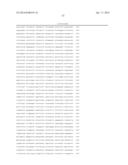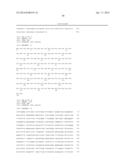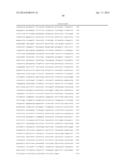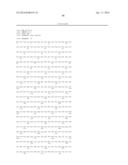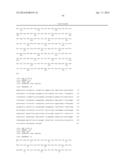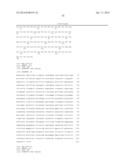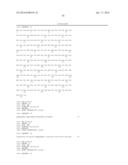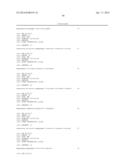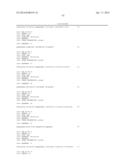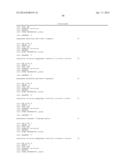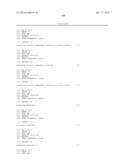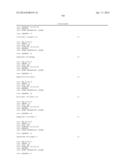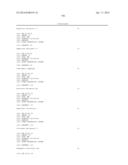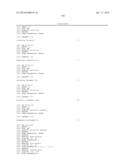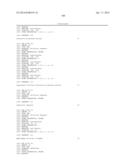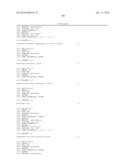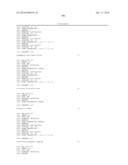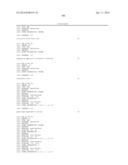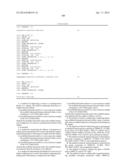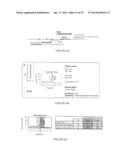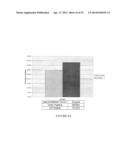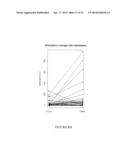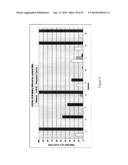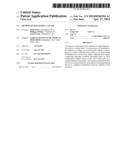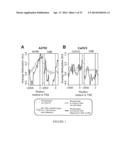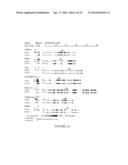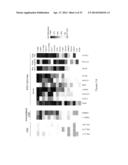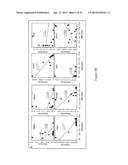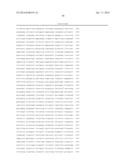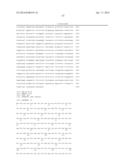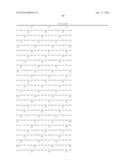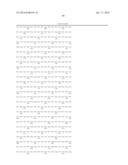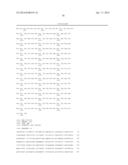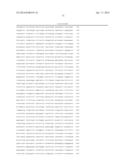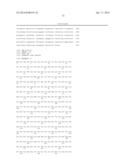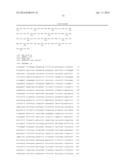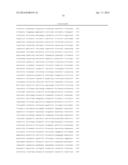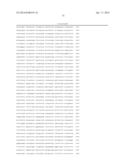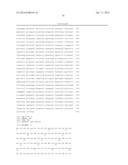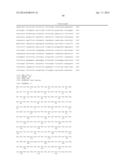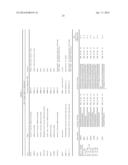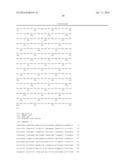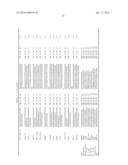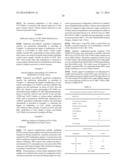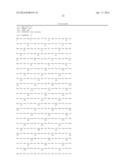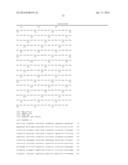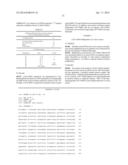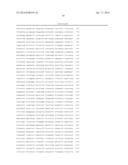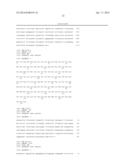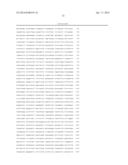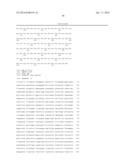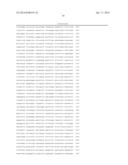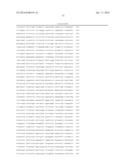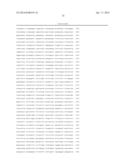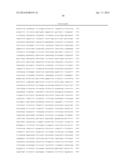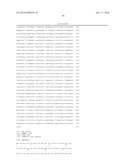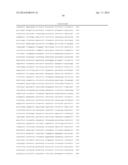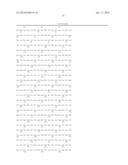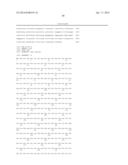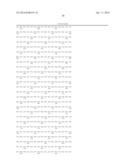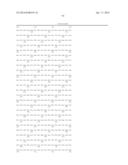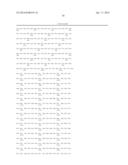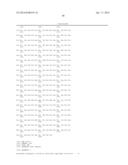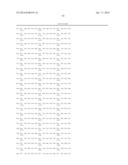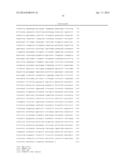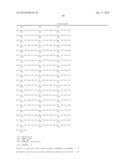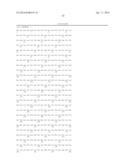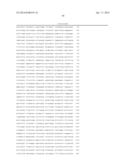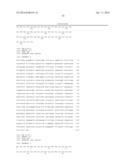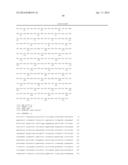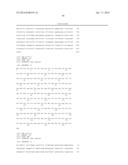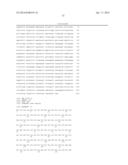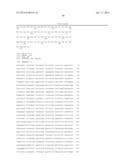Patent application title: Method of Diagnosing Cancer
Inventors:
Brian Gloss (Darlinghust, AU)
Philippa O'Brien (Lilyfield, AU)
Susan Clark (Darlinghurst, AU)
Assignees:
Garvan Institute of Medical Research
IPC8 Class: AC12Q168FI
USPC Class:
435 611
Class name: Measuring or testing process involving enzymes or micro-organisms; composition or test strip therefore; processes of forming such composition or test strip involving nucleic acid nucleic acid based assay involving a hybridization step with a nucleic acid probe, involving a single nucleotide polymorphism (snp), involving pharmacogenetics, involving genotyping, involving haplotyping, or involving detection of dna methylation gene expression
Publication date: 2014-04-17
Patent application number: 20140106354
Abstract:
The present invention provides methods for diagnosing cancer (such as
ovarian, breast, or colon cancer) or a predisposition thereto in a
subject, for monitoring the efficacy of treatment of a subject suffering
from cancer, or for determining the likelihood of survival of a subject
suffering from cancer, comprising detecting modified chromatin (such as
DNA methylation) within a locus of the LOC134466 gene in a sample taken
from the subject. The invention further provides kits for use in these
methods, and methods of treating subjects based on a diagnosis performed
using the methods of the invention.Claims:
1. A method for diagnosing a cancer or a predisposition thereto in a
subject, the method comprising detecting in a sample from the subject:
(i) modified chromatin relative to a non-cancerous sample the modified
chromatin being positioned within a locus containing a LOC134466 gene;
and/or (ii) modified expression relative to a non-cancerous sample of the
LOC1334466 RNA, wherein the modified chromatin and/or the modified
expression is diagnostic of a cancer or a predisposition thereto in the
subject.
2. (canceled)
3. A method for monitoring the efficacy of treatment of a subject receiving treatment for a cancer, the method comprising identifying and/or detecting in a sample from the subject: (i) modified chromatin relative to a non-cancerous sample the modified chromatin being positioned within a locus containing a LOC134466 gene; and/or (ii) modified expression relative to a non-cancerous sample of the LOC134466 RNA, wherein the modified chromatin and/or the modified expression indicates that the treatment is not effective.
4. A method for determining the likelihood of survival of a subject suffering from a cancer, the method comprising identifying and/or detecting in a sample from the subject (i) modified chromatin relative to a non-cancerous sample the modified chromatin being positioned within a locus containing a LOC134466 gene; and/or (ii) modified expression relative to a non-cancerous sample of the LOC134466 RNA, wherein the modified chromatin and/or the modified expression indicates that the subject is likely to survive.
5. The method of claim 1, additionally comprising detecting modified chromatin positioned within a gene or pseudogene and/or modified expression of the gene or pseudogene in the sample.
6. The method of claim 5, wherein the gene or pseudogene is selected from the group consisting of ARMCX1, ICAM4, IL18, PEG3, PYCARD, SGNE1, ZNF177, HSPA2, KLF4, LTBP2, PAPLN, PARVA, PTGER, SCIN1, SPOCK2, TLE4, ZNF542, BMP6, CST6, SOCS1 and combinations thereof.
7. The method of claim 5, wherein the gene is selected from the group consisting of ARMCX1, ICAM4, IL18, PEG3, PYCARD, SGNE1, ZNF177 and combinations thereof.
8. The method of claim 5, wherein the gene is selected from the group consisting of ARMCX1, ICAM4, PEG3, PYCARD, SGNE1 and combinations thereof.
9. The method of claim 5, wherein the gene is SGNE1 and/or ARMCX1 and/or PYCARD.
10. The method of claim 1, additionally comprising detecting modified chromatin positioned within ARMCX1, ICAM4, IL18, PEG3, PYCARD, SGNE1 and ZNF177 and/or modified expression of ARMCX1, ICAM4, IL18, PEG3, PYCARD, SGNE1 and ZNF177 in the sample.
11. The method of claim 1, comprising detecting modified chromatin positioned within ARMCX1, ICAM4, LOC134466, PEG3, PYCARD and SGNE1 and/or modified expression of ARMCX1, ICAM4, LOC134466, PEG3, PYCARD and SGNE1 in the sample.
12. The method of claim 1, wherein the modified expression is associated with the modified chromatin.
13. The method of claim 1, wherein the cancer is ovarian cancer, breast cancer, colon cancer or prostate cancer.
14. (canceled)
15. The method of claim 1, wherein modified chromatin is detected by performing a process comprising detecting the level of methylation of nucleic acid in the sample from the subject relative to a non-cancerous sample.
16. The method of claim 15, wherein the level of methylation is detected by performing a process comprising: (i) detecting the level of methylation of a nucleic acid within the gene in the sample derived from the subject; (ii) detecting the level of methylation of the nucleic acid within the gene in the control sample; and (iii) comparing the level of methylation at (i) and (ii).
17. The method of claim 15, wherein the level of methylation is detected by one or more of the following: (i) performing methylation-sensitive endonuclease digestion of DNA; (ii) treating nucleic acid from the sample with an amount of a compound that selectively mutates non-methylated cytosine residues in nucleic acid under conditions sufficient to induce mutagenesis thereof and produce a mutant nucleic acid and amplifying the mutant nucleic acid using at least one primer that selectively hybridizes to the mutant nucleic acid; (iii) treating nucleic acid from the sample with an amount of a compound that selectively mutates non-methylated cytosine residues in nucleic acid under conditions sufficient to induce mutagenesis thereof and produce a mutant nucleic acid, hybridizing a nucleic acid probe or primer capable of specifically hybridizing to the mutant nucleic acid and detecting the hybridized probe or primer; and (iv) treating nucleic acid from the sample with an amount of a compound that selectively mutates non-methylated cytosine residues in nucleic acid under conditions sufficient to induce mutagenesis thereof and produce a mutant nucleic acid determining the nucleotide sequence of the mutant nucleic acid.
18. The method of claim 17, wherein compound that selectively mutates non-methylated cytosine residues is a salt of bisulphite.
19. The method of claim 15, wherein the level of methylation is detected in a nucleic acid comprising a sequence set forth in SEQ ID NO: 1 or 3.
20. The method of claim 1, wherein the level of expression of a nucleic acid is detected by performing a process comprising: (i) detecting the level of expression of the gene in the sample from the subject; and (ii) detecting the level of expression of the gene in the non-cancerous sample.
21. The method of claim 20, wherein the level of expression of the nucleic acid is detected by performing a process comprising hybridizing a probe or primer capable of specifically hybridizing to a transcript of the gene to the nucleic acid in a sample and detecting the level of hybridization by a detection means, wherein the level of hybridization of the probe or primer is indicative of the level of expression of the gene.
22. The method of claim 20, wherein the level of expression is detected by performing a process comprising contacting the sample with an antibody or antigen binding fragment thereof capable of specifically binding to a polypeptide encoded by the gene for a time and under conditions for a complex to form and detecting the level of the complex by a detection means, wherein the level of the complex is indicative of the level of expression of the gene.
23. The method of claim 1, wherein the sample comprises tissue and/or a body fluid suspected of comprising a cancer cell.
24. The method of claim 1, wherein the sample comprises tissue or cells from a breast, an ovary, a colon or a prostate.
25. The method of claim 23 wherein the body fluid is selected from the group consisting of whole blood, a fraction of blood such as blood serum or plasma, urine, saliva, breast milk, pleural fluid, sweat, tears and mixtures thereof.
26. The method of claim 1, wherein the non-cancerous sample is selected from the group consisting of: (i) a sample comprising a non-cancerous cell; (ii) a sample from a normal tissue; (iii) a sample from a healthy tissue; (iv) an extract of any one of (i) to (iii); (v) a data set comprising measurements of modified chromatin and/or expression for a healthy individual or a population of healthy individuals; (vi) a data set comprising measurements of modified chromatin and/or expression for a normal individual or a population of normal individuals; and (vii) a data set comprising measurements of the modified chromatin and/or expression from the subject being tested wherein the measurements are determined in a matched sample having normal cells.
27. The method of claim 1, additionally comprising providing the result of the method.
28. (canceled)
Description:
[0001] This application is associated with and claims priority from
Australian provisional patent application number 2011901456, filed on 18
Apr. 2011, entitled "Method of diagnosing cancer", the subject matter of
which is incorporated herein in its entirety.
FIELD
[0002] The present invention relates to methods for diagnosing, prognosing or monitoring cancer.
BACKGROUND
[0003] Cancer is the second leading cause of human death next to coronary disease. Worldwide, millions of people die from cancer every year. In the United States alone, cancer causes the death of well over a half-million people annually, with about 1.4 million new cases diagnosed per year. While deaths from heart disease have been declining significantly, those resulting from cancer generally are on the rise. In the early part of this century, cancer is predicted to become the leading cause of death.
[0004] Worldwide, several cancers stand out as the leading killers, including prostate cancer, breast cancer and ovarian cancer. These and virtually all other carcinomas share a common lethal feature. With very few exceptions, metastatic disease from a carcinoma is fatal. Moreover, even for those cancer patients who initially survive their primary cancers, they may suffer a recurrence or secondary cancer.
[0005] Worldwide, prostate cancer is the fourth most prevalent cancer in men. In North America and Northern Europe, it is the most common cancer in males and is the second leading cause of cancer death in men. In the United States alone, over 40,000 men die annually of this disease, second only to lung cancer. Early detection and diagnosis of prostate cancer currently relies on digital rectal examinations (DRE), prostate specific antigen (PSA) measurements, transrectal ultrasonography (TRUS), and transrectal needle biopsy (TRNB). At present, measurement of serum PSA levels in combination with DRE represents the most commonly used method used to detect and diagnose prostate cancer.
[0006] In general, a serum PSA level above 4 ng/ml is considered indicative of prostate cancer, and a serum PSA level above 10 ng/ml is considered highly suggestive of prostate cancer. However, PSA levels are also increased in benign prostatic hyperplasia, infection and chronic inflammation. Moreover, studies performed as part of the Prostate Cancer Prevention Trial demonstrated that 15% of men who had a "normal" PSA level suffered from prostate cancer (Thompson et al., N. Eng. J. Med., 350: 2239-2246, 2004). Two additional studies have also reported that PSA screening had little or no effect on mortality (Eckersberger et al., Rev. Urol., 11: 127-133, 2009).
[0007] Ovarian cancer is the fifth leading cause of cancer death in women, the leading cause of death from gynecological malignancy, and the second most commonly diagnosed gynecologic malignancy (The Merck Manual of Diagnosis and Therapy Section 18. Gynecology And Obstetrics Chapter 241. Gynecologic Neoplasms). More than 50% of women with ovarian cancer are diagnosed in the advanced stages of the disease because no cost-effective screening test for ovarian cancer exists. The five year survival rate for all stages is only 35% to 38%. If, however, diagnosis is made early in the disease, five-year survival rates can reach 90% to 98%.
[0008] Worldwide, breast cancer is the fifth most common cause of cancer death (after lung cancer, stomach cancer, liver cancer, and colon cancer). In 2005, breast cancer caused 502,000 deaths (7% of cancer deaths; almost 1% of all deaths) worldwide. Among women worldwide, breast cancer is the most common cancer and the most common cause of cancer death. In the United States, breast cancer is the third most common cause of cancer death (after lung cancer and colon cancer). Among women in the U.S., breast cancer is the most common cancer and the second most common cause of cancer death (after lung cancer). Women in the US have a 1 in 8 lifetime chance of developing invasive breast cancer and a 1 in 33 chance of breast cancer causing their death.
[0009] Breast cancer is diagnosed by the pathological (microscopic) examination of surgically removed breast tissue. A number of procedures can obtain tissue or cells prior to definitive treatment for histological or cytological examination. Such procedures include fine-needle aspiration, nipple aspirates, ductal lavage, core needle biopsy, and local surgical excision biopsy. These diagnostic steps, when coupled with radiographic imaging, are usually accurate in diagnosing a breast lesion as cancer. Occasionally, pre-surgical procedures such as fine needle aspirate may not yield enough tissue to make a diagnosis, or may miss the cancer entirely. Imaging tests are sometimes used to detect metastasis and include chest X-ray, bone scan, CT, MRI, and PET scanning. While imaging studies are useful in determining the presence of metastatic disease, they are not in and of themselves diagnostic of cancer. Only microscopic evaluation of a biopsy specimen can yield a cancer diagnosis.
[0010] As will be apparent to the skilled artisan from the foregoing description, there is a need in the art for methods for diagnosing cancer, such as ovarian cancer, breast cancer or prostate cancer.
SUMMARY
[0011] The inventors have now determined that DNA within the LOC134466 gene is hypermethylated in cancer, e.g., in breast cancer, ovarian cancer, colon cancer (or "colorectal" cancer), head and neck cancer, lung cancer and pancreatic cancer and that LOC134466 RNA expression is reduced in cancer, e.g., breast cancer, ovarian cancer, colon cancer, head and neck cancer, lung cancer, pancreatic cancer and prostate cancer. For example, the inventors have determined that DNA within the LOC134466 gene is hypermethylated in ovarian cancer, colon cancer, and breast cancer. The inventors have shown that DNA methylation or reduced expression of LOC134466 is useful for distinguishing cancer cells from non-cancer cells. Thus, the level of DNA methylation or expression of LOC134466 is useful for distinguishing ovarian cancer, colon cancer, breast cancer, head and neck cancer, lung cancer, pancreatic cancer and/or prostate cancer cells from non-cancer cells. The level of DNA methylation or expression of LOC134466 is particularly useful for distinguishing ovarian cancer, colon cancer and/or breast cancer cells from non-cancer cells. The inventors have additionally shown that DNA methylation or reduced expression of LOC134466 RNA is useful for detecting various sub-types of cancer, e.g., epithelial ovarian cancer and sub-types thereof, such as clear cell carcinoma and serous carcinoma. The inventors have observed these changes in various distinct forms of cancer, meaning that the invention is generally applicable to cancer as well as to specific types of cancer. The inventors have also found that methods for detecting changes in, for example, methylation levels are robust, in so far as they permit detection in various samples treated in various manners, e.g., frozen, fixed and/or paraffin embedded. In addition, the inventors have found that such methods can be performed reliably in bodily fluid samples such as blood, plasma, or other bodily fluid samples to detect changes and/or status of, for example, methylation levels of any of the genes disclosed herein.
[0012] Based on the findings of the inventors, the present disclosure provides various methods for diagnosing, prognosing or monitoring cancer generally, as well as specific types of cancer, e.g., ovarian cancer, breast cancer, colon cancer or prostate cancer. In one particular example, the present disclosure provides various methods for diagnosing, prognosing or monitoring ovarian cancer.
[0013] For example, the present disclosure provides a method for diagnosing a cancer or a predisposition thereto in a subject, the method comprising detecting in a sample from the subject:
[0014] (i) modified chromatin relative to a non-cancerous sample the modified chromatin being positioned within a locus containing a LOC134466 gene and/or
[0015] (ii) modified expression relative to a non-cancerous sample of the LOC134466 RNA,
wherein the modified chromatin and/or the modified expression is diagnostic of a cancer or a predisposition thereto in the subject.
[0016] When used herein the phrase "locus containing a LOC134466 gene" includes reference to a locus which contains a LOC134466 gene and includes CpG #25 (chr5:150306098-150306387(hg18)) and extends upstream to CpG#23 (chr5:150264579-150264828 (hg18)) and downstream to CpG#43 (chr5:150264579-150264828(hg18)).
[0017] The present disclosure additionally or alternatively provides a method for monitoring the efficacy of treatment of a subject receiving treatment for a cancer, the method comprising identifying and/or detecting in a sample from the subject:
[0018] (i) unmodified chromatin or less-modified chromatin relative to a non-cancerous sample the unmodified chromatin or less-modified chromatin being positioned within a locus containing a LOC134466 gene; and/or
[0019] (ii) unmodified expression relative to a non-cancerous sample of the LOC134466 RNA,
wherein the unmodified chromatin or less-modified chromatin and/or the unmodified expression indicates that the treatment is effective.
[0020] The present disclosure additionally or alternatively provides a method for monitoring the efficacy of treatment of a subject receiving treatment for a cancer, the method comprising identifying and/or detecting in a sample from the subject:
[0021] (i) modified chromatin relative to a non-cancerous sample the modified chromatin being positioned within a locus containing a LOC134466 gene; and/or
[0022] (ii) modified expression relative to a non-cancerous sample of the LOC134466 RNA,
wherein the modified chromatin and/or the modified expression indicates that the treatment is not effective.
[0023] The present disclosure additionally or alternatively provides a method for determining the likelihood of survival of a subject suffering from a cancer, the method comprising identifying and/or detecting in a sample from the subject
[0024] (i) modified chromatin relative to a non-cancerous sample the modified chromatin being positioned within a locus containing a LOC134466 gene; and/or
[0025] (ii) modified expression relative to a non-cancerous sample of the LOC134466 RNA,
wherein the modified chromatin and/or the modified expression indicates that the subject is less likely to survive. The presence of an increased level of modified chromatin and/or expression in a sample taken from a subject relative to the level of modified chromatin and/or expression in a non-cancerous sample indicates a reduced likelihood of survival for the patient. Thus, the presence of modified chromatin and/or modified expression in a sample taken from the subject indicates that the subject is less likely to survive. Conversely, the presence of a reduced level of modified chromatin and/or expression in a sample taken from a subject relative to the level of modified chromatin and/or expression in a non-cancerous sample indicates an increased likelihood of survival for the patient.
[0026] In one example, the modified chromatin is within a LOC134466 gene. In another example, the modified chromatin is within a SGNE1 gene. In accordance with this example, any example included herein comprising detecting modified chromatin within a LOC134466 locus or gene or detecting modified expression of LOC134466 shall be taken to apply mutatis mutandis to detecting modified chromatin with a SGNE1 gene or modified SGNE1 expression.
[0027] In one example, a method of the disclosure is a multiplex or multi-analyte method. Thus, the method may comprise detecting modified chromatin and/or expression of other genes and/or pseudogenes in addition to the locus comprising LOC134466. For example, the method may additionally comprise detecting modified chromatin nucleic acid positioned within a locus containing a (or within a) gene or pseudogene and/or modified expression of the gene or pseudogene in the sample. In one example, the gene or pseudogene is selected from the group consisting of ARMCX1, ICAM4, IL18, PEG3, PYCARD, SGNE1, ZNF177, HSPA2, KLF4, LTBP2, PAPLN, PARVA, PTGER, SCIN1, SPOCK2, TLE4, ZNF542, BMP6, CST6, SOCS1 and combinations thereof. Preferred genes are selected from the group consisting of ARMCX1, ICAM4, IL18, PEG3, PYCARD, SGNE1, ZNF177 and combinations thereof. For example, preferred genes may be selected from ARMCX1, ICAM4, PEG3, PYCARD and SGNE1. In one example, the gene is PYCARD. In another preferred example, the gene is SGNE1.
[0028] The inventors have also identified panels of markers useful for diagnosing/prognosing cancer in a subject.
[0029] In one example, the method of the present disclosure comprises additionally detecting modified chromatin positioned within ARMCX1, ICAM4, IL18, PEG3, PYCARD, SGNE1 and ZNF177 and/or modified expression of ARMCX1, ICAM4, IL18, PEG3, PYCARD, SGNE1 and ZNF177 in the sample. In another example, the method of the present disclosure comprises additionally detecting modified chromatin positioned within ARMCX1, ICAM4, PEG3, PYCARD and SGNE1 and/or modified expression of ARMCX1, ICAM4, PEG3, PYCARD and SGNE1 in the sample. In another example, the method of the present disclosure comprises additionally detecting modified chromatin positioned within SGNE1, or within ARMCX1, or within ICAM4, or within PEG3, or within PYCARD, or within any combination of two or more of these genes, and/or modified expression of SGNE1, or ARMCX1, or ICAM4, or PEG3, or PYCARD, or any combination of two or more of these genes.
[0030] In one example, the method of the present disclosure comprises detecting modified chromatin positioned within ARMCX1, ICAM4, LOC134466, PEG3, PYCARD and SGNE1 and/or modified expression of ARMCX1, ICAM4, LOC134466, PEG3, PYCARD and SGNE1 in the sample.
[0031] In one example, the modified expression is associated with the modified chromatin or the unmodified expression is associated with (or caused by) the unmodified chromatin or less-modified chromatin.
[0032] The present disclosure encompasses diagnosis, prognosis or monitoring of any cancer. Exemplary cancers are ovarian cancer, breast cancer, colon cancer, prostate cancer, head and neck cancer, lung cancer and pancreatic cancer. Particular examples are ovarian cancer, breast cancer and/or colon cancer.
[0033] In one example, the cancer is ovarian cancer and/or breast cancer.
[0034] In one example, the ovarian cancer is clear cell carcinoma or serous carcinoma.
[0035] In one example, the breast cancer is invasive breast cancer or ductal carcinoma in situ.
[0036] In one exemplified form of the present disclosure, the modified chromatin or unmodified chromatin or less-modified chromatin is detected by performing a process comprising detecting the level of methylation of nucleic acid in the sample from the subject relative to a non-cancerous sample. In one example, the nucleic acid is DNA.
[0037] For example, the level of methylation may be detected by performing a process comprising:
(i) detecting the level of methylation of a nucleic acid within the pseudogene or gene in the sample derived from the subject; (ii) detecting the level of methylation of the nucleic acid within the pseudogene or gene in the control sample; and (iii) comparing the level of methylation at (i) and (ii).
[0038] For example, the level of methylation is detected by one or more of the following:
(i) performing methylation-sensitive endonuclease digestion of DNA; (ii) treating nucleic acid from the sample with an amount of a compound that selectively mutates non-methylated cytosine residues in nucleic acid under conditions sufficient to induce mutagenesis thereof and produce a mutant nucleic acid and amplifying the mutant nucleic acid using at least one primer that selectively hybridizes to the mutant nucleic acid and/or amplifying the methylated nucleic acid using at least one primer that selectively hybridizes to the methylated nucleic acid; (iii) treating nucleic acid from the sample with an amount of a compound that selectively mutates non-methylated cytosine residues in nucleic acid under conditions sufficient to induce mutagenesis thereof and produce a mutant nucleic acid, hybridizing a nucleic acid probe or primer capable of specifically hybridizing to the mutant nucleic acid or the methylated nucleic acid and detecting the hybridized probe or primer; and (iv) treating nucleic acid from the sample with an amount of a compound that selectively mutates non-methylated cytosine residues in nucleic acid under conditions sufficient to induce mutagenesis thereof and produce a mutant nucleic acid and determining the nucleotide sequence of the mutant nucleic acid;
[0039] In one example, the level of methylation is detected using a headloop PCR-based method.
[0040] In one example, the compound that selectively mutates non-methylated cytosine residues is a sodium salt of bisulphite.
[0041] Exemplary nucleic acids in which methylation is detected comprise any nucleic sequence as disclosed herein. For example, nucleic acids in which methylation is detected may comprise a sequence set forth in any one or more of SEQ ID NOs: 1, 3, 4, 6, 8 and 12. For example, nucleic acid in which methylation is detected may comprise a sequence set forth in SEQ ID NO: 1 or 3. In addition, methylation may be detected in any sequence within of any of the sequences disclosed herein. For example, methylation may be detected in a sequence within any one or more of SEQ ID NOs: 1, 3, 4, 6, 8 and 12. The specific length of the sequence within any of the sequences disclosed herein may vary. In one example, the sequence within any of the sequences disclosed herein comprises one or more CpG islands (i.e., the sequence within any of the sequences disclosed herein may comprise one or more CpG dinucleotides). Methylation may be detected at, within or near a promoter region and/or a transcription start site of any of the genes or pseudogenes disclosed herein. In one example, methylation can be detected in a sequence comprising nucleic acids 103 to 120 of SEQ ID NO: 3. In another example, methylation may be detected in a sequence comprising nucleic acids 160 to 185 of SEQ ID NO: 3.
[0042] In one example, the level of expression of a nucleic acid is detected by performing a process comprising:
[0043] (i) detecting the level of expression of the pseudogene or gene in the sample from the subject; and
[0044] (ii) detecting the level of expression of the pseudogene or gene in the non-cancerous sample.
[0045] For example, the level of expression of the nucleic acid is detected by performing a process comprising hybridizing a probe or primer capable of specifically hybridizing to a transcript of the pseudogene or gene to the nucleic acid in a sample and detecting the level of hybridization by a detection means, wherein the level of hybridization of the probe or primer is indicative of the level of expression of the pseudogene or gene.
[0046] In one example, the level of expression is detected by performing a process comprising contacting the sample with an antibody or antigen binding fragment thereof capable of specifically binding to a polypeptide encoded by the pseudogene or gene for a time and under conditions for a complex to form and detecting the level of the complex by a detection means, wherein the level of the complex is indicative of the level of expression of the pseudogene or gene.
[0047] In one example, the sample comprises tissue and/or a body fluid suspected of comprising a cancer cell. For example, the sample may comprise tissue or cells from a breast, an ovary, a colon or a prostate. Exemplary body fluids are selected from the group consisting of whole blood, a fraction of blood (such as blood plasma, serum, or another fraction of blood), urine, saliva, breast milk, pleural fluid, sweat, tears and mixtures thereof. Preferably, the sample is blood or a derivative thereof, such as blood plasma or serum.
[0048] In one example, the sample is a tumor sample. In one example, the sample was frozen following collection. In one example, the sample was fixed, e.g., in formalin following collection. In one example, the sample is embedded in a solid or semi-solid substrate, e.g., paraffin.
[0049] In one example, the non-cancerous sample selected from the group consisting of:
[0050] (i) a sample comprising a non-cancerous cell;
[0051] (ii) a sample from a normal tissue;
[0052] (iii) a sample from a healthy tissue;
[0053] (iv) an extract of any one of (i) to (iii);
[0054] (v) a data set comprising measurements of modified chromatin and/or expression for a healthy individual or a population of healthy individuals;
[0055] (vi) a data set comprising measurements of modified chromatin and/or expression for a normal individual or a population of normal individuals; and
[0056] (vii) a data set comprising measurements of the modified chromatin and/or expression from the subject being tested wherein the measurements are determined in a matched sample having normal cells.
[0057] In one example, a method of the present disclosure additionally comprises providing the result of the method, e.g., in paper or computer readable form.
[0058] The present disclosure additionally provides a method of treating or preventing cancer comprising performing a method described herein according to any example to diagnose cancer or a predisposition thereto and performing or recommending therapeutic or prophylactic treatment for cancer.
BRIEF DESCRIPTION OF THE DRAWINGS
[0059] FIG. 1 comprises two graphical representations showing methylation profiles of gene candidate lists relative to random gene selections. Panel A shows MeDIP-chip signals from candidate genes identified from A2780 cells. Panel B shows MeDIP-chip signals from candidate genes identified from CaOV3 genes. Averaged MeDIP-Chip signal (y axes) of gene candidate lists over the promoter (2 kb upstream) of the TSS (x-axes) in EOC cell lines A2780, CaOV3 and OSE. Methylation distributions of 1000 random selections of genes were plotted (grey shading) for comparison.
[0060] FIG. 2A is a series of diagrammatic and graphical representations. Panel (a) shows CpG methylation at 7 candidate gene promoters (as indicated) in cell lines A2780 and CaOV3. Average promoter methylation (percentage and greyscale) was calculated from all informative CpG units excluding overlapping peaks and CpG dinucleotides within primer sequences. Transcriptional start sites (TSS) are shown as arrows, * indicates non-canonical CpG island.
[0061] FIG. 2B includes two graphical representations showing the correlation of average DNA methylation measured by Sequenom (x-axis) and MAT analysis for gene promoters in A2780 (top panel) and CaOV3 (bottom Panel), Pearsons correlation coefficent (r) is calculated and line of best fit is plotted (dotted line).
[0062] FIG. 3A is a diagrammatic representation showing the average promoter methylation, sorted by average methylation in all samples, of the sixteen genes with evidence of methylation in the profiled cell lines as determined by Sequenom analysis in a panel of primary OSE, immortalized OSE (HOSE) and EOC cell lines.
[0063] FIG. 3B is a graphical representation showing relative mRNA levels normalized to 18s RNA of 8 methylated genes (y axis) measured against average promoter methylation (x-axis) for immortalized OSE and EOC cell lines. A line of best fit is plotted and Pearson's correlation coefficient (r) and p value are included.
[0064] FIG. 4A is a diagrammatic representation showing hierarchical clustering of average promoter methylation for 15 candidate genes in a panel of 20 serous EOC. Eight genes (enclosed by box) exhibit evidence of methylation in multiple tumor samples.
[0065] FIG. 4B is a graphical representation showing receiver operating characteristic (ROC) curves, indicating area under the curve (AUC) and significance (Mann-Whitney U test p value) for eight genes displaying methylation in ovarian tumors. and logistic regression model of six genes identified as best fitted to the data by ANOVA (black broken line).
[0066] FIGS. 5A and 5B show results of clonal bisulphite sequencing of DNA surrounding the TSS of LOC134466 from 5 tumours, 4 OSE, 4 cancer cell lines (A2780, CaOV3, OV90, UWB1.289) and one immortalised OSE (HOSE 17.1) along with controls (CpGenomoe & Roche). The transcription start site (TSS) is indicated by the arrow. Black circles indicate methylated sites and white circles indicate non-methylated sites.
[0067] FIG. 5C is a graphical representation showing expression of LOC134466 (relative to 18s) in cell lines compared with average methylation of CpG units at the TSS of the gene.
[0068] FIG. 5D is a diagrammatic representation showing hierarchical clustering of Sequenom methylation levels at CpG units flanking the TSS of LOC134466 for 69 Type II EOC tumors and 14 OSE.
[0069] FIG. 5E is a graphical representation showing averaged methylation for the region surrounding the TSS of LOC134466 in tumor samples versus OSE.
[0070] FIG. 5F is a graphical representation showing a ROC, which demonstrates low false-positive rate for cancer discrimination at high methylation levels in regions surrounding the TSS of LOC143366.
[0071] FIG. 6A is a graphical representation showing the location, relative to the TSS of LOC143366 (arrow), of primers (indicated) and CpGs (circles) interrogated by the headloop and probe (indicated) (B) Output of headloop suppression PCR by agarose gel and dissociation curve.
[0072] FIG. 6B is a graphical representation showing amplification on unmethylated template is suppressed by the headloop but can be visualized by its dissociation characteristics.
[0073] FIG. 6C is a series of graphical representations showing an exemplary dissociation curve of methylated sample and unmethylated sample with peak dissociation shown along with Tm cutoff for methylation used to in the method of determining headloop positivity (table).
[0074] FIG. 7 is a graphical representation showing the percentage of samples positive for headloop suppression PCR assay designed to interrogate CpGs at the TSS of LOC143366 for 15 OSE and 100 archival FFPE Type II EOC samples.
[0075] FIG. 8A is a graphical representation showing the proportion of matched primary breast tumor and lymph node metastasis samples positive for methylation of LOC134466.
[0076] FIG. 8B is a graphical representation showing relative methylation for primary tumours compared to the lymph node metastasis for the same patients.
[0077] FIG. 9 is a graphical representation showing relative methylation levels in samples derived from nine matched normal, DCIS and carcinoma samples.
[0078] FIG. 10 is a diagrammatic representation showing the level of methylation in LOC134466 in cell lines from breast normal epithelium and tumours as measured by both Sequenom MassARRAY and headloop suppression PCR. The region assayed using head-loop PCR is highlighted in grey.
[0079] FIGS. 11A-D are a series of graphical representations showing the level of methylation in LOC134466 in fresh frozen ovarian cancer samples (A), normal ovarian surface epithelium (B), immortalized ovarian surface epithelium (HOSE) ovarian cancers and clear cell ovarian cancer samples (C) and paraffin embedded ovarian cancer samples (D) as measured by both Sequenom MassARRAY.
[0080] FIGS. 12A and B are a series of graphical representations showing results of quantitative Sequenom analysis of methylation (bars) in cell lines A2780 and CaOV3 (A) and EOC cell lines and immortalised OSE (HOSE) (B) for CpG islands surrounding LOC134466. Genes are sorted relative to location in the genome.
[0081] FIG. 12C shows methylation patterns of CpG#23, CpG#25 and CpG#43 in the cell lines A2780 and CaOV3 relative to ovarian surface epithelium (OSE) cells as measured by MeDIP-chip.
[0082] FIG. 13A shows Receiver Operating Characteristic (ROC) curves for each of six genes LOC134466, SGNE1, ARMCX1, ICAM4, PEG3 and PYCARD, as well as a two gene panel (LOC134466 and SGNE1), whose methylation status is used to distinguish EOC from OSE.
[0083] FIG. 13B illustrates the distribution of methylation status of the six gene panel in EOC vs OEC. The left hand y axis indicates the number of samples with n genes of the six gene panel methylated. The right hand y axis indicates the cumulative percentage of samples containing n methylated genes of the six gene panel.
[0084] FIG. 13C shows the calculated sensitivity and specificity for each of the genes or combinations studied.
[0085] FIG. 14 shows the results of two experiments determining LOC134466 methylation status (one comparing plasma from 26 patients with ovarian cancer to plasma from 11 patients with non-ovarian cancers (Nov); the other comparing plasma from 12 healthy control subjects, 10 patients with ovarian cancer and 10 patients with non-ovarian cancers (Oct)).
[0086] FIG. 15 shows the proportion of plasma samples from healthy patients or cancer patients positive for LOC134466 or SGNE1 methylation, comparing plasma from 12 healthy control subjects, 10 patients with ovarian cancer and 10 patients with non-ovarian cancers.
[0087] FIG. 16A shows the methylation status of both LOC134466 and SGNE1 in various cell lines (1, dark shading=methylated; 0, light shading=unmethylated).
[0088] FIG. 16B shows the proportion of samples from various cancer cell lines containing methylated LOC134466.
[0089] FIG. 17 shows LOC134466 expression as determined by TaqMan® qRTPCR relative to DNA methylation as determined by MSH-PCR in various cell lines.
[0090] FIG. 18 shows LOC134466 methylation status in colon cancer samples compared to normal tissue (lowest sloping line).
DETAILED DESCRIPTION
Key to Sequence Listing
[0091] SEQ ID NO 1: nucleotide sequence of Homo sapiens zinc finger protein 300 pseudogene SEQ ID NO 2: amino acid sequence of Homo sapiens KRAB domain-containing protein LOC134466 SEQ ID NO 3: nucleotide sequence of a region of LOC134466 for methylation analysis SEQ ID NO 4: nucleotide sequence of Homo sapiens paternally expressed 3 (PEG3) (transcript variant 1) SEQ ID NO 5: amino acid sequence of Homo sapiens paternally expressed 3 (PEG3) (transcript variant 1) SEQ ID NO 6: nucleotide sequence of Homo sapiens armadillo repeat containing, X-linked 1 (ARMXC 1) SEQ ID NO 7: amino acid sequence of Homo sapiens armadillo repeat containing, X-linked 1 (ARMXC 1) SEQ ID NO 8: nucleotide sequence of Homo sapiens intracellular adhesion molecule 4 (ICAM4) (transcript variant 1) SEQ ID NO 9: amino acid sequence of Homo sapiens intracellular adhesion molecule 4 (ICAM4) (transcript variant 1) SEQ ID NO 10: nucleotide sequence of Homo sapiens interleukin 18 (IL-18) SEQ ID NO 11: amino acid of Homo sapiens interleukin 18 (IL-18) SEQ ID NO 12: nucleotide sequence of Homos sapiens PYD and CARD domain containing (PYCARD) (transcript variant 1) SEQ ID NO 13: amino acid sequence of Homos sapiens PYD and CARD domain containing (PYCARD) (transcript variant 1) SEQ ID NO 14: nucleotide sequence of Homo sapiens secretogranin V (7B2 protein/SGNE1 protein) (transcript variant 1) SEQ ID NO 15: amino acid sequence of Homo sapiens secretogranin V (7B2 protein/SGNE1 protein) (transcript variant 1) SEQ ID NO 16: nucleotide sequence of Homo sapiens zinc finger protein 177 (ZNF177) (transcript variant 1) SEQ ID NO 17: amino acid sequence of Homo sapiens zinc finger protein 177 (ZNF177) (transcript variant 1) SEQ ID NO 18: nucleotide sequence of Homo sapiens heat shock protein 2 (HSPA2) SEQ ID NO 19: amino acid sequence of Homo sapiens heat shock protein 2 (HSPA2) SEQ ID NO 20: nucleotide sequence of Homo sapiens kruppel-like factor 4 (KLF4) SEQ ID NO 21: amino acid sequence of Homo sapiens kruppel-like factor 4 (KLF4) SEQ ID NO 22: nucleotide sequence of Homo sapiens latent transforming growth factor beta binding protein 2 (LTBP2) SEQ ID NO 23: amino acid sequence of Homo sapiens latent transforming growth factor beta binding protein 2 (LTBP2) SEQ ID NO 24: nucleotide sequence of Homo sapiens papilin, proteoglycan-like sulphated glycoprotein (PAPLN) SEQ ID NO 25: amino acid sequence of Homo sapiens papilin, proteoglycan-like sulphated glycoprotein (PAPLN) SEQ ID NO 26: nucleotide sequence of Homo sapiens parvin alpha (PARVA) SEQ ID NO 27: amino acid sequence of Homo sapiens parvin alpha (PARVA) SEQ ID NO 28: nucleotide sequence of Homo sapiens prostaglandin E receptor 3 (subtype 3) (PTGER3 isoform 5) SEQ ID NO 29: amino acid sequence of Homo sapiens prostaglandin E receptor 3 (subtype 3) (PTGER3 isoform 5) SEQ ID NO 30: nucleotide sequence of Homo sapiens scinderin (SCIN) (transcript variant 1) SEQ ID NO 31: amino acid sequence of Homo sapiens scinderin (SCIN) (transcript variant 1) SEQ ID NO 32: nucleotide sequence of Homo sapiens sparc/osteonectin cwcv, and kazal-like domains (SPOCK2) (transcript variant 1) SEQ ID NO 33: amino acid sequence of Homo sapiens sparc/osteonectin cwcv, and kazal-like domains (SPOCK2) (transcript variant 1) SEQ ID NO 34: nucleotide sequence of Homo sapiens transducin-like enhancer of split 4 (E(sp1)) homolog (TLE4) SEQ ID NO 35: amino acid sequence of Homo sapiens transducin-like enhancer of split 4 (E(sp1)) homolog (TLE4) SEQ ID NO 36: RNA sequence of Homo sapiens zinc finger protein 542 (ZNF542) (transcript variant 1) SEQ ID NO 37: ORF sequence of Homo sapiens zinc finger protein 542 (ZNF542) SEQ ID NO 38: nucleotide sequence of Homo sapiens bone morphogenetic protein 6 (BMP6) SEQ ID NO 39: amino acid sequence of Homo sapiens bone morphogenetic protein 6 (BMP6) SEQ ID NO 40: nucleotide sequence of Homo sapiens cystatin E/M (CST6) SEQ ID NO 41: amino acid sequence of Homo sapiens cystatin E/M (CST6) SEQ ID NO 42: nucleotide sequence of Homo sapiens suppressor of cytokine signaling 1 (SOCS1) SEQ ID NO 43: amino acid sequence of Homo sapiens suppressor of cytokine signaling 1 (SOCS1) SEQ ID NO 44: BSP-T7 forward primer ARMCX1 SEQ ID NO 45: BSP-T7 reverse primer ARMCX1 SEQ ID NO 46: BSP-T7 forward primer BMP6 SEQ ID NO 47: BSP-T7 reverse primer BMP6 SEQ ID NO 48: BSP-T7 forward primer CST6 SEQ ID NO 49: BSP-T7 reverse primer CST6 SEQ ID NO 50: BSP-T7 forward primer HSPA2 SEQ ID NO 51: BSP-T7 reverse primer HSPA2 SEQ ID NO 52: BSP-T7 forward primer ICAM4 SEQ ID NO 53: BSP-T7 reverse primer ICAM4 SEQ ID NO 54: BSP-T7 forward primer IL18 SEQ ID NO 55: BSP-T7 reverse primer IL18 SEQ ID NO 56: BSP-T7 forward primer KLF4 SEQ ID NO 57: BSP-T7 reverse primer KLF4 SEQ ID NO 58: BSP-T7 forward primer LOC134466 RC SEQ ID NO 59: BSP-T7 reverse primer LOC134466 RC SEQ ID NO 60: BSP-T7 forward primer LTBP2 RC SEQ ID NO 61: BSP-T7 reverse primer LTBP2 RC SEQ ID NO 62: BSP-T7 forward primer PAPLN SEQ ID NO 63: BSP-T7 reverse primer PAPLN SEQ ID NO 64: BSP-T7 forward primer PARVA SEQ ID NO 65: BSP-T7 reverse primer PARVA SEQ ID NO 66: BSP-T7 forward primer PEG3 long SEQ ID NO 67: BSP-T7 reverse primer PEG3 long SEQ ID NO 68: BSP-T7 forward primer PEG3 short SEQ ID NO 69: BSP-T7 reverse primer PEG3 short SEQ ID NO 70: BSP-T7 forward primer PTGER3 SEQ ID NO 71: BSP-T7 reverse primer PTGER3 SEQ ID NO 72: BSP-T7 forward primer PYCARD SEQ ID NO 73: BSP-T7 reverse primer PYCARD SEQ ID NO 74: BSP-T7 forward primer SCIN SEQ ID NO 75: BSP-T7 reverse primer SCIN SEQ ID NO 76: BSP-T7 forward primer SGNE1 SEQ ID NO 77: BSP-T7 reverse primer SGNE1 SEQ ID NO 78: BSP-T7 forward primer SOCS3 SEQ ID NO 79: BSP-T7 reverse primer SOCS3 SEQ ID NO 80: BSP-T7 forward primer SPOCK2 RC SEQ ID NO 81: BSP-T7 reverse primer SPOCK2 RC SEQ ID NO 82: BSP-T7 forward primer TLE4 SEQ ID NO 83: BSP-T7 reverse primer TLE4 SEQ ID NO 84: BSP-T7 forward primer ZNF177 SEQ ID NO 85: BSP-T7 reverse primer ZNF177 SEQ ID NO 86: BSP-T7 forward primer ZNF542 SEQ ID NO 87: BSP-T7 reverse primer ZNF542 SEQ ID NO 88: SYBR forward primer ARMCX1 SEQ ID NO 89: SYBR reverse primer ARMCX1 SEQ ID NO 90: SYBR forward primer HSPA2 SEQ ID NO 91: SYBR reverse primer HSPA2 SEQ ID NO 92: SYBR forward primer ICAM4 SEQ ID NO 93: SYBR reverse primer ICAM4 SEQ ID NO 94: SYBR forward primer IL18 SEQ ID NO 95: SYBR reverse primer IL18 SEQ ID NO 96: SYBR forward primer LOC13446 SEQ ID NO 97: SYBR reverse primer LOC13446 SEQ ID NO 98: SYBR forward primer PEG3 SEQ ID NO 99: SYBR reverse primer PEG3 SEQ ID NO 100: SYBR forward primer PYCARD SEQ ID NO 101: SYBR reverse primer PYCARD SEQ ID NO 102: SYBR forward primer SCIN SEQ ID NO 103: SYBR reverse primer SCIN SEQ ID NO 104: SYBR forward primer TLE4 SEQ ID NO 105: SYBR reverse primer TLE4 SEQ ID NO 106: SYBR forward primer ZNF177 SEQ ID NO 107: SYBR reverse primer ZNF177 SEQ ID NO 108: ARMCXHL F 1 primer SEQ ID NO 109: ARMCX_HL_R1 primer SEQ ID NO 110: ARMCX_HL_R1HL primer SEQ ID NO 111: ARMCX_HLcomPrb primer SEQ ID NO 112: ICAM4_HL_F1 primer SEQ ID NO 113: ICAM4_HL_F1HL primer SEQ ID NO 114: ICAM4_HL_R1 primer SEQ ID NO 115: ICAM4_HL_R1HL primer SEQ ID NO 116: ICAM4_HLcomPrb primer SEQ ID NO 117: LOC_ts_R4HL primer SEQ ID NO 118: LOC_ts_F4 primer SEQ ID NO 119: LOC_ts_R4 primer SEQ ID NO 120: LOC_HLcomPrb primer SEQ ID NO 121: PEG3_HL_F 1 primer SEQ ID NO 122: PEG3_HL_R1 primer SEQ ID NO 123: PEG3_HL_R1HL primer SEQ ID NO 124: PEG3_HLcomPrb primer SEQ ID NO 125: PYCARD_HL_μl primer SEQ ID NO 126: PYCARD_HL_R1 primer SEQ ID NO 127: PYCARD_HL_R1HL primer SEQ ID NO 128: PYCARD_HLcomPrb primer SEQ ID NO 129: SGNE1_HL_F1 primer SEQ ID NO 130: SGNE1_HL_R1 primer SEQ ID NO 131: SGNE1_HL_R1HL primer SEQ ID NO 132: SGNE1_HLcomPrb primer
General
[0092] Throughout this specification, unless specifically stated otherwise or the context requires otherwise, reference to a single step, composition of matter, group of steps or group of compositions of matter shall be taken to encompass one and a plurality (i.e. one or more) of those steps, compositions of matter, groups of steps or group of compositions of matter.
[0093] Each embodiment described herein is to be applied mutatis mutandis to each and every other embodiment unless specifically stated otherwise.
[0094] Those skilled in the art will appreciate that the invention described herein is susceptible to variations and modifications other than those specifically described. It is to be understood that the invention includes all such variations and modifications. The invention also includes all of the steps, features, compositions and compounds referred to or indicated in this specification, individually or collectively, and any and all combinations or any two or more of said steps or features.
[0095] The present invention is not to be limited in scope by the specific embodiments described herein, which are intended for the purpose of exemplification only. Functionally-equivalent products, compositions and methods are clearly within the scope of the invention, as described herein.
[0096] The present invention is performed without undue experimentation using, unless otherwise indicated, conventional techniques of molecular biology, microbiology, virology, recombinant DNA technology, peptide synthesis in solution, solid phase peptide synthesis, and immunology. Such procedures are described, for example, in Sambrook, Fritsch & Maniatis, Molecular Cloning: A Laboratory Manual, Cold Spring Harbor Laboratories, New York, Second Edition (1989), whole of Vols I, II, and DI; DNA Cloning: A Practical Approach, Vols. I and II (D. N. Glover, ed., 1985), IRL Press, Oxford, whole of text; Oligonucleotide Synthesis: A Practical Approach (M. J. Gait, ed, 1984) IRL Press, Oxford, whole of text, and particularly the papers therein by Gait, ppl-22; Atkinson et al, pp 35-81; Sproat et al, pp 83-115; and Wu et al, pp 135-151; 4. Nucleic Acid Hybridization: A Practical Approach (B. D. Hames & S. J. Higgins, eds., 1985) IRL Press, Oxford, whole of text; Immobilized Cells and Enzymes: A Practical Approach (1986) IRL Press, Oxford, whole of text; Perbal, B., A Practical Guide to Molecular Cloning (1984); Methods In Enzymology (S. Colowick and N. Kaplan, eds., Academic Press, Inc.), whole of series; J. F. Ramalho Ortigao, "The Chemistry of Peptide Synthesis" In: Knowledge database of Access to Virtual Laboratory website (Interactiva, Germany); Sakakibara, D., Teichman, J., Lien, E. Land Fenichel, R. L. (1976). Biochem. Biophys. Res. Commun. 73 336-342; Merrifield, R. B. (1963). J. Am. Chem. Soc. 85, 2149-2154; Barany, G. and Merrifield, R. B. (1979) in The Peptides (Gross, E. and Meienhofer, J. eds.), vol. 2, pp. 1-284, Academic Press, New York. 12. Wunsch, E., ed. (1974) Synthese von Peptiden in Houben-Weyls Metoden der Organischen Chemie (Muller, E., ed.), vol. 15, 4th edn., Parts 1 and 2, Thieme, Stuttgart; Bodanszky, M. (1984) Principles of Peptide Synthesis, Springer-Verlag, Heidelberg; Bodanszky, M. & Bodanszky, A. (1984) The Practice of Peptide Synthesis, Springer-Verlag, Heidelberg; Bodanszky, M. (1985) Int. J. Peptide Protein Res. 25, 449-474; Handbook of Experimental Immunology, Vols. I-IV (D. M. Weir and C. C. Blackwell, eds., 1986, Blackwell Scientific Publications); and Animal Cell Culture: Practical Approach, Third Edition (John R. W. Masters, ed., 2000), ISBN 0199637970, whole of text.
[0097] The present invention shall be taken to encompass any markers collectively or individually as provided in any list herein. By "collectively" is meant that the invention encompasses any number or combination of the recited proteins or markers or groups of proteins or markers, and that, notwithstanding that such numbers or combinations of proteins or markers or groups of proteins or markers may not be specifically listed herein the accompanying claims may define such combinations or sub-combinations separately and divisibly from any other combination of proteins or markers or groups of proteins or markers. By "individually" is meant that the invention encompasses the recited proteins or markers or groups of proteins or markers separately, and that, notwithstanding that individual proteins or markers or groups of proteins or markers may not be separately listed herein the accompanying claims may define such protein or marker or groups of proteins or markers separately and divisibly from each other.
[0098] The term "and/or", e.g., "X and/or Y" shall be understood to mean either "X and Y" or "X or Y" and shall be taken to provide explicit support for both meanings or for either meaning.
[0099] Throughout this specification the word "comprise", or variations such as "comprises" or "comprising", will be understood to imply the inclusion of a stated element, integer or step, or group of elements, integers or steps, but not the exclusion of any other element, integer or step, or group of elements, integers or steps.
SELECTED DEFINITIONS
[0100] As used herein, the term "pseudogene" will be understood to mean a sequence in the genome of a subject that is a copy of a genomic gene. The pseudogene may be transcribed and/or translated or transcribe a non-coding RNA. This term also encompasses intervening intronic sequences (if present) in addition to regulatory regions that control the expression of the pseudogene (if present).
[0101] As used herein, the term "gene" means nucleic acid in the genome of a subject capable of being expressed to produce a mRNA and/or protein in addition to intervening intronic sequences and in addition to regulatory regions that control the expression of the gene, e.g., a promoter or fragment thereof.
[0102] As used herein, discussion of a nucleic acid "within" a pseudogene or a gene, will be understood to encompass a nucleic acid within a protein and/or mRNA coding region, or an intronic region or a regulatory region or other non-coding region (upstream or downstream of a mRNA or protein coding region). In one example, a nucleic acid within a LOC134466 gene that is methylated is within the regulatory region (e.g., a promoter or enhancer), optionally including a transcriptional start site.
[0103] The term "within a locus containing a pseudogene [or gene]" will be understood to mean within a region of a genome containing the pseudogene [or gene], for example a region of the genome containing pseudogene [or gene] and about 100 Mb or 50 Mb or 20 Mb or 10 Mb upstream and/or downstream of the pseudogene [or gene]. In the case of LOC134466, a region containing the pseudogene can comprise the region spanning from TNIP1 to DCN4, or from GPX3 to MST150 or from GPX3 to ZNF300 or from GPX3 to LOC134466 or from LOC134466 to ZNF300.
[0104] As used herein, the term "diagnosis", and variants thereof, such as, but not limited to "diagnose" or "diagnosing" shall include, but not be limited to, a primary diagnosis of a clinical state or any primary diagnosis of a clinical state. A diagnostic assay described herein is also useful for assessing the remission of a subject, or monitoring disease recurrence, or tumor recurrence, such as following surgery, radiation therapy, adjuvant therapy or chemotherapy, or determining the appearance of metastases of a primary tumor. All such uses of the assays described herein are encompassed by the present disclosure.
[0105] As used herein, the term "cancer" shall be taken to include a disease that is characterized by uncontrolled growth of cells within a subject. The term "cancer" shall not be limited to cancer of a specific tissue or cell type. Those skilled in the art will be aware that as a cancer progresses, metastases occur in organs and tissues outside the site of the primary cancer. For example, in the case of many cancers, metastases commonly appear in a tissue selected from the group consisting of lymph nodes, lung, breast, liver, kidney and/or bone. Accordingly, the term "cancer" as used herein shall be taken to include a metastasis of a cancer in addition to a primary tumor. Exemplary cancers include breast cancer, ovarian cancer, colon cancer, head and neck cancer, lung cancer, pancreatic cancer and/or prostate cancer. In a preferred embodiment, the cancer is selected from the group consisting of a colon cancer, a prostate cancer, a breast cancer, an ovarian cancer or a pancreatic cancer. For example, the cancer may be a colon cancer, a prostate cancer or a breast cancer. For example, the cancer may be an ovarian cancer, a breast cancer, or a colon cancer. For example, the cancer may be a colon cancer. Alternatively, the cancer may be a prostate cancer. Alternatively, the cancer may be a breast cancer. Alternatively, the cancer may be an ovarian cancer.
[0106] As used herein, the term "chromatin" shall be taken to mean nucleic acid in the context of the genome, including (but not limited to) in the context of a complex of nucleic acid (e.g., genomic DNA) and protein (e.g., one or more histones) such as a nucleosome. As will be understood by the skilled artisan, nucleic acid and protein e.g., histones, are generally packaged to fowl nucleosomes that form in the interphase nucleus of a cell. The term "chromatin" also encompasses "naked" DNA (i.e., not associated with a protein) as is observed at transcription start sites and/or promoters of transcriptionally active genes and/or pseudogenes. It will be apparent from the disclosure herein that the state of chromatin can be determined for nucleic acid bound to protein, e.g., histone or in its naked form, e.g., methylated DNA.
[0107] As used herein, the term "modified chromatin" shall be taken to mean a change in the relative amount of euchromatin and heterochromatin in a biological sample (e.g., a cell or a cell extract) from a subject detected on the basis of any means including reduced expression of a gene, hypermethylation or deacetylation of nucleic acid and/or histone. In one example, the term "modified chromatin" means an increased or reduced level of methylation of DNA. In the present context, modified chromatin is generally determined with reference to a baseline such as a non-cancerous sample, including a non-cancerous matched sample from a subject known to have a tumor.
[0108] The skilled artisan will be aware that the term "hypermethylated nucleic acid" and equivalents shall be taken to mean that a plurality of CpG dinucleotides in a specific or defined region of nucleic acid is methylated. In one example, the nucleic acid is DNA.
[0109] As used herein, the term "unmodified chromatin" shall be taken to mean, for example, that a gene is expressed at a level similar to or the same as a non-cancerous cell; and/or that the level of methylation of a nucleic acid is similar or the same as a non-cancerous cell; and/or that the level of acetylation/methylation of a histone that is the same or similar to a non-cancerous cell.
[0110] As will be apparent to the skilled person from the foregoing, "less-modified" chromatin will be altered to a smaller degree and/or only be altered in some aspects compared to modified chromatin. E.g., less modified chromatin may comprise nucleic acid that is methylated to a degree less than that observed in modified chromatin. The modified chromatin may include coding or non-coding nucleic acid. Non-coding nucleic acid is understood in the art to include an intron, a 5'-untranslated region, a 3' untranslated region, a promoter region of a genomic gene, or an intergenic region.
[0111] As used herein, the term "non-cancerous sample" shall be taken to include any sample from or including a normal or healthy cell or tissue, or a data set produced using information from a normal or healthy cell or tissue. For example, the non-cancerous sample may be selected from the group consisting of:
(i) a sample comprising a non-cancerous cell; (ii) a sample from a normal tissue; (iii) a sample from a healthy tissue; (iv) an extract of any one of (i) to (iii); (v) a data set comprising measurements of modified chromatin and/or gene expression for a healthy individual or a population of healthy individuals; (vi) a data set comprising measurements of modified chromatin and/or gene expression for a normal individual or a population of normal individuals; and (vii) a data set comprising measurements of the modified chromatin and/or gene expression from the subject being tested wherein the measurements are determined in a matched sample having normal cells. Preferably, the non-cancerous sample is (i) or (ii) or (v) or (vii).
[0112] As used herein, the term "subject" shall be taken to mean any animal including humans, preferably a mammal. Exemplary subjects include but are not limited to humans, primates, livestock (e.g. sheep, cows, horses, donkeys, pigs), companion animals (e.g. dogs, cats), laboratory test animals (e.g. mice, rabbits, rats, guinea pigs, hamsters), captive wild animals (e.g. fox, deer). Preferably the mammal is a human or primate. More preferably the mammal is a human.
Markers
[0113] The present disclosure encompasses methods involving detecting chromatin modifications (e.g., methylation) within a LOC134466 gene and/or expression of a LOC134466 gene. In one example, the LOC134466 gene is a human gene. For the purposes of nomenclature and not limitation a sequence of a LOC134466 gene comprises a sequence set forth in SEQ ID NO: 1 or 3. A polypeptide sequence encoded by the LOC134466 gene comprises a sequence set forth in SEQ ID NO: 2. In one example, a method of the disclosure comprises detecting the level of methylation of a nucleic acid comprising or consisting of a sequence set forth in SEQ ID NO: 3 or comprising a sequence within SEQ ID NO: 3. In one example, a method of the present disclosure comprises detecting the level of methylation of a nucleic acid comprising or consisting of residues 153 to 254 of SEQ ID NO: 3.
[0114] The present disclosure encompasses a method comprising detecting one or more additional markers selected from the group consisting of ARMCX1, ICAM4, IL18, PEG3, PYCARD, SGNE1, ZNF177, HSPA2, KLF4, LTBP2, PAPLN, PARVA, PTGER, SCIN1, SPOCK2, TLE4, ZNF542, BMP6, CST6 and SOCS1. For example, the methods disclosed herein may comprise the detection of chromatin modifications (e.g., methylation) within a LOC134466 gene and any one or more of ARMCX1, ICAM4, PEG3, PYCARD and/or SGNE1, in any combination. In one example, the methods comprise the detection of chromatin modifications (e.g., methylation) within a LOC134466 gene and SGNE1. For the purposes of nomenclature and not limitation, sequences of exemplary forms of those nucleic acids and/or polypeptides are set forth in the Sequence Listing as described in the above Key to Sequence Listing.
[0115] The present disclosure also encompasses naturally-occurring variants of the foregoing markers, e.g., transcript variants and/or allelic variants. The present disclosure also encompasses sequences having at least 80% or 85% or 90% or 95% or 96% or 96% or 98% or 99% identity to the recited sequence.
[0116] The % identity of a nucleic acid or polypeptide is determined by GAP (Needleman and Wunsch, 1970) analysis (GCG program) with a gap creation penalty=5, and a gap extension penalty=0.3. The query sequence is at least 50 residues in length, and the GAP analysis aligns the two sequences over a region of at least 50 residues. Even more preferably, the query sequence is at least 100 residues in length and the GAP analysis aligns the two sequences over a region of at least 100 residues. Most preferably, the two sequences are aligned over their entire length.
Suitable Cancers
[0117] The present disclosure encompasses the diagnosis or prognosis of any cancer. For example, the present disclosure contemplates the diagnosis or prognosis of a cancer selected from the group consisting of a breast cancer, a prostate cancer, a lung cancer, a cancer of the bronchus, a colon cancer, a rectal cancer, a cancer of the urinary bladder, a kidney cancer, a cancer of the renal pelvis, a pancreatic cancer, a head and/or neck cancer, a laryngeal cancer, a oropharyngeal cancer, a cancer of the tongue, an ovarian cancer, a thyroid cancer, a stomach cancer, a brain tumor, a cancer of the brain, a multiple myeloma, a cancer of the esophagus, a liver cancer, a cancer of the intrahepatic bile duct, a cervical cancer, a chronic lymphocytic leukemia, a soft tissue cancer, a heart cancer, a Hodgkin lymphoma, a non-Hodgkin lymphoma, a testicular cancer, a cancer of the small intestine, a cancer of the anus, a cancer of the anal canal, a cancer of the anorectum, a vulval cancer, a cancer of the gallbladder, a malignant mesothelioma, a bone cancer, a Ewing's sarcoma, an osteosarcoma, a rhabdomyosarcoma, a soft-tissue sarcoma, a cancer of the hypopharynx, a cancer of the eye, an orbital cancer, a cancer of the nasal cavity, a cancer of the middle ear, a cancer of the ureter, a gastrointestinal carinoid tumor, an adrenal cancer, a parathyroid cancer, a pituitary cancer, a gastric cancer, a hepatoma, an endometrial cancer, a uterine cancer, a gestational trophoblastic disease, a choriocarcinoma, a vaginal cancer, a fallopian tube cancer, an acute lymphocytic leukemia (ALL), an acute myelogenous leukemia (AML), a chronic lymphocytic leukemia (CLL), a chronic myelogenous leukemia (CML), a hairy cell leukemia, a myeloproliferative disorder, a mesothelioma, a non-small cell lung cancer, a small-cell lung cancer, an AIDS related lymphoma, a cutaneous T-cell lymphoma, a mucosis fungoides, a Kaposi's sarcoma and a melanoma. As will be apparent to the skilled artisan several of the cancers listed supra encompass multiple forms of cancer.
[0118] In one example, the cancer is or comprises a solid tumour. Examples of cancers contemplated by the present disclosure include ovarian cancer and/or breast cancer and/or prostate cancer and/or colon cancer.
[0119] Exemplary ovarian cancers contemplated by the present disclosure include any cancer caused by a malignant cell derived from an ovary or fallopian tube. Such a cell is derived from, for example, the epithelium of an ovary, a germ cell (e.g. an ovum) or a stromal cell of the ovary. In one example, the ovarian cancer is a non-epithelial ovarian cancer. For example, the ovarian cancer is selected from the group consisting of a Brenner's tumor, an undifferentiated tumor, a transitional cell tumor, a dysgerminoma-type germ cell tumor, a nondysgerminoma-type germ cell tumor, and a sex cord-stromal tumor. Preferably, the ovarian cancer is an epithelial ovarian cancer. For example, an epithelial ovarian cancer selected from the group consisting of a serous tumor, an endometrioid tumor, a mucinous tumor, a clear cell tumor. In one example, the ovarian cancer is serous ovarian cancer or clear cell ovarian cancer.
[0120] Exemplary breast cancers include any cancer caused by a malignant cell derived from a breast. Exemplary breast cancers include basal breast cancer, Her2 positive breast cancer, progesterone receptor positive breast cancer, estrogen receptor positive breast cancer, ductal carcinoma in situ, lobular carcinoma in situ, early breast cancer, invasive breast cancer, Paget's disease of the nipple, inflammatory breast cancer, locally advanced breast cancer and secondary breast cancer. In one example, the breast cancer is invasive breast cancer or ductal carcinoma in situ.
[0121] Exemplary prostate cancers include any cancer caused by a malignant cell derived from a prostate. Exemplary prostate cancers include any adenocarcinoma small cell undifferentiated carcinoma and mucinous (colloid) cancer of the prostate tissue. This term encompasses primary cancer, relapsed forms of cancer and metastasized cancers.
Diagnostic Assay Formats
I. Detection of Methylation of Nucleic Acid
[0122] The present inventors have demonstrated modified levels of methylation at specific loci in cancer cells compared to control non-cancerous cells. Accordingly, a method for detecting modified chromatin described herein shall be taken to include detecting the level of methylation of nucleic acid and/or hypermethylation of nucleic acid in the chromatin. Suitable methods for the detection of methylation levels are known in the art and/or described herein.
[0123] The term "methylation of nucleic acid" shall be taken to mean the addition of a methyl group by the action of a DNA methyl transferase enzyme to a CpG island of nucleic acid, e.g., genomic DNA. As described herein, there are several methods known to those skilled in the art for determining the level or degree of methylation of nucleic acid. By "enhanced" is meant that there are a significantly larger number of methylated CpG dinucleotides in the subject diagnosed than in a suitable control sample. The present invention is not to be limited by a precise number of methylated residues that are considered to be diagnostic of cancer in a subject, because some variation between patient samples will occur. The present invention is also not limited by positioning of the methylated residue.
[0124] The term "hypermethylated nucleic acid" and equivalents shall be taken to mean that a plurality of CpG dinucleotides in a specific or defined region of nucleic acid is methylated.
[0125] In one example, the degree of methylation is determined in a nucleic acid comprising a nucleotide sequence set forth in SEQ ID NO: 2.
a. Probe or Primer Design and/or Production
[0126] Several methods described herein for the diagnosis of a cancer use one or more probes and/or primers. Methods for designing probes and/or primers for use in, for example, PCR or hybridization are known in the art and described, for example, in Dieffenbach and Dveksler (Eds) (In: PCR Primer: A Laboratory Manual, Cold Spring Harbor Laboratories, NY, 1995). Furthermore, several software packages are publicly available that design optimal probes and/or primers for a variety of assays, e.g. Primer 3 available from the Center for Genome Research, Cambridge, Mass., USA.
[0127] The potential use of the probe or primer should be considered during its design. For example, should the probe or primer be produced for use in, for example, a methylation specific PCR or ligase chain reaction (LCR) assay the nucleotide at the 3' end (or 5' end in the case of LCR) should correspond to a methylated nucleotide in a nucleic acid.
[0128] Probes and/or primers useful for detection of a marker associated with a cancer are assessed, for example, to determine those that do not form hairpins, self-prime or form primer dimers (e.g. with another probe or primer used in a detection assay).
[0129] Methods for producing/synthesizing a probe or primer of the present invention are known in the art. For example, oligonucleotide synthesis is described, in Gait (Ed) (In: Oligonucleotide Synthesis: A Practical Approach, IRL Press, Oxford, 1984). For example, a probe or primer may be obtained by biological synthesis (e.g. by digestion of a nucleic acid with a restriction endonuclease) or by chemical synthesis. For short sequences (up to about 100 nucleotides) chemical synthesis is preferable.
[0130] Other methods for oligonucleotide synthesis include, for example, phosphotriester and phosphodiester methods (Narang, et al. Meth. Enzymol 68: 90, 1979) and synthesis on a support (Beaucage, et al Tetrahedron Letters 22: 1859-1862, 1981) as well as phosphoramidate technique, Caruthers, M. H., et al., "Methods in Enzymology," Vol. 154, pp. 287-314 (1988), and others described in "Synthesis and Applications of DNA and RNA," S. A. Narang, editor, Academic Press, New York, 1987, and the references cited therein.
[0131] Probes comprising locked nucleic acid (LNA) are synthesized as described, for example, in Nielsen et al, J. Chem. Soc. Perkin Trans., 1: 3423, 1997; Singh and Wengel, Chem. Commun. 1247, 1998. While, probes comprising peptide-nucleic acid (PNA) are synthesized as described, for example, in Egholm et al., Am. Chem. Soc., 114: 1895, 1992; Egholm et al., Nature, 365: 566, 1993; and Orum et al., Nucl. Acids Res., 21: 5332, 1993.
b. Methylation-Sensitive Endonuclease Digestion of DNA
[0132] In one example, the enhanced methylation in a sample is determined using a process comprising treating the nucleic acid with an amount of a methylation-sensitive restriction endonuclease enzyme under conditions sufficient for nucleic acid to be digested and then detecting the fragments produced. Exemplary methylation-sensitive endonucleases include, for example, HpaI or HpaII.
[0133] In one example, the digestion of nucleic acid is detected by selective hybridization of a probe or primer to the undigested nucleic acid. Alternatively, the probe selectively hybridizes to both digested and undigested nucleic acid but facilitates differentiation between both forms, e.g., by electrophoresis. Suitable detection methods for achieving selective hybridization to a hybridization probe include, for example, Southern or other nucleic acid hybridization (Kawai et al., Mol. Cell. Biol. 14, 7421-7427, 1994; Gonzalgo et al., Cancer Res. 57, 594-599, 1997).
[0134] The term "selectively hybridizable" means that the probe is used under conditions where a target nucleic acid hybridizes to the probe to produce a signal that is significantly above background (i.e., a high signal-to-noise ratio). The intensity of hybridization is measured, for example, by radiolabeling the probe, e.g. by incorporating [α-35S] and/or [α-32P]dNTPs, [γ-32P]ATP, biotin, a dye ligand (e.g., FAM or TAMRA), a fluorophore, or other suitable ligand into the probe prior to use and then detecting the ligand following hybridization.
[0135] The skilled artisan will be aware that optimum hybridization reaction conditions should be determined empirically for each probe, although some generalities can be applied. Preferably, hybridizations employing short oligonucleotide probes are performed at low to medium stringency.
[0136] For the purposes of defining the level of stringency to be used in these diagnostic assays, a low stringency is defined herein as being a hybridization and/or a wash carried out in about 6×SSC buffer and/or about 0.1% (w/v) SDS at about 28° C. to about 40° C., or equivalent conditions. A moderate stringency is defined herein as being a hybridization and/or washing carried out in about 2×SSC buffer and/or about 0.1% (w/v) SDS at a temperature in the range of about 45° C. to about 65° C., or equivalent conditions.
[0137] In the case of a GC rich probe or primer or a longer probe or primer a high stringency hybridization and/or wash is preferred. A high stringency is defined herein as being a hybridization and/or wash carried out in about 0.1×SSC buffer and/or about 0.1% (w/v) SDS, or lower salt concentration, and/or at a temperature of at least 65° C., or equivalent conditions. Reference herein to a particular level of stringency encompasses equivalent conditions using wash/hybridization solutions other than SSC known to those skilled in the art.
[0138] Generally, the stringency is increased by reducing the concentration of SSC buffer, and/or increasing the concentration of SDS and/or increasing the temperature of the hybridization and/or wash. Those skilled in the art will be aware that the conditions for hybridization and/or wash may vary depending upon the nature of the hybridization matrix used to support the sample DNA, and/or the type of hybridization probe used and/or constituents of any buffer used in a hybridization. For example, formamide reduces the melting temperature of a probe or primer in a hybridization or an amplification reaction.
[0139] Conditions for specifically hybridizing nucleic acid, and conditions for washing to remove non-specific hybridizing nucleic acid, are understood by those skilled in the art. For the purposes of further clarification only, reference to the parameters affecting hybridization between nucleic acid molecules is found in Ausubel et al. (Current Protocols in Molecular Biology, Wiley Interscience, ISBN 047150338, 1992), which is herein incorporated by reference.
[0140] In accordance with the present example, a difference in the fragments produced for the test sample and a negative control sample is indicative of the subject having cancer. Similarly, in cases where the control sample comprises data from a tumor, cancer tissue or a cancerous cell or pre-cancerous cell, similarity, albeit not necessarily absolute identity, between the test sample and the control sample is indicative of a positive diagnosis (i.e. cancer).
[0141] In an alternative example, the fragments produced by the restriction enzyme are detected using an amplification system, such as, for example, polymerase chain reaction (PCR), rolling circle amplification (RCA), inverse polymerase chain reaction (iPCR), in situ PCR (Singer-Sam et al., Nucl. Acids Res. 18, 687, 1990), strand displacement amplification (SDA) or cycling probe technology.
[0142] Methods of PCR are known in the art and described, for example, by McPherson et al., PCR: A Practical Approach. (series eds, D. Rickwood and B. D. Hames), IRL Press Limited, Oxford. pp 1-253, 1991 and by Dieffenbach (ed) and Dveksler (ed) (In: PCR Primer: A Laboratory Manual, Cold Spring Harbour Laboratories, NY, 1995), the contents of which are each incorporated in their entirety by way of reference. Generally, for PCR two non-complementary nucleic acid primer molecules comprising at least about 18 nucleotides in length, and more preferably at least 20-30 nucleotides in length are hybridized to different strands of a nucleic acid template molecule at their respective annealing sites, and specific nucleic acid molecule copies of the template that intervene the annealing sites are amplified enzymatically. Amplification products may be detected, for example, using electrophoresis and detection with a detectable marker that binds nucleic acids. Alternatively, one or more of the oligonucleotides are labeled with a detectable marker (e.g. a fluorophore) and the amplification product detected using, for example, a lightcycler (Perkin Elmer, Wellesley, Mass., USA).
[0143] Strand displacement amplification (SDA) utilizes oligonucleotide primers, a DNA polymerase and a restriction endonuclease to amplify a target sequence. The oligonucleotides are hybridized to a target nucleic acid and the polymerase is used to produce a copy of the region intervening the primer annealing sites. The duplexes of copied nucleic acid and target nucleic acid are then nicked with an endonuclease that specifically recognizes a sequence at the beginning of the copied nucleic acid. The DNA polymerase recognizes the nicked DNA and produces another copy of the target region at the same time displacing the previously generated nucleic acid. The advantage of SDA is that it occurs in an isothermal format, thereby facilitating high-throughput automated analysis.
[0144] Cycling Probe Technology uses a chimeric synthetic primer that comprises DNA-RNA-DNA that is capable of hybridizing to a target sequence. Upon hybridization to a target sequence the RNA-DNA duplex formed is a target for RNaseH thereby cleaving the primer. The cleaved primer is then detected, for example, using mass spectrometry or electrophoresis.
[0145] For primers that flank or are adjacent to a methylation-sensitive endonuclease recognition site, it is preferred that such primers flank only those sites that are hypermethylated in cancer to ensure that a diagnostic amplification product is produced. In this regard, an amplification product will only be produced when the restriction site is not cleaved, i.e., when it is methylated. Accordingly, detection of an amplification product indicates that the CpG dinucleotide/s of interest is/are methylated.
[0146] This form of analysis may be used to determine the methylation status of a plurality of CpG dinucleotides provided that each dinucleotide is within a methylation sensitive restriction endonuclease site.
[0147] In these methods, one or more of the primers may be labeled with a detectable marker to facilitate rapid detection of amplified nucleic acid, for example, a fluorescent label (e.g. Cy5 or Cy3) or a radioisotope (e.g. 32P).
[0148] The amplified nucleic acids are generally analyzed using, for example, non-denaturing agarose gel electrophoresis, non-denaturing polyacrylamide gel electrophoresis, mass spectrometry, liquid chromatography (e.g. HPLC or dHPLC), or capillary electrophoresis. (e.g. MALDI-TOF). High throughput detection methods, such as, for example, matrix-assisted laser desorption/ionization time of flight (MALDI-TOF), electrospray ionization (ESI), mass spectrometry (including tandem mass spectrometry, e.g. LC MS/MS), biosensor technology, evanescent fiber-optics technology or DNA chip technology (e.g., WO98/49557; WO 96/17958; Fodor et al., Science 767-773, 1991; U.S. Pat. No. 5,143,854; and U.S. Pat. No. 5,837,832, the contents of which are all incorporated herein by reference).
[0149] Alternatively, amplification of a nucleic acid may be continuously monitored using a melting curve analysis method as described herein and/or in, for example, U.S. Pat. No. 6,174,670, which is incorporated herein by reference.
c. Selective Mutagenesis of Non-Methylated DNA
[0150] In an alternative example of the present disclosure, the enhanced methylation in a subject sample is determined using a process comprising treating the nucleic acid with an amount of a compound that selectively mutates a non-methylated cytosine residue within a CpG dinucleotide under conditions sufficient to induce mutagenesis.
[0151] Exemplary compounds mutate cytosine to uracil or thymidine, such as, for example, a salt of bisulfite, e.g., sodium bisulfite or potassium bisulfite (Frommer et al., Proc. Natl. Acad. Sci. USA 89, 1827-1831, 1992). Bisulfite treatment of DNA is known to distinguish methylated from non-methylated cytosine residues, by mutating cytosine residues that are not protected by methylation, including cytosine residues that are not within a CpG dinucleotide or that are positioned within a CpG dinucleotide that is not subject to methylation.
c(i) Sequence Based Detection
[0152] In one example, the presence of one or more mutated nucleotides or the number of mutated sequences is determined by sequencing mutated DNA. One form of analysis comprises amplifying mutated nucleic acid or methylated nucleic acid using an amplification reaction described herein, for example, PCR. The amplified product is then directly sequenced or cloned and the cloned product sequenced. Methods for sequencing DNA are known in the art and include for example, the dideoxy chain termination method or the Maxam-Gilbert method (see Sambrook et al., Molecular Cloning, A Laboratory Manual (2nd Ed., CSHP, New York 1989) or Zyskind et al., Recombinant DNA Laboratory Manual, (Acad. Press, 1988)).
[0153] As the treatment of nucleic acid with a compound, such as, for example, bisulfite results in non-methylated cytosines being mutated to uracil or thymidine, analysis of the sequence determines the presence or absence of a methylated nucleotide. For example, by comparing the sequence obtained using a control sample or a sample that has not been treated with bisulfite, or the known nucleotide sequence of the region of interest with a treated sample facilitates the detection of differences in the nucleotide sequence. Any thymine residue detected at the site of a cytosine in the treated sample compared to a control or untreated sample may be considered to be caused by mutation as a result of bisulfite treatment. Suitable methods for the detection of methylation using sequencing of bisulfite treated nucleic acid are described, for example, in Frommer et al., Proc. Natl. Acad. Sci. USA 89: 1827-1831, 1992 or Clark et al., Nucl. Acids Res. 22: 2990-2997, 1994. One example of a commercially available kit for carrying out such methods is the CpGenome® DNA modification Kit (Millipore). Other suitable kits are available from MDX Health SA (Belgium).
[0154] In another example, the presence of a mutated or non-mutated nucleotide in a bisulfite treated sample is detected using pyrosequencing, such as, for example, as described in Uhlmann et al., Electrophoresis, 23: 4072-4079, 2002. Essentially this method is a form of real-time sequencing that uses a primer that hybridizes to a site adjacent or close to the site of a cytosine that is methylated in a cancer cell. Following hybridization of the primer and template in the presence of a DNA polymerase each of four modified deoxynucleotide triphosphates are added separately according to a predetermined dispensation order. Only an added nucleotide that is complementary to the bisulfite treated sample is incorporated and inorganic pyrophosphate (PPi) is liberated. The PPi then drives a reaction resulting in production of detectable levels of light. Such a method allows determination of the identity of a specific nucleotide adjacent to the site of hybridization of the primer.
[0155] A related method for determining the sequence of a bisulfite treated nucleotide is methylation-sensitive single nucleotide primer extension (Me-SnuPE) or SNaPmeth. Suitable methods are described, for example, in Gonzalgo and Jones Nucl. Acids Res., 25: 2529-2531 or Uhlmann et al., Electrophoresis, 23: 4072-4079, 2002.
[0156] Clearly other high throughput sequencing methods are encompassed by the present invention. Such methods include, for example, solid phase minisequencing (as described, for example, in Syvamen et al, Genomics, 13: 1008-1017, 1992), or minisequencing with FRET (as described, for example, in Chen and Kwok, Nucleic Acids Res. 25: 347-353, 1997).
c(ii) Restriction Endonuclease-Based Assay Format
[0157] In one example, the presence of a non-mutated sequence is detected using combined bisulfite restriction analysis (COBRA) essentially as described in Xiong and Laird, Nucl. Acids Res., 25: 2532-2534, 2001. This method exploits the differences in restriction enzyme recognition sites between methylated and unmethylated nucleic acid after treatment with a compound that selectively mutates a non-methylated cytosine residue, e.g., bisulfite.
[0158] Following bisulfite treatment a region of interest comprising one or more CpG dinucleotides that are methylated in a cancer cell and are included in a restriction endonuclease recognition sequence is amplified using an amplification reaction described herein, e.g., PCR. The amplified product is then contacted with the restriction enzyme that cleaves at the site of the CpG dinucleotide for a time and under conditions sufficient for cleavage to occur. A restriction site may be selected to indicate the presence or absence of methylation. For example, the restriction endonuclease TagI cleaves the sequence TCGA, following bisulfite treatment of a non-methylated nucleic acid the sequence will be TTGA and, as a consequence, will not be cleaved. The digested and/or non-digested nucleic acid is then detected using a detection means known in the art, such as, for example, electrophoresis and/or mass spectrometry. The cleavage or non-cleavage of the nucleic acid is indicative of cancer in a subject.
[0159] Clearly, this method may be employed in either a positive read-out or negative read-out system for the diagnosis of a cancer.
(c)(iii) Positive Read-Out Assay Format
[0160] In one example, the assay format of the invention comprises a positive read-out system in which DNA from a cancer sample that has been treated, for example, with bisulfite is detected as a positive signal. For example, the non-hypermethylated DNA from a healthy or normal control subject is not detected or only weakly detected.
[0161] In one example, the enhanced methylation in a subject sample is determined using a process comprising:
[0162] (i) treating the nucleic acid with an amount of a compound that selectively mutates a non-methylated cytosine residue under conditions sufficient to induce mutagenesis thereby producing a mutated nucleic acid;
[0163] (ii) hybridizing a nucleic acid to a probe or primer comprising a nucleotide sequence that is complementary to a sequence comprising a methylated cytosine residue under conditions such that selective hybridization to the non-mutated nucleic acid occurs; and
[0164] (iii) detecting the selective hybridization.
[0165] In this context, the term "selective hybridization" in this context means that hybridization of a probe or primer to the non-mutated nucleic acid occurs at a higher frequency or rate, or has a higher maximum reaction velocity, than hybridization of the same probe or primer to the corresponding mutated sequence. Preferably, the probe or primer does not hybridize or detectably hybridize (e.g., does not hybridize at a level significantly above background) to the non-methylated sequence carrying the mutation(s) under the reaction conditions used.
[0166] In one example, the hybridization is detected using Southern, dot blot, slot blot or other nucleic acid hybridization means (Kawai et al., Mol. Cell. Biol. 14, 7421-7427, 1994; Gonzalgo et al., Cancer Res. 57, 594-599, 1997). Subject to appropriate probe selection, such assay formats are generally described herein above and apply mutatis mutandis to the presently described selective mutagenesis approach.
[0167] In one example, a ligase chain reaction format is employed to distinguish between a mutated and non-mutated nucleic acid. Ligase chain reaction (described in EP 320,308 and U.S. Pat. No. 4,883,750) uses at least two oligonucleotide probes that anneal to a target nucleic acid in such a way that they are juxtaposed on the target nucleic acid such that they can be linked using a ligase. The probes that are not ligated are removed by modifying the hybridization stringency. In this respect, probes that have not been ligated will selectively hybridize under lower stringency hybridization conditions than probes that have been ligated. Accordingly, the stringency of the hybridization can be increased to a stringency that is at least as high as the stringency used to hybridize the longer probe, and preferably at a higher stringency due to the increased length contributed by the shorter probe following ligation. One exemplary method melts the target-probe duplex, elute the dissociated probe and confirm that is has been ligated, e.g., by determining its length using electrophoresis, mass spectrometry, nucleotide sequence analysis, gel filtration, or other means known to the skilled artisan.
[0168] Methylation specific microarrays (MSO) are also useful for differentiating between a mutated and non-mutated sequence. A suitable method is described, for example, in Adorjan et al, Nucl. Acids Res., 30: e21, 2002. MSO uses nucleic acid that has been treated with a compound that selectively mutates a non-methylated cytosine residue (e.g., bisulfite) as template for an amplification reaction that amplifies both mutant and non-mutated nucleic acid. The amplification is performed with at least one primer that comprises a detectable label, such as, for example, a fluorophore, e.g., Cy3 or Cy5. The labeled amplification products are then hybridized to oligonucleotides on the microarray under conditions that enable detection of single nucleotide differences. Following washing to remove unbound amplification product, hybridization is detected using, for example, a microarray scanner. Not only does this method allow for determination of the methylation status of a large number of CpG dinucleotides, it is also semi-quantitative, enabling determination of the degree of methylation at each CpG dinucleotide analyzed. As there may be some degree of heterogeneity of methylation in a single sample, such quantification may assist in the diagnosis of cancer.
[0169] In an alternative example, the hybridization is detected using an amplification system. In methylation-specific PCR formats (MSP; Herman et al. Proc. Natl. Acad. Sci. USA 93: 9821-9826, 1992), the hybridization is detection using a process comprising amplifying the bisulfite-treated DNA. By using one or more probe or primer that anneals specifically to the unmutated sequence under moderate and/or high stringency conditions an amplification product is only produced using a sample comprising a methylated nucleotide.
[0170] Any amplification assay format described herein can be used, such as, for example, polymerase chain reaction (PCR), rolling circle amplification (RCA), inverse polymerase chain reaction (iPCR), in situ PCR (Singer-Sam et al., Nucl. Acids Res. 18, 687, 1990), strand displacement amplification, or cycling probe technology.
[0171] PCR techniques have been developed for detection of gene mutations (Kuppuswamy et al., Proc. Natl. Acad. Sci. USA 88:1143-1147, 1991) and quantitation of allelic-specific expression (Szabo and Maim, Genes Dev. 9: 3097-3108, 1995; and Singer-Sam et al., PCR Methods Appl. 1: 160-163, 1992). Such techniques use internal primers, which anneal to a PCR-generated template and terminate immediately 5' of the single nucleotide to be assayed. Such as format is readily combined with ligase chain reaction as described herein above.
[0172] Methylation-specific melting-curve analysis (essentially as described in Worm et al., Clin. Chem., 47: 1183-1189, 2001) is also contemplated by the present invention. This process exploits the difference in melting temperature in amplification products produced using bisulfite treated methylated or unmethylated nucleic acid. In essence, non-discriminatory amplification of a bisulfite treated sample is performed in the presence of a fluorescent dye that specifically binds to double stranded DNA (e.g., SYBR Green I). By increasing the temperature of the amplification product while monitoring fluorescence the melting properties and thus the sequence of the amplification product is determined. A decrease in the fluorescence reflects melting of at least a domain in the amplification product. The temperature at which the fluorescence decreases is indicative of the nucleotide sequence of the amplified nucleic acid, thereby permitting the nucleotide at the site of one or more CpG dinucleotides to be determined. As the sequence of the nucleic acids amplified using the present invention
[0173] The present disclosure also encompasses the use of real-time quantitative forms of PCR, such as, for example, TaqMan (Holland et al., Proc. Natl. Acad. Sci. USA, 88, 7276-7280, 1991; Lee et al., Nucleic Acid Res. 21, 3761-3766, 1993) to perform this embodiment. For example, the MethylLight method of Eads et al., Nucl. Acids Res. 28: E32, 2000 uses a modified TaqMan assay to detect methylation of a CpG dinucleotide.
[0174] Alternatively, rather than using a labeled probe that requires cleavage, a probe, such as, for example, a Molecular Beacon® is used (see, for example, Mhlang and Malmberg, Methods 25: 463-471, 2001). Molecular beacons are single stranded nucleic acid molecules with a stem-and-loop structure. The loop structure is complementary to the region surrounding the one or more CpG dinucleotides that are methylated in a cancer sample and not in a control sample. The stem structure is formed by annealing two "arms" complementary to each other, which are on either side of the probe (loop). A fluorescent moiety is bound to one arm and a quenching moiety that suppresses any detectable fluorescence when the molecular beacon is not bound to a target sequence is bound to the other arm. Upon binding of the loop region to its target nucleic acid the arms are separated and fluorescence is detectable. However, even a single base mismatch significantly alters the level of fluorescence detected in a sample. Accordingly, the presence or absence of a particular base is determined by the level of fluorescence detected. Such an assay facilitates detection of one or more unmutated sites (i.e. methylated nucleotides) in a nucleic acid.
[0175] As exemplified herein, another amplification based assay useful for the detection of a methylated nucleic acid following treatment with a compound that selectively mutates a non-methylated cytosine residue makes use of headloop PCR technology (e.g., as described in published PCT Application No. PCT/AU03/00244; WO 03/072810). This form of amplification uses a probe or primer that comprises a region that binds to a nucleic acid and is capable of amplifying nucleic acid in an amplification reaction whether the nucleic acid is methylated or not. The primer additionally comprises a region that is complementary to a portion of the amplified nucleic acid enabling this region of the primer to hybridize to the amplified nucleic acid incorporating the primer thereby forming a hairpin. The now 3' terminal nucleotide/s of the annealed region (i.e. the most 5' nucleotide/s of the primer) hybridize to the site of one or more mutated cytosine residues (i.e., unmethylated in nucleic acid from a cancer subject). Accordingly, this facilitates self priming of amplification products from unmethylated nucleic acid, the thus formed hairpin structure blocking further amplification of this nucleic acid. In contrast, the complementary region may or may not by capable of hybridizing to an amplification product from methylated (mutated) nucleic acid, but is unable to "self prime" thereby enabling further amplification of this nucleic acid (e.g., by the inability of the now 3' nucleotide to hybridize to the amplification product). This method may be performed using a melting curve analysis method to determine the amount of methylated nucleic acid in a biological sample from a subject.
[0176] Other amplification based methods for detecting methylated nucleic acid following treatment with a compound that selectively mutates a non-methylated cytosine residue include, for example, methylation-specific single stranded conformation analysis (MS-SSCA) (Bianco et al., Hum. Mutat., 14: 289-293, 1999), methylation-specific denaturing gradient gel electrophoresis (MS-DGGE) (Abrams and Stanton, Methods Enzymol., 212: 71-74, 1992) and methylation-specific denaturing high-performance liquid chromatography (MS-DHPLC) (Deng et al, Chin. J. Cancer Res., 12: 171-191, 2000). Each of these methods use different techniques for detecting nucleic acid differences in an amplification product based on differences in nucleotide sequence and/or secondary structure. Such methods are clearly contemplated by the present invention.
(c)(iv) Negative Read-Out Assays
[0177] In an alternative example, the assay format comprises a negative read-out system in which reduced methylation of DNA from a healthy/normal control sample is detected as a positive signal and preferably, methylated DNA from a cancer sample is not detected or is only weakly detected.
[0178] In one example, the reduced methylation is determined using a process comprising:
[0179] (i) treating the nucleic acid with an amount of a compound that selectively mutates a non-methylated cytosine residue within a CpG island under conditions sufficient to induce mutagenesis thereby producing a mutated nucleic acid;
[0180] (ii) hybridizing the nucleic acid to a probe or primer comprising a nucleotide sequence that is complementary to a sequence comprising the mutated cytosine residue under conditions such that selective hybridization to the mutated nucleic acid occurs; and
[0181] (iii) detecting the selective hybridization.
[0182] In this context, the term "selective hybridization" means that hybridization of a probe or primer to the mutated nucleic acid occurs at a higher frequency or rate, or has a higher maximum reaction velocity, than hybridization of the same probe or primer to the corresponding non-mutated sequence. In one example, the probe or primer does not hybridize or detectably hybridize to the methylated sequence (or non-mutated sequence) under the reaction conditions used.
[0183] The skilled artisan will be able to adapt a positive read-out assay described above to a negative read-out assay, e.g., by producing a probe or primer that selectively hybridizes to non-mutated DNA rather than mutated DNA.
d) Additional Method Steps
[0184] The methods disclosed herein may further comprise one or more steps of enriching methylated DNA in a sample. Thus, the methods disclosed herein may further comprise one or more steps of isolating methylated DNA from a sample. The enrichment/isolation step may be performed prior to or concomitant with any other step in the method for detecting the level of methylation of a marker as disclosed herein.
[0185] Any suitable enriching/isolating step known in the art may be used. For example, the methods disclosed herein may comprise a step of enriching methylated DNA in a sample using a commercially available kit such as the CpG MethylQuest DNA Isolation Kit (Millipore), which provides a recombinant protein comprising the methyl binding domain (MBD) of the mouse MBD2b protein fused to a glutathione-S-transferase (GST) protein from S. japonicum via a linker containing a thrombin cleavage site, the recombinant protein being immobilized to a magnetic bead. The MBD binds to methylated CpG sites with high affinity and in a sequence-independent manner, thereby allowing enrichment of methylated DNA in a sample.
[0186] It will be appreciated that alternative or additional methods known in the art for enrichment/isolation of methylated DNA in a sample can be used in the methods disclosed herein.
[0187] A method disclosed herein according to any example may also comprise selecting a patient based on the result of a method disclosed herein and performing an additional diagnostic method or recommending performance of an additional diagnostic method. For example, for a patient diagnosed as suffering from ovarian cancer, the additional diagnostic method may be an ultrasound. For a patient diagnosed as suffering from colorectal cancer, the additional diagnostic method may be a colonoscopy or a biopsy.
II. Detection of Reduced Gene Expression
[0188] The present inventors have also demonstrated that the level of expression of nucleic acids within any of a number of loci described herein is reduced in cancer subjects and in cancer cell lines.
Nucleic Acid Detection
[0189] In one example, the level of expression is determined by detecting the level of mRNA transcribed from a gene or pseudogene.
[0190] In one example, the mRNA is detected by hybridizing a nucleic acid probe or primer capable of specifically hybridizing to a transcript of a gene or pseudogene described herein to a nucleic acid in a biological sample derived from a subject and detecting the hybridization by a detection means. Preferably, the detection means is an amplification reaction, or a nucleic acid hybridization reaction, such as, for example, as described herein.
[0191] In this context, the term "selective hybridization" means that hybridization of a probe or primer to the transcript occurs at a higher frequency or rate, or has a higher maximum reaction velocity, than hybridization of the same probe or primer to any other nucleic acid. Preferably, the probe or primer does not hybridize to another nucleic acid at a detectable level under the reaction conditions used.
[0192] As transcripts of a gene or pseudogene described herein are detected using mRNA or cDNA derived therefrom, assays that detect changes in mRNA are preferred (e.g. Northern hybridization, RT-PCR, NASBA, TMA or ligase chain reaction).
[0193] Methods of RT-PCR are known in the art and described, for example, in Dieffenbach (ed) and Dveksler (ed) (In: PCR Primer: A Laboratory Manual, Cold Spring Harbour Laboratories, NY, 1995). Essentially, this method comprises performing a PCR reaction using cDNA produced by reverse transcribing mRNA from a cell using a reverse transcriptase. Methods of PCR described supra are to be taken to apply mutatis mutandis to this embodiment of the invention.
[0194] Similarly LCR may be performed using cDNA. Preferably, one or more of the probes or primers used in the reaction specifically hybridize to the transcript of interest. Method of LCR are described supra and are to be taken to apply mutatis mutandis to this embodiment of the invention.
[0195] Methods of TMA or self-sustained sequence replication (3SR) use two or more oligonucleotides that flank a target sequence, a RNA polymerase, RNase H and a reverse transcriptase. One oligonucleotide (that also comprises a RNA polymerase binding site) hybridizes to an RNA molecule that comprises the target sequence and the reverse transcriptase produces cDNA copy of this region. RNase H is used to digest the RNA in the RNA-DNA complex, and the second oligonucleotide used to produce a copy of the cDNA. The RNA polymerase is then used to produce a RNA copy of the cDNA, and the process repeated.
[0196] NASBA systems relies on the simultaneous activity of three enzymes (a reverse transcriptase, RNase H and RNA polymerase) to selectively amplify target mRNA sequences. The mRNA template is transcribed to cDNA by reverse transcription using an oligonucleotide that hybridizes to the target sequence and comprises a RNA polymerase binding site at its 5' end. The template RNA is digested with RNase H and double stranded DNA is synthesized. The RNA polymerase then produces multiple RNA copies of the cDNA and the process is repeated.
[0197] The present disclosure also contemplates the use of a microarray to determine the level of expression of one or more nucleic acids described herein. Such a method enables the detection of a number of different nucleic acids, thereby providing a multi-analyte test and improving the sensitivity and/or accuracy of the diagnostic assay of the invention.
Polypeptide Detection
[0198] In an alternative example, the level of expression is determined by detecting the level of a protein encoded by a nucleic acid within a gene or pseudogene described herein.
[0199] In this respect, the present invention is not necessarily limited to the detection of a protein comprising the specific amino acid sequence recited herein. Rather, the present invention encompasses the detection of variant sequences (e.g., having at least about 80% or 90% or 95% or 98% amino acid sequence identity) or the detection of an immunogenic fragment or epitope of said protein.
[0200] The amount, level or presence of a polypeptide is determined using any of a variety of techniques known to the skilled artisan such as, for example, a technique selected from the group consisting of, immunohistochemistry, immunofluorescence, an immunoblot, a Western blot, a dot blot, an enzyme linked immunosorbent assay (ELISA), radioimmunoassay (RIA), enzyme immunoassay, fluorescence resonance energy transfer (FRET), matrix-assisted laser desorption/ionization time of flight (MALDI-TOF), electrospray ionization (ESI), mass spectrometry (including tandem mass spectrometry, e.g. LC MS/MS), biosensor technology, evanescent fiber-optics technology or protein chip technology.
[0201] In one example, the assay used to determine the amount or level of a protein is a semi-quantitative assay. In another example, the assay used to determine the amount or level of a protein in a quantitative assay. As will be apparent from the preceding description, such an assay may require the use of a suitable control, e.g. from a normal individual or matched normal control.
[0202] Standard solid-phase ELISA or FLISA formats are particularly useful in determining the concentration of a protein from a variety of samples.
[0203] In one form such an assay involves immobilizing a biological sample onto a solid matrix, such as, for example a polystyrene or polycarbonate microwell or dipstick, a membrane, or a glass support (e.g. a glass slide). An antibody that specifically binds to a protein described herein is brought into direct contact with the immobilized biological sample, and forms a direct bond with any of its target protein present in said sample. This antibody is generally labeled with a detectable reporter molecule, such as for example, a fluorescent label (e.g. FITC or Texas Red) or a fluorescent semiconductor nanocrystal (as described in U.S. Pat. No. 6,306,610) in the case of a FLISA or an enzyme (e.g. horseradish peroxidase (HRP), alkaline phosphatase (AP) or β-galactosidase) in the case of an ELISA, or alternatively a second labeled antibody can be used that binds to the first antibody. Following washing to remove any unbound antibody the label is detected either directly, in the case of a fluorescent label, or through the addition of a substrate, such as for example hydrogen peroxide, TMB, or toluidine, or 5-bromo-4-chloro-3-indol-beta-D-galaotopyranoside (x-gal) in the case of an enzymatic label.
[0204] In another form, an ELISA or FLISA comprises immobilizing an antibody or ligand that specifically binds a protein described supra on a solid matrix, such as, for example, a membrane, a polystyrene or polycarbonate microwell, a polystyrene or polycarbonate dipstick or a glass support. A sample is then brought into physical relation with said antibody, and the polypeptide is bound or `captured`. The bound protein is then detected using a labeled antibody. For example, a labeled antibody that binds to an epitope that is distinct from the first (capture) antibody is used to detect the captured protein. Alternatively, a third labeled antibody can be used that binds the second (detecting) antibody.
[0205] In another example, the presence or level of a protein is detected in a body fluid using, for example, a biosensor instrument (e.g., BIAcore®, Pharmacia Biosensor, Piscataway, N.J.). In such an assay, an antibody or ligand that specifically binds a protein is immobilized onto the surface of a receptor chip. For example, the antibody or ligand is covalently attached to dextran fibers that are attached to gold film within the flow cell of the biosensor device. A test sample is passed through the cell. Any antigen present in the body fluid sample, binds to the immobilized antibody or ligand, causing a change in the refractive index of the medium over the gold film, which is detected as a change in surface plasmon resonance of the gold film.
[0206] In another example, the presence or level of a protein or a fragment or epitope thereof is detected using a protein and/or antibody chip. To produce such a chip, an antibody or ligand that binds to the antigen of interest is bound to a solid support such as, for example glass, polycarbonate, polytetrafluoroethylene, polystyrene, silicon oxide, gold or silicon nitride. This immobilization is either direct (e.g. by covalent linkage, such as, for example, Schiff's base formation, disulfide linkage, or amide or urea bond formation) or indirect.
[0207] To bind a protein to a solid support it is often necessary to treat the solid support so as to create chemically reactive groups on the surface, such as, for example, with an aldehyde-containing silane reagent or the calixcrown derivatives described in Lee et al, Proteomics, 3: 2289-2304, 2003. A streptavidin chip is also useful for capturing proteins and/or peptides and/or nucleic acid and/or cells that have been conjugated with biotin (e.g. as described in Pavlickova et al., Biotechniques, 34: 124-130, 2003). Alternatively, a peptide is captured on a microfabricated polyacrylamide gel pad and accelerated into the gel using microelectrophoresis as described in, Arenkov et al. Anal. Biochem. 278:123-131, 2000.
[0208] Other assay formats are also contemplated, such as flow-trough immunoassays (PCT/AU2002/01684), a lateral flow immunoassay (US20040228761, US20040248322 or US20040265926), a fluorescence polarization immunoassay (FPIA) (U.S. Pat. Nos. 4,593,089, 4,492,762, 4,668,640, and 4,751,190), a homogeneous microparticles immunoassay ("HMI") (e.g., U.S. Pat. Nos. 5,571,728, 4,847,209, 6,514,770, and 6,248,597) or a chemiluminescent microparticle immunoassay ("CMIA").
III Multiplex Assay Formats
[0209] The present disclosure also contemplates multiplex or multianalyte format assays to improve the accuracy or specificity of a diagnosis of cancer. Such assays may also improve the population coverage by an assay.
[0210] Methods for determining the sensitivity of an assay will be apparent to the skilled artisan. For example, an assay described herein is used to analyze a population of test subjects to determine those that will develop cancer. Post-mortem analysis is then used to determine those subjects that did actually determine cancer. The number of "true positives" (i.e., subjects that developed cancer and were positively identified using the method of the disclosure) and "true negatives" (i.e., subjects that did not develop cancer and were not identified using the method of the disclosure) are determined.
[0211] Sensitivity of the assay is then determined by the following formula:
No. of true positives/(No. of true positives+No. of true negatives).
[0212] In one example, a method of the invention has a high degree of sensitivity. For example, in a test population of individuals, the assay detects at least about 50% of subjects developing or suffering from cancer, for example, at least about 60% of subjects developing or suffering from cancer, for example, at least about 65% of subjects developing or suffering from cancer, for example, at least about 70% of subjects developing or suffering from cancer, for example, at least about 75% of subjects developing or suffering from cancer, for example, at least about 80% of subjects developing or suffering from cancer, for example, at least about 85% of subjects developing or suffering from cancer, for example, at least about 90% of subjects developing or suffering from cancer, for example, at least about 95% of subjects developing or suffering from cancer.
[0213] Specificity is determined by the following formula:
No. of true negatives/(No. of true negatives+No. of false positives).
[0214] An exemplary multiplex assay comprises, for example, detecting hypermethylation of one or more CpG dinucleotides in a LOC134466 pseudogene and in any one or more of ARMCX1, ICAM4, IL18, PEG3, PYCARD, SGNE1 and ZNF177. In one example, the method comprises detecting the level of methylation of one or more CpG dinucleotides in a LOC134466 pseudogene and in each of ARMCX1, ICAM4, PEG3, PYCARD and SGNE1. In another example, the method comprises detecting the level of methylation of one or more CpG dinucleotides in a LOC134466 pseudogene and in SGNE1.
[0215] The multiplex assay of the invention is not to be limited to the detection of methylation at a single CpG dinucleotide within a region of interest. Rather, the present disclosure contemplates detection of methylation at a sufficient number of CpG dinucleotides in each nucleic acid to provide a diagnosis. For example, the invention contemplates detection of methylation at 1 or 2 or 3 or 4 or 5 or 7 or 9 or 10 or 15 or 20 or 25 or 30 CpG dinculeotides in each nucleic acid.
[0216] As will be apparent from the foregoing description a methylation specific microarray is amenable to such high density analysis. Previously, up to 232 CpG dinucleotides have been analyzed using such a microarray (Adorjan et al., Nucl. Acids Res. 30: e21, 2002).
[0217] In another example, the method determines the level of expression of LOC134466 and any one or more of ARMCX1, ICAM4, IL18, PEG3, PYCARD, SGNE1 and ZNF177 to diagnose cancer. For example, the method may comprise detecting the level of expression of LOC134466 and each of ARMCX1, ICAM4, PEG3, PYCARD and SGNE1. In another example, the method comprises detecting the level of expression of LOC134466 and SGNE1. The level of mRNA or protein may be detected. Alternatively, the level of mRNA transcribed from one or more genes and the level of one or more proteins expressed by the same or different genes may be determined.
[0218] Each of the previously described detection techniques can be used independently of one another to diagnose cancer. Accordingly, a single sample may be analyzed to determine the level of methylation of one or more CpG dinculeotides in one or more nucleic acids and the level of expression of one or more nucleic acids and/or proteins is also determined. In accordance with this example, enhanced methylation and reduced gene expression is indicative of cancer.
[0219] Based on the teachings provided herein, a variety of combinations of assays will be apparent to the skilled artisan.
[0220] The present disclosure also contemplates the use of a known diagnostic assay in combination with an assay described herein. For example, the level of serum PSA and/or CA125 may be determined in combination with an assay described herein to diagnose cancer (such as prostate cancer and/or ovarian cancer). Alternatively, a mutation in a BRCA gene and an assay described herein may be used to diagnose breast cancer.
Samples
[0221] A sample useful for the method of the present invention is, for example, from a tissue suspected of comprising a cancer or cancer cell. For example, the cell is from a region of a tissue thought to comprise a cancer or cancer cell. This does not exclude cells that have originated in a particular tissue but are isolated from a remote source, for example, a body fluid or a stool sample in the case of a colon cancer or urine in the case of a urogenital cancer.
[0222] The sample may be taken from a subject suspected of having or being at risk of developing cancer. For example, the subject may have a family history of cancer, may have been subjected to tests identifying elevated levels of CA125 (which, in one example, may be deemed to indicate an increased likelihood of having or being susceptible to developing ovarian cancer), may have been subjected to tests identifying elevated levels of PSA (which, in one example, may be deemed to indicate an increased likelihood of having or being susceptible to developing prostate cancer), may have been subjected to a fecal occult blood test (FOBT), a fecal immunochemical test (FIT) and/or a stool DNA test indicating an increased likelihood of having or being susceptible to developing colon cancer, or may have been subjected to any other test for detecting and/or determining the likelihood of developing any form of cancer. The sample may be taken from a subject who has been subjected to any combination of any known test for detecting and/or determining the likelihood of developing any form of cancer. Alternatively, the sample may be taken from a subject not previously suspected of having cancer.
[0223] In one example, the sample comprises a body fluid or a derivative of a body fluid or a body secretion. For example, the body fluid is selected from the group consisting of whole blood, urine, saliva, breast milk, pleural fluid, sweat, tears and mixtures thereof. An example of a derivative of a body fluid is selected from the group consisting of plasma, serum or buffy coat fraction. In one example, the sample comprises a whole blood sample, a serum sample or a plasma sample.
[0224] In one example DNA is isolated from either; whole blood, plasma, serum, peripheral blood mononucleated cells (PBMC) or enriched epithelial cells derived from the blood of patients diagnosed with ovarian cancer, patients undergoing oopherectomy for non ovarian malignancies or healthy controls. DNA may then be bisulfite converted and gene-specific methylated sequences may be detected by either; methylation specific headloop suppression PCR, MALDI-TOF mass spectrometry (sequenom) or other bisulfite based PCR assay.
[0225] In another example, a body secretion comprises stool.
[0226] Preferably, the sample comprises a nucleated cell or an extract thereof. More preferably, the sample comprises a cancer cell or an extract thereof.
[0227] In another example, the sample comprises nucleic acid and/or protein from a cancer cell. The nucleic acid and/or protein may be separate need not be isolated with a cell, but rather may be from, for example, a lysed cell.
[0228] As the present invention is particularly useful for the early detection of cancer in the medium to long term, the term cancer cell is not to be limited by the stage of a cancer in the subject from which said cancer cell is derived (i.e. whether or not the patient is in remission or undergoing disease recurrence or whether or not the cancer is a primary tumor or the consequence of metastases). Nor is the term "cancer cell" to be limited by the stage of the cell cycle of said cancer cell.
[0229] In one example, the sample comprises a cell or a plurality of cells derived from a tissue selected from the group consisting of a breast, a colon, an ovary and a prostate.
[0230] In one example, the biological sample has been isolated previously from the subject. In accordance with this example, a method of the present disclosure is performed ex vivo. In such cases, the sample may be processed or partially processed into a nucleic acid sample that is substantially free of contaminating protein. All such examples are encompassed by the present disclosure.
[0231] Methods for isolating a sample from a subject are known in the art and include, for example, surgery, biopsy, collection of a body fluid, for example, by paracentesis or thoracentesis or collection of, for example, blood or a fraction thereof. All such methods for isolating a biological sample shall be considered to be within the scope of providing or obtaining a sample.
[0232] For example, a sample from a prostate, the sample is collected, for example, by surgery (e.g., a radical prostatectomy) or a biopsy. In the case of a breast cancer, a sample is collected, for example, using a fine needle aspiration biopsy, a core needle biopsy, or a surgical biopsy.
[0233] It will be apparent from the preceding description that methods provided by the present disclosure involve a degree of quantification to determine elevated or enhanced methylation of nucleic acid in tissue that is suspected of comprising a cancer cell or metastases thereof, or reduced gene expression in tissue that is suspected of comprising a cancer cell or metastases thereof. Such quantification is readily provided by the inclusion of appropriate control samples in the assays as described below.
[0234] As will be apparent to the skilled artisan, when internal controls are not included in each assay conducted, the control may be derived from an established data set.
[0235] Data pertaining to the control subjects are selected from the group consisting of:
1. a data set comprising measurements of the degree of methylation and/or gene expression for a typical population of subjects known to have a particular form of cancer that is currently being tested or a typical population of subjects known to have cancer generally; 2. a data set comprising measurements of the degree of methylation and/or gene expression for the subject being tested wherein said measurements have been made previously, such as, for example, when the subject was known to healthy or, in the case of a subject having cancer, when the subject was diagnosed or at an earlier stage in disease progression; 3. a data set comprising measurements of the degree of methylation and/or gene expression for a healthy individual or a population of healthy individuals; 4. a data set comprising measurements of the degree of methylation and/or gene expression for a normal individual or a population of normal individuals; and 5. a data set comprising measurements of the degree of methylation and/or gene expression from the subject being tested wherein the measurements are determined in a matched sample.
[0236] Those skilled in the art are readily capable of determining the baseline for comparison in any diagnostic assay of the present invention without undue experimentation, based upon the teaching provided herein.
[0237] In the present context, the term "typical population" with respect to subjects known to have cancer shall be taken to refer to a population or sample of subjects diagnosed with a specific form of cancer that is representative of the spectrum of subjects suffering from that cancer. Alternatively, a panel of subjects suffering from a variety of cancers (e.g., of the same tissue or cancer generally) that is representative of the spectrum of subjects suffering from cancer is used. This is not to be taken as requiring a strict normal distribution of morphological or clinicopathopathological parameters in the population, since some variation in such a distribution is permissible. Preferably, a "typical population" will exhibit a spectrum of cancers at different stages of disease progression and with tumors at different stages and having different morphologies or degrees of differentiation.
[0238] In the present context, the term "healthy individual" shall be taken to mean an individual who is known not to suffer from cancer, such knowledge being derived from clinical data on the individual. It is preferred that the healthy individual is asymptomatic with respect to the any symptoms associated with cancer.
[0239] The term "normal individual" shall be taken to mean an individual having a normal level of chromatin modification and/or gene expression as described herein in a particular sample derived from said individual.
[0240] As will be known to those skilled in the art, data obtained from a sufficiently large sample of the population will normalize, allowing the generation of a data set for determining the average level of a particular parameter. Accordingly, the level of chromatin modification and/or gene expression as described herein can be determined for any population of individuals, and for any sample derived from said individual, for subsequent comparison to levels determined for a sample being assayed. Where such nomialized data sets are relied upon, internal controls are preferably included in each assay conducted to control for variation.
[0241] The term "matched sample" shall be taken to mean that a control sample is derived from the same subject as the test sample is derived, at approximately the same point in time. In one example, the control sample shows little or no morphological and/or pathological indications of cancer. Matched samples are not applicable to blood-based or serum-based assays. Accordingly, it is preferable that the matched sample is from a region of the same tissue as the test sample, however does not appear to comprise a cancer cell. For example, the matched sample does not include malignant cells or exhibit any symptom of the disease. For example, the sample comprises less than about 20% malignant cells, such as less than about 10% malignant cells, for example less than about 5% malignant cells, e.g., less than about 1% malignant cells. Morphological and pathological indications of malignant cells are known in the art and/or described herein.
[0242] The relative modification of chromatin and/or expression of LOC134466 and (optionally) one or more additional markers compared to a control is indicative of cancer or the response to therapy or the progression or recurrence of disease or metastasis.
[0243] In one example, the level(s) of modification of chromatin and (optionally) expression of LOC134466 and/or one or more additional markers are subjected to multivariate analysis to create an algorithm which enables the determination of an index of probability of the presence or absence of cancer, or metastasis or progression of cancer or response to treatment. Hence, in one example, the present disclosure provides a rule based on the application of a comparison of levels of biomarkers to control samples. In another example, the rule is based on application of statistical and machine learning algorithms. Such an algorithm uses the relationships between biomarkers and disease status observed in training data (with known disease status) to infer relationships which are then used to predict the status of patients with unknown status. Practitioners skilled in the art of data analysis recognize that many different forms of inferring relationships in the training data may be used without materially changing the present invention.
[0244] The term "status" shall be taken to include whether or not a subject suffers from cancer (i.e., diagnostic status), whether or not a cancer has progressed, whether or not a cancer has metastasized, and/or whether or not a subject is responding to treatment for a cancer.
[0245] Analysis as described in the preceding paragraphs can also consider clinical parameters or traditional laboratory risk factors.
[0246] Information as discussed above can be combined and made more clinically useful through the use of various formulae, including statistical classification algorithms and others, combining and in many cases extending the performance characteristics of the combination beyond that of any individual data point. These specific combinations show an acceptable level of diagnostic accuracy, and, when sufficient information from multiple markers is combined in a trained formula, often reliably achieve a high level of diagnostic accuracy transportable from one population to another.
[0247] Several statistical and modeling algorithms known in the art can be used to both assist in biomarker selection choices and optimize the algorithms combining these choices. Statistical tools such as factor and cross-biomarker correlation/covariance analyses allow more rational approaches to panel construction. Mathematical clustering and classification tree showing the Euclidean standardized distance between the biomarkers can be advantageously used. Pathway informed seeding of such statistical classification techniques also may be employed, as may rational approaches based on the selection of individual biomarkers (e.g., LOC134466) based on their participation across in particular pathways or physiological functions or individual performance.
[0248] Ultimately, formulae such as statistical classification algorithms can be directly used to both select biomarkers and to generate and train the optimal formula necessary to combine the results from multiple biomarkers into a single index. Often techniques such as forward (from zero potential explanatory parameters) and backwards selection (from all available potential explanatory parameters) are used, and information criteria are used to quantify the tradeoff between the performance and diagnostic accuracy of the panel and the number of biomarkers used. The position of the individual biomarkers on a forward or backwards selected panel can be closely related to its provision of incremental information content for the algorithm, so the order of contribution is highly dependent on the other constituent biomarkers in the panel.
[0249] Any formula may be used to combine biomarker results into indices or indexes useful in the practice of the invention. As indicated herein, and without limitation, such indices may indicate, among the various other indications, the probability, likelihood, absolute or relative risk, time to or rate of disease, conversion from one to another disease states, or make predictions of future biomarker measurements of cancer. This may be for a specific time period or horizon, or for remaining lifetime risk, or simply be provided as an index relative to another reference subject population.
[0250] The actual model type or formula used may itself be selected from the field of potential models based on the performance and diagnostic accuracy characteristics of its results in a training population. The specifics of the formula itself may commonly be derived from biomarker results in the relevant training population. Amongst other uses, such formula may be intended to map the feature space derived from one or more biomarker inputs to a set of subject classes (e.g. useful in predicting class membership of subjects as normal, at risk for having cancer, recurrence or metastasis thereof or responding/not-responding to treatment), to derive an estimation of a probability function of risk using a Bayesian approach (e.g. the risk of cancer or a metastatic or recurrence event), or to estimate the class-conditional probabilities, then use Bayes' rule to produce the class probability function as in the previous case.
[0251] Following analysis and determination of an index of probability of the presence or absence of cancer, or metastasis or progression of cancer or response to treatment, the index can be transmitted or provided to a third party, e.g., a medical practitioner for assessment. The index may be used by the practitioner to assess whether or not additional diagnostic methods are required, e.g., biopsy and histological analysis and/or other assays, or a change in treatment or commencement of treatment.
Monitoring the Progression of Cancer
[0252] As the level of a marker of cancer varies with the progression of cancer, the methods described herein are useful for monitoring the progression of cancer in a subject. In this regard, the term "determining the progression of cancer" includes determining the stage or grade of cancer. For example, the method comprises determining the level of modification of chromatin within LOC134466 or expression of LOC134466 in a sample from a subject and comparing said level to a level previously determined for the subject or a control sample. An enhanced level of modification and/or reduced level of expression in the sample compared to the previously obtained sample indicates that the disease has progressed, e.g., the disease may have progressed to a more advanced stage or may have advanced from pre-clinical to clinical. Comparison to a control sample from a subject having a specific stage or grade permits identification of the sage or grade of the cancer in the subject.
[0253] The present invention is also useful for determining the degree or risk of metastasis of cancer, for example, by determining the stage of cancer. For example, the present invention is useful for determining metastasis of a cancer to a tissue, such as, for example, a lymph node, bone or lung.
[0254] Clearly, the detection of one or more markers additional to LOC134466 is encompassed by this example of the invention.
[0255] Methods for detecting markers are described herein and are to be taken to apply mutatis mutandis to this example of the invention.
Monitoring the Efficacy of Treatment
[0256] As the method of the invention is useful for monitoring or determining the progression (e.g., stage) of cancer, it is also useful for determining the efficacy of a therapy for said disease.
[0257] For example, a method described herein is used to determine the level of modification of chromatin within LOC134466 or expression of LOC134466 in sample from a subject receiving treatment for cancer. This level is then compared to, for example, a healthy or control subject. An enhanced level of modification and/or reduced level of expression in the test sample indicates that the subject is not responding to treatment. A similar level or lower level of modification or a similar level or higher level of expression in the test sample and a control sample indicates that the subject is responding to or has responded to treatment for said disease.
[0258] In another example, the control sample is derived from a subject suffering from cancer or from the subject prior to commencing treatment or from a point in time earlier in the treatment. In this respect, a reduced level of modification or an increased level of expression in the test sample compared to the control sample indicates that the subject is responding to or has responded to treatment. An enhanced or similar level of modification or a reduced level of expression in the test sample compared to the control sample indicates that the subject is not or has not responded to treatment.
Determining the Time to an Event
[0259] The method of the present disclosure is also useful for determining, for example, the risk of an event occurring or the timing to an event occurring. For example, the present invention is useful for determining the risk of a patient dying early as a result of cancer or determining the risk of metastasis or the timing to metastasis.
[0260] Such methods are also applicable to determining, for example, the risk of or time to development of one or more of the following:
(i) onset of clinical cancer; (ii) the progression of cancer from one stage to another; or (iii) the likelihood of response of a subject to a therapeutic or prophylactic agent.
[0261] To determine the time to an event or the risk of an event, e.g., the time to death of a subject, the level of a marker of the invention is determined in a series of subjects for which survival data is known. A Cox Proportional Hazards model (see, e.g. Cox and Oakes (1984), Analysis of Survival Data, Chapman and Hall, London, N.Y.) is defined with time to death or early death as the dependent variable, and the level of the marker detected as the independent variable. The Cox model provides the relative risk (RR) of death for a unit change in the level of the marker. The subjects may then be partitioned into subgroups at any threshold value of the level of the marker (on the CT scale), where all subjects with levels above the threshold have higher risk, and all patients with levels below the threshold have lower risk of death or time to death, or vice versa, depending on whether the marker is an indicator of bad (RR>1.01) or good (RR<1.01) prognosis. Thus, any threshold value will define subgroups of patients with respectively increased or decreased risk.
[0262] The Cox proportional hazard model is the most general of the regression models because it is not based on any assumptions concerning the nature or shape of the underlying survival distribution. The model assumes that the underlying hazard rate (rather than survival time) is a function of the independent variables (covariates); no assumptions are made about the nature or shape of the hazard function.
[0263] In another embodiment, a Cox's Proportional Hazard Model with Time-Dependent Covariates is used to determine the time to or risk of an event in cancer based on a marker described herein in a sample from a subject. An assumption of the proportional hazard model is that the hazard function for an individual (i.e., observation in the analysis) depends on the values of the covariates and the value of the baseline hazard. Given two individuals with particular values for the covariates, the ratio of the estimated hazards over time will be constant.
[0264] Other methods for determining the time to or risk of an event will be apparent to the skilled artisan and include, for example, exponential regression, normal regression, log-normal regression or stratified analysis.
[0265] Using any of these forms of analysis a level of detection of a marker is determined that is predictive of the risk or time to an event. For example, a level of modification of a chromatin in LOC134466 in a sample is determined above which a subject is likely to live for fewer than a predetermined number of years. Alternatively, a subject with a lower level of the modification is likely to live for more than the predetermined number of years.
[0266] This form of analysis is useful for determining the risk of an event occurring in a subject or the time to an event occurring in a subject.
[0267] Accordingly, one example of the invention provides a method of detei wining a time to an event in cancer or the risk of an event occurring in cancer in a subject, the method comprising determining a the level of modified chromatin within a LOC134466 gene and/or determining the level of expression of a LOC134466 gene in a sample from the subject, wherein an enhanced level modification or reduced level of expression is indicative of the time to an event in the cancer.
Methods of Treatment
[0268] The present invention additionally provides a method of treatment of cancer. Such a method comprises, for example diagnosing cancer using a method of the disclosure described in any one or more examples described herein and administering a suitable therapeutic and/or prophylactic compound or performing surgery or recommending treatment with a suitable therapeutic/prophylactic agent or recommending performance of surgery.
Kits
[0269] The present disclosure additionally provides a kit for use in a method of the invention. In one embodiment, the kit comprises:
[0270] (i) one or more probes or primers (or isolated antibodies or ligands) that specifically hybridize to a marker described herein according to any example; and
[0271] (ii) detection means.
[0272] In another example, a kit additionally comprises a reference sample. Such a reference sample may for example, be a protein sample derived from a sample isolated from one or more subjects suffering from cancer. Alternatively, a reference sample may comprise a sample isolated from one or more normal healthy individuals.
[0273] In one example, the kit comprises a probe or primer. In one example, the probe or primer that is capable of selectively hybridizing to a gene or pseudogene described herein according to any example.
[0274] In those cases where the probe is not already available, they must be produced. Apparatus for such synthesis is presently available commercially, such as the Applied Biosystems 380A DNA synthesizer and techniques for synthesis of various nucleic acids are available in the literature. Methods for producing probes or primers are known in the art and/or described herein.
[0275] In one example, a probe or primer selectively hybridizes to a position in a LOC134466 gene that is selectively mutated by, for example, bisulphite treatment if the residue is not methylated. In another example, a probe or primer selectively hybridizes to a position in a LOC134466 gene comprising cytosine residues that can be methylated in a cancer cell.
[0276] The present invention also contemplates probes or primers that hybridize to a position in nucleic acids encoding one or more of ARMCX1, ICAM4, IL18, PEG3, PYCARD, SGNE1, ZNF177, wherein the position comprises cytosine residues that can be methylated in cancer. In one example, the probe or primer hybridizes to a sequence comprising the cytosine residue. In another example, the probe or primer binds to a sequence in which the cytosine residue is mutated, e.g., by treatment with bisulphite.
[0277] The kit may further comprise instructions for the detection of methylation levels of any of the target genes disclosed herein and for the comparison of those methylation levels with a reference level. The instructions may provide one or a series of cut-off values demarcating the likelihood of risk of a subject having, or being predisposed to cancer.
[0278] The present disclosure additionally provides a kit or an article of manufacture comprising a compound for therapeutic or prophylactic treatment of cancer packaged with instructions to perform a method substantially as described herein according to any example of the disclosure.
Knowledge-Based Systems
[0279] Knowledge-based computer software and hardware for implementing an algorithm of the invention also form part of the present invention. Such computer software and/or hardware are useful for performing a method of the disclosure. Thus, the present disclosure also provides software or hardware programmed to implement an algorithm that processes data obtained by performing the method of the disclosure via an univariate or multivariate analysis to provide a disease index value and provide or permit a diagnosis of cancer and/or determine progression or status of a cancer or determine whether or not a cancer has progressed or determine whether or not a subject is responding to treatment for cancer in accordance with the results of the disease index value in comparison with predetermined values.
[0280] In one example, a method of the disclosure may be used in existing knowledge-based architecture or platforms associated with pathology services. For example, results from a method described herein are transmitted via a communications network (e.g. the interne) to a processing system in which an algorithm is stored and used to generate a predicted posterior probability value which translates to the index of disease probability or risk of recurrence or metastasis or responsiveness to treatment which is then forwarded to an end user in the form of a diagnostic or predictive report.
[0281] The method of the disclosure may, therefore, be in the form of a kit or computer-based system which comprises the reagents necessary to detect the concentration of the biomarkers and the computer hardware and/or software to facilitate determination and transmission of reports to a clinician.
[0282] The assay of the present invention permits integration into existing or newly developed pathology architecture or platform systems. For example, the present invention contemplates a method of allowing a user to determine the status of a subject with respect to a cancer, the method including:
(a) receiving data in the form of levels of modification of chromatin within a LOC134466 gene and/or expression of LOC134466 gene, optionally in combination with another marker of cancer; (b) processing the subject data via univariate and/or multivariate analysis to provide a disease index value; (c) determining the status of the subject in accordance with the results of the disease index value in comparison with predetermined values; and (d) transferring an indication of the status of the subject to the user via the communications network reference to the multivariate analysis includes an algorithm which performs the multivariate analysis function.
[0283] In one example, the method additionally includes:
(a) having the user determine the data using a remote end station; and (b) transferring the data from the end station to the base station via the communications network.
[0284] The base station can include first and second processing systems, in which case the method can include:
(a) transferring the data to the first processing system; (b) transferring the data to the second processing system; and (c) causing the first processing system to perform the univariate or multivariate analysis function to generate the disease index value.
[0285] The method may also include:
(a) transferring the results of the univariate or multivariate analysis function to the first processing system; and (b) causing the first processing system to determine the status of the subject.
[0286] In this case, the method also includes at least one of:
(a) transferring the data between the communications network and the first processing system through a first firewall; and (b) transferring the data between the first and the second processing systems through a second firewall.
[0287] The second processing system may be coupled to a database adapted to store predetermined data and/or the univariate or multivariate analysis function, the method include: (a) querying the database to obtain at least selected predetermined data or access to the multivariate analysis function from the database; and
(b) comparing the selected predetermined data to the subject data or generating a predicted probability index.
[0288] The second processing system can be coupled to a database, the method including storing the data in the database.
[0289] The method can also include having the user determine the data using a secure array, the secure array of elements capable of determining the level of biomarker and having a number of features each located at respective position(s) on the respective code. In this case, the method typically includes causing the base station to:
(a) determine the code from the data; (b) determine a layout indicating the position of each feature on the array; and (c) determine the parameter values in accordance with the determined layout, and the data.
[0290] The method can also include causing the base station to:
(a) determine payment information, the payment information representing the provision of payment by the user; and (b) perform the comparison in response to the determination of the payment information.
[0291] The present invention also provides a base station for determining the status of a subject with respect to a cancer, the base station including:
(a) a store method; (b) a processing system, the processing system being adapted to: (i) receive subject data from the user via a communications network; (iii) determining the status of the subject in accordance with the results of the algorithmic function including the comparison; and (c) output an indication of the status of the subject to the user via the communications network.
[0292] The processing system can be adapted to receive data from a remote end station adapted to determine the data.
[0293] The processing system may include:
(a) a first processing system adapted to: (i) receive the data; and (ii) determine the status of the subject in accordance with the results of the univariate or multivariate analysis function including comparing the data; and (b) a second processing system adapted to: (i) receive the data from the processing system; (ii) perform the univariate or multivariate analysis function including the comparison; and (iii) transfer the results to the first processing system. The base station typically includes: (a) a first firewall for coupling the first processing system to the communications network; and (b) a second firewall for coupling the first and the second processing systems.
[0294] The processing system can be coupled to a database, the processing system being adapted to store the data in the database.
[0295] The present disclosure is now described further in the following non-limiting examples.
EXAMPLES
Example 1
Markers of Breast Cancer
1.1 Methods
Cell Line, Tissue and OSE Collection and Processing
[0296] Eight epithelial ovarian cancer (EOC) and 2 immortalized ovarian surface epithelium (HOSE) cell lines (Table 1) were collected and cultured essentially as described previously (Barton et al., Br J Cancer 102(1): 87-96, 2009). Cell lines were authenticated by short tandem repeat polymorphism, single nucleotide polymorphism, and fingerprint analyses and passaged for less than 6 months. Forty-seven fresh frozen tumor tissue samples were obtained with informed consent from women undergoing debulking surgery for EOC at the Royal Hospital for Women (RHW, Sydney Australia), snap frozen in liquid nitrogen and stored at -80° C. One hundred archival formalin-fixed paraffin embedded (FFPE) tumor samples were processed at the RHW and blocks were acquired for DNA methylation analysis. A section from each tumor sample was stained with Haematoxylin and Eosin and regions containing >80% tumor were marked and the corresponding piece removed for DNA extraction. Seventeen OSE were obtained with consent, by scraping the ovary during surgery for non-ovarian gynaecological malignancies followed by establishment of epithelial cells in culture. Cultures were evaluated for purity by staining for high molecular weight cytokeratin to exclude stromal contamination and maintained in culture essentially as previously described (Rosen et al., Methods Enzymol. 2006; 407:660-676, 2006). Cell pellets from passage three or less were processed for DNA.
Nucleic Acid Extraction and Processing
[0297] Total RNA for RT-PCR was extracted with Qiagen RNeasy mini kit (Qiagen, Almeda Calif., USA). 1 μg total RNA for RT-PCR was DNAse treated (Ambion, Austin Tex., USA) and reverse transcribed using oligo dT primers (Promega, Alexandria NSW Australia). Genomic DNA was extracted from tumor and OSE with Qiagen QiAMP mini kits (Qiagen, Almeda Calif., USA) and from cell lines with the Stratagene DNA extraction Kit (Agilent, Santa Clara Calif., USA). 1-2 μg genomic control DNA (Roche Applied Sciences, Indianapolis USA) in vitro methylated DNA (Chemicon International, Temecula Calif., USA) and RNase treated cell line & tumor DNA was bisulphite converted either using the Epitect kit (Qiagen, Almeda Calif., USA) or essentially as previously described (Clark et al., Nat. Protoc. 1(5): 2353-2364, 2006; Clark et al., Nucleic Acids Res. 22(1.5):2990-2997, 1994).
Pharmacological Reactivation of Methylated Genes
[0298] Experiments were performed in triplicate using ovarian cancer cell lines A2780 and CaOV3, derived from primary Type II EOC. Cell lines were treated at 30% confluence with 5 μM and 2.5 μMrespectively (concentrations previously optimized to minimize cellular toxicity, data not shown), with the DNA methyltransferase inhibitor 5-aza-2' deoxycytidine (5-Aza-dC), (Sigma Aldrich, St. Louis Mo., USA) for 24 hours. Cells were then expanded to 90% confluency, media changed every 24 hr before extracting RNA (RNeasy, Qiagen). As a positive control, re-expression and DNA demethylation for the methylated gene DLEC1 was verified by qPCR and clonal bisulphite sequencing.
DNA Methylation Analysis
[0299] Sequenom massARRAY Quantitative Methylation Analysis
[0300] T7 tagged Sequenom methylation PCR assays were designed essentially as described in (Coolen, et al., Nucleic Acids Res 35: e119) for bisulphite converted DNA specificity, and tested for bias using a thermal gradient on mixes of 50% methylated:unmethylated template. Assays were performed in triplicate as per conditions indicated in Table 2 and SYBR heat dissociation curves using ABI 7900HT to ensure appropriate amplification. Replicates were pooled, treated with shrimp alkaline phosphatase (SAP), reverse transcribed, cleaved and applied to spectrochips essentially according to manufacturer's instructions for MALDI-TOF analysis (Sequenom, San Diego Calif., USA) and results analyzed using epityper software, the R (R_DevelopmentCoreTeam, 2010) package RseqMeth (Statham, et al., Bioinformatics 26: 1662-1663, 2010) and Microsoft Excel®. CpG methylation levels were averaged across the amplicon and average methylation levels greater than 25% were called positive.
[0301] Clonal bisulphite sequencing analysis was performed on selected pooled Sequenom PCR products, essentially as previously described (Clark, et al., Nucleic Acids Res 22: 2990-2997, 1994).
Methylation Specific Headloop Suppression PCR Assay (MSH-PCR)
[0302] Methylation specific headloop suppression assay (MSH-PCR) was designed essentially as previously described (Devaney, et al., Cancer Epidemiol Biomarkers Prey. 2010), with MSH-PCR directed against CpG methylation at the transcriptional start site (TSS) of LOC134466. MSH-PCR reaction conditions were optimized to distinguish methylated from unmethylated DNA using fully methylated (Chemicon International, Temecula Calif., USA) and unmethylated control (OV90) DNA. Triplicate MSH-PCRs were performed on bisulphite converted DNA from 100 FFPE EOC and 15 EOC. The melting temperature (Tm) of the amplicon was calculated from the derivative SYBR signal during a heat dissociation cycle. Samples were considered methylated with a Tm of >78° C. as compared to the fully methylated control DNA.
Expression Arrays and Analysis
[0303] Total RNA from A2780 and CaOV3 cell lines, plus and minus treatment with 5-Aza-dC was characterized on the Agilent bioanalyzer RNA nano chip (Agilent, Foster City Calif., USA) for an RNA integrity number (RIN) of >9.0, labeled and hybridized to Affymetrix human genome U133 plus 2 GeneChips essentially according to manufacturer's instructions. The GeneChip scans were analyzed by GCOS (Affymetrix) and resulting probeset intensities normalized by the robust multi-array average (RMA) method (Irizarry, et al., Biostatistics 4: 249-264, 2003). Principle components analysis (PCA) indicated that the two cell lines' expression profiles were distinct (data not shown). The data were normalized separately for each cell line and robust multichip average (RMA) values for analysis were imported into Genespring GX 7.3. Genes re-expressed by 5-Aza-dC were identified as "absent" (undetectable) in all three replicate untreated samples and "present" or "marginal" (detectable) in two of three replicate 5-Aza-dC treated samples. Unsupervised hierarchical clustering was used to show that the array expression results for genes identified as of interest were capable of distinguishing 5-Aza-dC treated from untreated cell lines.
[0304] Quantitative RT-PCR (qRT-PCR) of mRNA levels was used to verify re-expression of five genes (ARMCX1, ICAM4, KLF4, PEG3, PYCARD). qRT-PCR was performed in triplicate using the ABI 7900HT Real-Time PCR System (Applied Biosystems, Foster City Calif., USA) under standard thermocycling with ABI Power SYBR mastermix (Applied Biosystems), diluted cDNA. Primer sequences are shown in Table 2.
DNA Methylation Profiling and Analysis
[0305] Whole genome DNA methylation profiling was performed on EOC cell lines A2780 & CaOV3 (in duplicate) from three normal ovarian surface epithelium samples, essentially as previously described (Coolen et al., Nat Cell Biol. 12: 235-246 2010). Briefly, 1 microgram genomic DNA was fragmented to a mean fragment length of ˜400 bp and Immunoprecipitation (IP) of methylated DNA was performed using a mouse anti-5-methylcytosine MAb (Millipore, Billerica Mass., USA) and enriching on protein A/G agarose beads (Santa Cruz Biotechnology, Santa Cruz Calif., USA). IP and total genomic DNA were purified by phenol:chloroform extraction and subjected to whole genome amplification (WGA) in duplicate (WGA2+, Sigma Aldrich, St. Louis Mo., USA). SYBR qPCR was performed to ensure the ratio of enrichment of methylated DNA in the IP to input was retained through WGA before amplified samples were fragmented, labeled and applied to Affymetrix whole genome promoter 1.0R tiling arrays and scanned. Array CEL files were normalized and analyzed using MAT (Johnson et al., Proc Natl Acad Sci USA. 103: 12457-12462, 2006) for aroma.affymetrix (Bengtsson et al., Tech Report #745, Department of Statistics, University of California, Berkeley, February 2008) with a smoothing window of 600 bp. Output was visualized in the integrated genome browser (IGB, Affymetrix) and interrogated using the Repitools package (Statham, et al., Bioinformatics 26: 1662-3 2010). The Repitools function `significancePlot` was used to visualize averaged promoter methylation of multiple genes, whereby normalized MeDIP-chip output at a selection of gene promoters was averaged and compared to the output of 1000 random gene selections of the same size. To assess the extent of copy number aberrations in the samples, promoter tiling profiles of total DNA inputs were compared to a genomic reference. Large scale copy number variations (CNV) were observed in the cancer cell lines, particularly the P53 mutant CaOV3, consistent with SNP data from the cancer genome project, whereas no large scale CNV were observed in OSE. To address the potential impact of copy number differences on readout, all array data was normalized to inputs before comparisons were made between samples.
Candidate Selection
[0306] Genes were selected for further evaluation if they met three of the following criteria: 1) re-expressed by 5-Aza-dC; 2) contained a CpG island associated promoter, as determined by the USCS genome browser (human genome build 18); 3) down-regulated in ovarian cancer, according to the Bonome et al 2005 study that compared 54 type II EOC and 10 OSE (Bonome, et al., Cancer Res 65: 10602-10612, 2005). A potential role in cancer was ascertained from the NCBI entrez gene reference into function and PubMeth.
TABLE-US-00001 TABLE 1 Cell lines used in analysis Line Type Culture Medium/% FBS Source A2780 Serous Ovarian Adenocarcinoma RPMI/10 Tumor Institute Milan Italy IGROV1 Adenocarcinoma RPMI/10 Tumor Institute Milan Italy OV90 Serous Ovarian Adenocarcinoma DMEM/10 ATCC CAOV3 Serous Ovarian Adenocarcinoma DMEM/10 ATCC TOV112D Endometrioid Ovarian Adenocarcinoma DMEM/15 ATCC TOV21G Clear Cell Ovarian Adenocarcinoma DMEM/15 ATCC SKOV3 Adenocarcinoma RPMI/10 ATCC OVCAR3 Adenocarcinoma RPMI/10 ATCC COLO316 Serous Ovarian Adenocarcinoma RPMI/10 Department of Gynaecological Oncology Cell Bank, Westmead Australia EFO27 Mucinous RPMI + pyruvate/20 Viola HOSE 6.3 Transformed Ovarian Surface Epithelium M199:MCDB105/10 University of Toyko HOSE 17.1 Transformed Ovarian Surface Epithelium M199:MCDB105/10 Department of Gynaecological Oncology Cell Bank, Westmead Australia Opt Annealing Gene Name Forward Primer Reverse Primer temperature BSP-T7 Tagged ARMXC1 AGGAAGAGAGTGGTAAAGAGGAA SEQ ID NO: 44 CAGTAATACGACTCACTATAGGGAGAAGG SEQ ID NO: 45 63.8 Thermocycling AATGAGTGATAGGATT CTCCACACACAAACCTACTAAAATCCAAA 95' 5 min BMP6 AGGAAGAGAGGTAATGGGGTAAA SEQ ID NO: 46 CAGTAATACGACTCACTATAGGGAGAAGG SEQ ID NO: 47 63.8 5 cycles TTTTATGGTGGTT CTRAACTACACTACAACCTACRCCCTAA 95' 30 sec CST6 AGGAAGAGAGTTTTTTYGTGAAT SEQ ID NO: 48 CAGTAATACGACTCACTATAGGGAGAAGG SEG ID NO: 49 60.6 Opt Ta' 90 sec YGTTTTTGTATTGGTAT CTCCRTCRAAACCCTCAAAACCRTAAATA 72' 90 sec HSPA2 AGGAAGAGAGTAGGAATTGAGYG SEQ ID NO: 50 CAGTAATACGACTCACTATAGGGAGAAGG SEQ ID NO: 51 63.8 45 cycles AATTTTTTTAGTGGTTT CTCCAACTCCACCACAAACTTACCTAAA 95' 30 sec ICAM4 AGGAAGAGAGGGGAGYGGAATTT SEQ ID NO: 52 CAGTAATACGACTCACTATAGGGAGAAGG SEQ ID NO: 53 62 65' 90 sec TTTTTTGTAGTATTT CTAAAAACRCRAAAAAACTACCCTTAAA 72' 90 sec IL18 AGGAAGAGAGAGAGGTATAGGTT SEQ ID NO: 54 CAGTAATACGACTCACTATAGGGAGAAGG SEQ ID NO: 55 60.6 TTGGAAGGTATAGAGTT CTTCTTCCCRAAACTATATAAACTACAAC AAA KLF4 AGGAAGAGAGGATTTATTAGTTT SEQ ID NO: 56 CAGTAATACGACTCACTATAGGGAGAAGG SEQ ID NO: 57 60.5 TYGYGGGTTTYGAATT CTCCRAAACTCCCTTCCATCRTTACTATA A LOC134466:RC AGGAAGAGAGGTGAAATTTGTTT SEQ ID NO: 58 CAGTAATACGACTCACTATAGGGAGAAGG SEQ ID NO: 59 66.8 GTAAAAGTGTGGATT CTAATAAAAACCRCTATCACATCCATATT AA LTBP2:RC AGGAAGAGAGGTTTTTTAGATTT SEQ ID NO: 60 CAGTAATACGACTCACTATAGGGAGAAGG SEQ ID NO: 61 63.8 AGAGAAGTTGG CTTCCRAAACAAACTAAACCTACTAAA PAPLN AGGAAGAGAGTYGGAGTAGTTTY SEQ ID NO: 62 CAGTAATACGACTCACTATAGGGAGAAGG SEQ ID NO: 63 60.6 GTGATTAGATT CTCCTACTAAAACCAAACTAAACCTACTA AA PARVA AGGAAGAGAGATAGTGYGATTTA SEQ ID NO: 64 CAGTAATACGACTCACTATAGGGAGAAGG SEQ ID NO: 65 55.7 GTAGGTTTTGT CTACCTAAATTCACAACAAACCCATA PEG3 long AGGAAGAGAGTGAGGTTGTTGAT SEQ ID NO: 66 CAGTAATACGACTCACTATAGGGAGAAGG SEQ ID NO: 67 63.8 TGGTTAGTATAGGAAGTT CTACRCACTCACCTCACCTCAATACTA PEG3 short AGGAAGAGAGYGTTAAATTGTTG SEQ ID NO: 68 CAGTAATACGACTCACTATAGGGAGAAGG SEQ ID NO: 69 62 TTGTGGTAATYGTAGTT CTTATACCCACTCTCRAACTAAACAACRA A PTGER3 AGGAAGAGAGGATATTTTAGYGG SEQ ID NO: 70 CAGTAATACGACTCACTATAGGGAGAAGG SEQ ID NO: 71 63.8 AGAATTGGAGGAGATT CTCRACTAAAACTAAACTACCCCCCATAA TA PYCARD AGGAAGAGAGAGAAATTYGAGGT SEQ ID NO: 72 CAGTAATACGACTCACTATAGGGAGAAGG SEQ ID NO: 73 63.8 TTTAAGTTTAGGTGTTT CTAAAAACRCTTCCTTACTACACCCTTAA SCIN AGGAAGAGAGGGTAGTGATGGGT SEQ ID NO: 74 CAGTAATACGACTCACTATAGGGAGAAGG SEQ ID NO: 75 63.8 ATGTATAAAGGAGTGTT CTACCTTATTCRCCRCCACTTTATAATA SGNE1 AGGAAGAGAGTTGTGYGGTTTTT SEQ ID NO: 76 CAGTAATACGACTCACTATAGGGAGAAGG SEQ ID NO: 77 60.6 GGTGAGAGGTATA CTAACCTCCACCTCAAAAATTTTAACAAA SOCS1 AGGAAGAGAGAGATTAGGYGYGG SEQ ID NO: 78 CAGTAATACGACTCACTATAGGGAGAAGG SEQ ID NO: 79 63.8 ATTTTAGTTTGGTT CTTAAAACRCTACRAAACCRAACAAATAT A SPOCK2:RC AGGAAGAGAGGYGGGAGGAGAGT SEQ ID NO: 80 CAGTAATACGACTCACTATAGGGAGAAGG SEG ID NO: 81 63.8 TGAGGATAGT CTAACCCCRAATCTCTACCTTAACAA TLE4 AGGAAGAGAGGTTATTTGTTAGT SEQ ID NO: 82 CAGTAATACGACTCACTATAGGGAGAAGG SEQ ID NO: 83 60.6 AGTGAAATGATGGGTAT CTACACAACTCTAACAACACRCTCTATAT AAA ZNF177 AGGAAGAGAGGAATTYGTTAAAT SEQ ID NO: 84 CAGTAATACGACTCACTATAGGGAGAAGG SEQ ID NO: 85 66.8 GTGYGAGTTGGGTAGTT CTAAATAACAACCCCAAACCCAACAATA ZNF542 AGGAAGAGAGTTTGTGTTTTAGG SEQ ID NO: 86 CAGTAATACGACTCACTATAGGGAGAAGG SEQ ID NO: 87 63.8 TAGTTYGTTTTTTAGTT CTCCTAAACRAATCCCTAAACCTCTAA SYBR ARMCX1 TTGGAGCAGGAAGAAACGCA SEQ ID NO: 88 AACCCGAGCACAAAACAGGC SEQ ID NO: 89 Expression HSPA2 AAGAGGCTGATTGGACGGAAAT SEQ ID NO: 90 TCTACTTGCACTTTGGGCTTGC SEQ ID NO: 91 Thermocycling ICAM4 AAGGCAAGACGCTCAGAGGG SEQ ID NO: 92 GAGGCTCCAAAATCACGCTG SEQ ID NO: 93 95' 10 min IL18 AACCTCAGACCTTCCAGATCGCT SEQ ID NO: 94 AGAGGCCGATTTCCTTGGTCA SEQ ID NO: 95 50' 5 min LOC13446 CGGTGATAGGATTTTTGGGACC SEQ ID NO: 96 TGAAATCCACAGCCACATCCTC SEQ ID NO: 97 40 cycles PEG3 AGGGCTTATGAGTCCCGATCTC SEQ ID NO: 98 TCGACTGGTGCTTGGGTAGG SEQ ID NO: 99 95' 30 sec PYCARD GCACTTTATAGACCAGCACCGG SEQ ID NO: 100 TGGTACTGCTCATCCGTCAGG SEQ ID NO: 101 60' 90 sec SCIN TCTTACGAACGACCTGACAGCC SEQ ID NO: 102 ACGAGGAACCACACCACTGATAAA SEQ ID NO: 103 Dissociation TLE4 CCCCGATTAGTCCAGCCTCT SEQ ID NO: 104 TGGATATGGACAAGGTACTGCCA SEQ 10 NO: 105 ramp ZNF177 AGTAAGCAAGAAGAGGGCCTGG SEQ ID NO: 106 ACCGCATCTCTTTGGGTACTAGAA SEQ ID NO: 107
1.2 Results
Discovery Pipeline of Methylated Genes in EOC.
[0307] Three steps were implemented to identify aberrantly silenced and methylated genes in EOC. First, to identify genes potentially silenced by DNA methylation, genome wide epigenetic reexpression profiles were generated for two ovarian cancer cell lines. A2780 and CaOV3 cells were treated with DNA methyltransferase inhibitor 5-Aza-deoxycytidine (5-Aza-dC), under conditions that induce re-expression and demethylation of the methylated gene DLEC1 and mRNA expression profiles were generated using Affymetrix whole genome HGU133 plus 2.0. Genes showing potential methylation-based silencing were identified if they were undetectable in the untreated cells, but re-expressed by 5-Aza-dC treatments. Using these criteria 947 and 1091 probesets were identified in A2780 and CaOV3 cells respectively, that were reactivated.
[0308] Second, to identify potentially methylated genes that were also down-regulated in clinical EOC, publicly available gene annotations and mRNA expression profiles were analyzed in 54 Type II EOC compared with 10 OSE tissue samples (>1.5 negative fold change, corrected p-value >0.05) (Bonome, et al., supra). Genes corresponding to the 5-Aza-dC re-expressed probesets were filtered based on alignment to a promoter associated CpG island (Gardiner-Garden and Frommer, J Mol. Biol., 196:261-282, 1987). The resulting gene lists were then compared with probesets consistently down-regulated in type II EOC, in order to enrich for genes likely to have a function in vivo. Genes displaying multiple criteria (i.e. reexpressed by 5-Aza-dC in either cell line and down regulated in EOC and/or associated with CpG islands) formed the basis for selection of candidates for further validation.
[0309] Third, genome-wide methylation profiles were generated by methylated DNA immunoprecipitation, followed by promoter tiling array analysis (MeDIP-Chip) for A2780, CaOV3 and three normal OSE samples. Direct measurement of DNA methylation was performed on candidate genes, by MeDIP-chip and Sequenom massARRAY gene promoters, to assess differential levels of DNA methylation. Averaged promoter methylation levels were plotted (-2000 bp to +500 bp relative to the transcription start site (TSS)) of the candidate gene list versus random gene selections in the cancer cell lines and compared to pooled OSE (FIG. 1). Both ovarian cancer cell lines showed an increase in methylation at the TSS compared to OSE, consistent with CpG island methylation being a hallmark of cancer (Baylin, AIDS Res Hum Retroviruses 8: 811-820, 1992). A2780 cells displayed hypermethylation at the TSS in all genes re-expressed by 5-Aza-dC, and a modest increase when limited to genes with CpG islands (FIG. 1 Panel A). Interestingly in CaOV3, minimal hypermethylation was observed for 5-Aza-dC responsive genes (FIG. 1 Panel B), suggesting that fewer genes are hypermethylated in CaOV3 relative to A2780.
Validation of Candidate Gene Methylation and Expression in Multiple EOC Cell Lines
[0310] Twenty-one genes were chosen from the pool of 5-Aza-dC re-expressed genes, based on evidence of DNA methylation by MeDIP-chip and/or reported tumor suppressor function (Table 3), for further validation using Sequenom massARRAY assays on A2780 and CaOV3 DNA. Methylation between MeDIP-Chip and Sequenom assays were compared on a gene-by-gene basis and mapped relative to the TSS, with seven examples shown in FIG. 2A. The correlation between the two promoter methylation assays; MeDIP-chip and Sequenom was assessed for all 21 genes in both cell lines and was found to be 0.5604 and 0.6677 respectively (FIG. 2B). Sequenom assays validated that 16/21 (76%) genes were methylated in at least one of the ovarian cancer cell lines. Methylation frequency of these 16 genes was then tested in three OSE, two immortalized OSE cell lines (HOSE17.1 and HOSE6.3) and multiple EOC subtypes, including serous (IGROV1, OV90, SKOV3, OVCAR3 & COLO316), mucinous (EFO27), endometrioid (TOV112D) and clear cell (TOV21G) subtypes (FIG. 3A). 15/16 genes showed hypermethylation in the broad panel of EOC subtypes and a lack of methylation in normal OSE cells. SCIN1 was methylated in only one cancer cell line and was omitted from further analysis. To investigate if DNA methylation was associated with gene repression, eight genes that displayed some methylation in the cell lines were tested by qPCR in two immortalized OSE and eight EOC cell lines. Hypermethylation was associated with gene repression for seven (ARMCX1, HSPA2, IAMC4, IL18, PEG3, PYCARD and SCIN) of the eight genes tested (FIG. 3B), indicating a strong association between DNA methylation and gene inactivation.
Gene Methylation in Primary Serous Ovarian Cancer and Normal Tissues
[0311] Next promoter methylation of the 15 genes was measured using Sequenom MassARRAY in a panel of 20 serous EOC patient samples (FIG. 4A). Hierarchical clustering by DNA methylation levels revealed that eight of these genes (ARMCX1, ICAM4, IL18, LOC134466, PEG3, PYCARD, SGNE1 and ZNF177) were hypermethylated in more than one tumor (FIG. 4A). Promoter methylation levels for these eight genes were then compared between cancer tissue (n=25-27) and OSE (n=14) by plotting a receiver operating characteristic (ROC), and calculating the area under the curve (AUC) of methylation levels in cancer versus normal (FIG. 4B). To evaluate the performance of the eight genes as a panel, a logistic regression model was fitted to the gene methylation data. Analysis of variance (ANOVA) revealed that a panel of 6 genes (ARMCX1, ICAM4, LOC134466, PEG3, PYCARD and SGNE1) was a potent discriminator of cancer versus normal, with a high AUC (0.98). In addition, methylation of LOC134466, was identified as the best individual discriminator (AUC=0.73), indicating that this putative gene may be a potential independent biomarker of EOC.
LOC134466 is Commonly Hypermethylated in EOC
[0312] A more detailed analysis of LOC134466 methylation was performed using bisulphite clonal sequencing in five EOC and four OSE patient samples. An enrichment of methylation at 4 CpG dinucleotides at the TSS in tumors, relative to OSE DNA (73.6% & 10.3% respectively chi squared p>0.0001) was identified (FIGS. 5A AND 5b). In addition, methylation of the four CpG dinucleotides was commonly associated with gene repression in immortalized OSE, and EOC cell lines (FIG. 5C). LOC134466 methylation was quantified by Sequenom MassARRAY for 69 cancers and 19 OSE. Unsupervised hierarchical clustering (FIG. 5D) revealed that a high proportion (34/69, 49%) of cancers were hypermethylated at these 4 CpG sites relative to OSE (0/19; chi squared 13.25, p<0.0005). Averaged CpG methylation at these sites was significantly higher in cancers than OSE (p<0.005, FIG. 5E) and enabled discrimination of cancers versus OSE by ROC curve (AUC=0.76, FIG. 5F). To examine the potential of hypermethylation of the LOC134466 locus for detection of ovarian cancer, a methylation specific headloop suppression assay (MSH-PCR) was developed, to specifically interrogate the methylation status of the 4 TSS-associated CpG sites in archival formalin-fixed paraffin-embedded EOC relative to OSE. A diagrammatic representation of the MSH-PCR assay is depicted in FIG. 6A. MSH-PCR reaction conditions were optimized to distinguish methylated from unmethylated DNA (FIG. 6B) using fully methylated (Chemicon International, Temecula Calif., USA) and unmethylated control (OV90) DNA. Triplicate MSH-PCRs were performed on bisulphite converted DNA from 100 FFPE EOC and 15 EOC. The melting temperature (Tm) of the amplicon was calculated from the derivative SYBR signal during a heat dissociation cycle. Samples were considered methylated with a Tm of >78° C. as compared to the fully methylated control DNA (FIG. 6C). The results of this assay performed using archival formalin-fixed paraffin-embedded EOC relative to OSE are shown in FIG. 7. Hypermethylation was observed in 81% (81/100) of cancers relative to 6.3% of OSE (1/15). These results provide evidence of deregulation of LOC134466 in cancer and shows that DNA methylation is a potential mechanism associated with RNA suppression in a high proportion of type II EOC tumors.
TABLE-US-00002 TABLE 3 Candidate genes chosen for validation as methylated biomarkers of ovarian cancer HGU133 Plus 2 Re-expressed by Fold Change CpG Fold Change Reason for Symbol Probeset 5aza in cell line 5-aza-dC vs Island EOC vs OSE inclusion HSPA2 211538_s_at A2780 33.78 Yes -3.29 KLF4 220266_s_at CaOV3 3.78 Yes -8.85 LOC134466 244289_at CaOV3 1.18 Yes -2.92 LTBP2 223690_at A2780 1.57 Yes -3.02 PAPLN 226435_at A2780 2.78 Yes -4.2 PARVA 222454_s_at A2780 1.78 Yes -2.51 PEG3 209242_at A2780 3.87 Yes -16.13 PTGER 213933_at CaOV3 1.32 Yes -4.69 SCIN1 1552365_at A2780 1.28 Yes -2.26 SPOCK2 202524_s_at A2780 1.41 Yes -2.99 TLE4 204872_at CaOV3 1.20 Yes -6.49 ZNF177 207417_s_at A2780 1.61 Yes -1.75 ZNF542 239250_at A2780 2.35 Yes -2.11 ARMXC1 218694_at A2780 1.19 No -4.44 Lost In Ovarian cancers (a) SGNE1 203889_at A2780 4.15 No -4.55 Epigenetically Silenced In Medulloblastoma (b) IL18 206295_at A2780 1.20 No -4.72 Anti-tumour activity in OvCa (c) BMP6 206176_at CaOV3 1.25 Yes NA Methylated in Breast Cancer (d) CST6 231248_at CaOV3 1.96 Yes NA Methylated in Breast Cancer (d) ICAM4 207194_s_at CaOV3 1.89 Yes NA Located in a genomic region of interest PYCARD 221666_s_at A2780 3.72 Yes NA Methylated biomarker of Ovarian Cancer (e) SOCS1 210001_s_at A2780 4.80 Yes NA Methylated In Myeloma/Methylated in Ovarian Cancer (f)
Example 2
LOC134466 is a Marker of Breast Cancer and Prostate Cancer
2.1 Methods
[0313] A headloop suppression PCR assay targeting the TSS of LOC134466 was performed substantially as described in Example 1. Assays were performed using bisulphite converted DNA from FFPE samples of 34 matched breast tumor and lymph-node metastases and samples from another cohort of nine matched normal, ductal carcinoma in situ (DCIS) and breast tumor samples. In addition, bisulfite converted DNA from normal and cancer cell line DNA were tested for LOC134466 methylation by headloop suppression PCR and by Sequenom MassARRAY.
2.2 Results
[0314] Results of a headloop suppression assay detecting methylation at the TSS of LOC134466 were performed on bisulfite converted DNA from FFPE samples of breast tumours and lymph-node metastases are shown in FIG. 8. The proportion of samples scoring positive for methylation by headloop assay was calculated. LOC134466 was shown to be methylated in almost 60% of breast tumours. Interestingly, LOC134466 methylation was shown to occur in a higher proportion of matched lymph node metastases (76%). Without being bound by any theory or mode of action, this pattern of methylation may indicate an involvement in dissemination of the tumor.
[0315] The headloop suppression assay was also used to detect methylation of LOC134466 in matched FFPE samples of normal epithelium, DCIS and breast tumours. Results are shown in FIG. 9. The relative methylation of each sample was calculated by comparing methylation by headloop assay to the amount of input bisulphite converted DNA (as measured by control PCR). In general, relative methylation increased with oncogenic progression indicating that LOC134466 methylation occurs early in cancer development as well as increasing during progression.
[0316] Bisulphite converted DNA from cell lines derived from normal breast (n=4), luminal invasive carcinoma (n-6) and basal carcinoma (n=10) were also tested for methylation levels by both sequenom massARRAY and headloop suppression PCR described above. Results are shown in FIG. 10. There was a strong correlation between both methods and breast cancer cell lines were observed to be more frequently hypermethylated than normal cell lines.
[0317] The increased methylation of CpG islands in LOC134466 is associated with reduced expression of this gene in breast cancers. Similar reduced expression is also observed in prostate cancer.
Example 3
Additional Analysis of LOC134466 Methylation in Ovarian Cancer
[0318] Sequenom massARRAY quantitative methylation analysis was performed substantially as described in Example 1 to determine the degree of methylation of CpG islands in LOC134466 in fresh frozen ovarian cancer samples, normal OSE, immortalized ovarian surface epithelium cancers and archival formalin fixed paraffin embedded ovarian cancer samples. Results are shown in FIGS. 11A-11D. These results show that methylation is increased in cancer samples and that the level of methylation can be determined in samples processed in various manners.
Example 4
Genomic Regions Surrounding LOC134466 are Methylated in Ovarian Cancer
[0319] Sequenom massARRAY quantitative methylation analysis was performed substantially as described in Example 1 to determine the degree of methylation of CpG islands surrounding LOC134466 in cell lines. MeDIP-Chip analysis was also performed. As shown in FIGS. 12A and 12B, CpG islands in genes surrounding LOC134466 was increased in cancer samples. FIG. 12C indicated hypermethylation of CpG#23, CpG#25 and CpG#43 in the cell lines A2780 and CaOV3 relative to ovarian surface epithelium (OSE) cells as measured by MeDIP-chip. Sequenom massARRAY quantitative methylation analysis was performed substantially as described in Example 1 to determine the degree of methylation of CpG islands surrounding LOC134466 in other cell lines. As shown in FIGS. 12A and 12B, methylation of CpG islands in genes surrounding LOC134466 was increased in multiple cell lines.
Example 5
Additional Analysis by Headloop PCR of Gene Methylation in Ovarian Cancer
5.1 Methods
[0320] 159 archival formalin-fixed paraffin embedded (FFPE) ovarian tumour samples were processed at the Royal Hospital for Women (Randwick, Australia) and blocks were acquired for DNA methylation analysis. A section from each tumour sample was stained with Haematoxylin and Eosin and regions containing >80% tumour were marked and three 1 mm diameter by 2-3 mm length cores were removed for DNA extraction with Gentra Puregene DNA isolation kit (Qiagen) according to manufacturer's instructions.
[0321] Normal primary ovarian surface epithelium (OSE) samples were obtained with consent, by scraping the surface of normal ovaries that were removed during surgery for nonovarian gynaecological malignancies followed by establishment of epithelial cells in culture. Cultures were evaluated for purity by staining for high molecular weight cytokeratin to exclude stromal contamination and maintained in culture as previously described (Rosen et al., Methods Enzymol. 2006; 407:660-676, 2006). Cell pellets from passage three or earlier were processed for DNA (˜1E6 cells with QiaAMP mini kits (Qiagen, Almeda Calif., USA)).
[0322] DNA from 1-2 μg FFPE, OSE or control DNA was bisulfite converted using the EZ-96 Methylation Gold Kit (Zymo Research, Irvine Calif., USA).
[0323] Triplicate methylation-specific headloop PCR (MSH-PCR) assays were performed on bisulfite converted DNA from 159 FFPE EOC and 15 OSE (under conditions set out in Table 4 below). The primer sequences used are set out in Table 5 below. The melting temperature (Tm) of the amplicon was calculated from the derivative SYBR signal during a heat dissociation cycle. The control assay for presence of bisulfite converted DNA was performed using rDNA assay (under conditions as set out in Table 6 below).
[0324] Positive signal for methylation was determined if a sample both passed the control PCR assay and had two or more replicate reactions amplify in the PCR stage with a Ct of <45 and resultant PCR product had a peak melting temperature of more than the cutoffs set out in Table 7 below (Optimisation of MSH-PCR).
TABLE-US-00003 TABLE 4 PCR components and thermocycling for MSH-PCR assays. MSH-PCR x1 10x Platinum Taq Buffer 1 SYBR (1:1000) 0.08 Platinum Taq Polymerase 0.06 2 mM dNTP 1 50 mM MgCL2 To desired 5 uM F 0.6 5 uM R 0.6 5 uM probe 0.3 Total Volume 15 Thermocycling Temperature Time Cycles 95 2 m 1 95 15 s 50 Annealing Temp 60 s 95 15 s Heat 60 15 s Dissoci. 95 Slow Ramp
TABLE-US-00004 TABLE 5 Primer sequences used for MSH-PCR assays. Assay Annealing Name Sequence Gene Type Type Temperature ARMXC_HL_F1 GATGGGAGTGGTAATTGGGGTTT ARMCX1 MSH-PCR F1 60 ARMXC_HL_R1 ATACAACCIAACCAAACIAAAACTAAA ARMCX1 R1 ARMXC_HL_R1HL TGTGTAGATGTTTTTTTAATATACAACCIAACCAAACIAAAACTAAA ARMCX1 R1HL ARMXC_HLcomPrb AACGTCTACACGCGTCGA ARMCX1 Probe ICAM4_HL_F1 GGGTTGIGGGTTTTTTTATTTTTAGAGT ICAM4 MSH-PCR F1 62 ICAM4_HL_F1HL ACACCAAAAAACCAAAACCAAGGGTTGIGGGTTTTTTTATTTTTAGAGT ICAM4 F1HL ICAM4_HL_R1 AACACAAAAAAAACAAAAACCCCATAA ICAM4 R1 ICAM4_HL_R1HL TGGGTTTTTTGAACACAAAAAAAACAAAAACCCCATAA ICAM4 R1HL ICAM4_HLcomPrb AACCCCGCGCCAAA ICAM4 Probe LOC_ts_R4HL TGGAATGTGGATCCCTTCICAATCACTATAATACAA LOC134466\ MSH-PCR R4HL 60 LOC_ts_F4 TAIGGGGTIGTTATTTTGAGATTTTAG LOC134466\ F4 LOC_ts_R4 TCCCTTCICAATCACTATAATACAA LOC134466\ R4 LOC_HLcomPrb TCAACGCCTAACGAAT LOC134466\ Probe PEG3_HL_F1 TTGTATTTIGGTGTAGAAGTTTGGGTAGT PEG3 MSH PCR F1 58 PEG3_HL_R1 CICCTAACICACCCTCATAA PEG3 R1 PEG3_HL_R1HL TGTTGTTGGGTGTTGGGTGCICCTAACICACCCTCATAA PEG3 R1HL PEG3_HLcomPrb AATAAACATCTCCCGCGCC PEG3 Probe PYCARD_HL_F1 TTTCGGGTTTTATTTCGTAGGITAGT PYCARD MSH PCR F1 58 PYCARD_HL_R1 CTCCCACCCAAACCTCTAAATTAA PYCARD R1 PYCARD_HL_R1HL TGATGGTTTGGGGTTCTCCCACCCAAACCTCTAAATTAA PYCARD R1HL PYCARD_HLcomPrb CGTCGAAAAACGCCA PYCARD Probe SGNE1_HL_F1 GAGTTTTGGIGAGGTAGTTTTTATTTGT SGNE1 MSH-PCR F1 60 SGNE1_HL_R1 CCAAAAACIAACIAACTAAAAAACTAATA SGNE1 R1 SGNE1_HL_R1HL TGGAGGAGGGTGATGCCAAAAACIAACIAACTAAAAAACTAATA SGNE1 R1HL SGNE1_HLcomPrb CATCTTAACTCCGCCCCGA SGNE1 Probe
TABLE-US-00005 TABLE 6 PCR components and thermocycling for rDNA control PCR assay. rDNA control PCR x1 10x Platinum Taq Buffer 1.5 2 mM dNTP 1.5 50 mM MgCL2 0.45 5 uM MSECF1FL For 0.6 5 uM MSECR1 Rev 0.6 SYBR (1:1000) 0.1 Platinum Taq Polymerase 0.1 Total Volume 15 Thermocycling Temperature Time Cycles 95 2 m 1 95 15 s 5 50 40 s 72 20 s 95 15 s 45 60 40 s 72 20 s
TABLE-US-00006 TABLE 7 Optimisation results for rDNA control PCR and MSH-PCR assays. Gene Negative [Mg] Ta Sensitivity Efficiency Specificity Temp. Cutoff ICAM ROCHE 2.0 mM 62 50 pg 62% 1:500 79.5° SGNE1 CaOV3 2.25 mM 62 50 pg 58% 1:2000 81° ARMXC1 CaOV3 2.25 mM 60 75 pg 78% 1:2000 79.5° PEG3 TOV112D 2.0 mM 58.5 25 pg 100% 1:1000 86.5° PYCARD ROCHE 2.25 mM 58.5 25 pg 86% 1:1000 80.25° LOC134466 OV90 2.0 mM 60 25 pg 92% 1:1000 78°
5.2 Results
[0325] Results of the MSH-PCR assay detecting methylation in several genes on bisulfite converted DNA from FFPE samples are shown in FIG. 13. As shown in FIG. 13A, the methylation status of each of the genes LOC134466, SGNE1, ARMCX1, ICAM4, PEG3 and PYCARD proved effective in detecting ovarian cancer, with LOC134466 and SGNE1 each being particularly effective when considered alone. In addition, combined analysis of the methylation status of LOC134466 and SGNE1 together resulted in an AUC of 0.97, demonstrating that the combination of these two markers is particularly effective in detecting ovarian cancer.
[0326] FIG. 13B illustrates the distribution of methylation status of the six gene panel in EOC vs OEC. The cumulative percentage of samples containing at least n numbers of methylated genes within the six gene panel indicates that the analysis of n=two, three, four, five or six of the six gene panel reliably distinguishes ovarian cancer from healthy tissue.
[0327] Raw data and calculated sensitivity and specificity for each of the genes, and for the combined analysis of LOC134466 and SGNE1 together is illustrated in FIG. 13C.
Example 6
LOC134466 Methylation Status in Plasma Samples
6.1 Methods
[0328] Blood samples from healthy subjects were obtained with consent at the Garvan Institute (Ethics Approval 09/100). Other blood samples were obtained in EDTA from patients with either EOC or non-gynaecological malignancies (normal OSE) preoperatively by anaesthetists at the Royal Hospital for Women (Randwick, Australia). Cell free plasma was separated from whole blood by centrifugation (3000 rpm, 10 min) and stored at -80° C. for processing. DNA was purified from 1 ml of plasma using QiaAMP DNA mini kits (Qiagen) and bisulfite converted using the Epitect conversion kit (Qiagen). Presence of bisulfite converted DNA was performed by the SFN MSH-PCR as described previously (Montavon et al. Gynecol Oncol. 2012 March; 124(3):582-8.) The LOC13446 or SGNE1 headloop (as previously described for FFPE) was applied to converted DNA and average probe Ct used to assess methylation status. A positive result was defined as positive for control headloop (SFN) and 2 or more replicate PCR positive results with Ct<45.
6.2 Results
[0329] The results of two separate experiments determining LOC134466 methylation status (one comparing plasma from 26 patients with ovarian cancer to plasma from 11 patients with non-ovarian cancers (Nov); the other comparing plasma from 12 healthy control subjects, 10 patients with ovarian cancer and 10 patients with non-ovarian cancers (Oct)) are shown in FIG. 14. These results demonstrate that LOC134466 methylation status can be detected in plasma samples, and that LOC134466 methylation status predicts cancer with a sensitivity of approximately 50% in the samples tested and when applying the cut-offs designed in these experiments. The sensitivity may have reflected the experimental conditions under which the assays were performed, for example, the low levels of material input. The use of greater quantities of genetic material to perform the assay and/or the performance of the assay on greater numbers of samples may demonstrate an increased sensitivity.
[0330] FIG. 15 illustrates the proportion of plasma samples from OSE and EOC patients positive for LOC134466 or SGNE1 methylation, comparing plasma from 12 healthy control subjects, 10 patients with ovarian cancer and 10 patients with non-ovarian cancers. Although SGNE1 proved less sensitive in these samples and using the cut-offs designed in these experiments, these results indicate that a combined analysis of LOC134466 and SGNE1 methylation status in plasma samples is likely to be particularly effective in reliably distinguishing subjects suffering from cancer from normal, healthy subjects. Again, the sensitivity may have reflected the experimental conditions under which the assays were performed, for example, the low levels of material input. The use of greater quantities of genetic material to perform the assay and/or the performance of the assay on greater numbers of samples may demonstrate an increased sensitivity.
Example 7
LOC134466 and SGNE1 Methylation Status in Cancer Cell Lines
7.1 Methods
[0331] Cell line DNA was extracted using the Stratagene DNA extraction Kit (Agilent, Santa Clara Calif., USA) according to manufacturer's instructions. 1 microgram DNA was bisulfite converted using the EZ-96 Methylation Gold Kit (Zymo Research, Irvine Calif., USA).
[0332] Triplicate MSH-PCRs were performed on bisulfite converted DNA. The melting temperature (Tm) of the amplicon was calculated from the derivative SYBR signal during a heat dissociation cycle. The control assay for presence of bisulfite converted DNA was performed using rDNA assay.
[0333] A positive result was defined by 2 or more replicate PCR positive results with Ct<45 and a peak amplicon melting temperature of >78° C. for LOC134466 and >81° C. for SGNE1.
7.2 Results
[0334] The methylation status of both LOC134466 and SGNE1 in specific cell lines is shown in FIG. 16A (1, dark shading=methylated; 0, light shading=unmethylated). The results for LOC134466 alone are illustrated in FIG. 16B. These results indicate that LOC134466 is often methylated in a number of alternative cancer cell lines.
Example 8
LOC134466 Expression and Methylation Analysis in Cancer Cell Lines
8.1 Methods
[0335] Total RNA was extracted with Qiagen RNeasy mini kit (Qiagen, Almeda Calif., USA) and DNase treated using DNase (Ambion or Qiagen). Quantification of RNA was performed on a NanoDrop spectrophotometer (Thermo Scientific, Wilmington Del., USA).
[0336] 500 ng RNA was then reverse transcribed into cDNA of mRNA (Oligo dT primers, Promega, Madison Wis., USA) for qPCR of LOC13446 expression (Taqman AssayID Hs00859547_m1) relative to GAPDH using the 2.sup.-ΔCt method under the conditions shown in Table 8 below.
TABLE-US-00007 TABLE 8 TaqMan ® qPCR and thermocycling conditions for LOC134466 expression analysis. A) TaqMan qPCR x1 2x Universal Gene Expression Mix 5 20x Primer Probe 0.5 Water 0.5 Total Volume 10 C) Thermocycling Temperature Time Cycles 50 2 m 1 95 10 m 1 95 15 s 45 60 60 s 95 15 s Heat 60 15 s Dissoci. 95 Slow Ramp
8.2 Results
[0337] LOC134466 expression (as determined by TaqMan® qRTPCR) relative to DNA methylation (as determined by MSH-PCR) in the cell lines analysed is shown in FIG. 17. Notably, LOC134466 is expressed in primary breast normal cells (HMEC219 and 184) but not in immortalised breast cells (MCF10 and 12). In addition, most cancer cell lines contain methylated LOC134466 and do not express LOC134466. Conversely, most cell lines expressing LOC134466 are unmethylated.
Example 9
LOC134466 Methylation in Colon Cancer
9.1 Methods
[0338] Bisulfite treated DNA from colon cancers and adjacent normal epithelium from 42 patients were obtained from the Garvan Institute of Medical Research.
[0339] Methylation measured by LOC134466 MSH-PCR was calculated relative to a control (SFN; as in plasma experiments described in Example 6) with tumour methylation being normalised to 1 in order to estimate trends in relative methylation.
9.2 Results
[0340] The results of the analysis of LOC134466 methylation status in colon cancer are shown in FIG. 18. Each diagonal line represents a matched normal tumour sample, and variation below 1 indicates hypermethylation in tumours relative to normals. LOC134466 appears to be hypermethylated in tumours relative to adjacent normals ˜60% of the time, indicating that LOC134466 is also reliably indicative of colon cancer.
Sequence CWU
1
1
13211174DNAHomo sapiens 1gcctgggatc tcaaaatggc ggccccgtgc ggaaacagcg
tctgggagca gtcatgttgc 60ctcctgaaca aagccgctga agatgaagaa tgggcaaaat
cgccccatac ggaacagcgc 120agcctcggga gcccgttacc tggctcgcga acacgaagcg
ggagagttcg ccaatatgga 180tgtgacagcg gttcccatta agcggtgata ggatttttgg
gacctgataa tcaagctagg 240gacctgattc ctcagacctc tgccctatcg gaagggaagc
agaaaatgat caggtctcag 300ggtccagtgt catttgagga tgtggctgtg gatttcaccc
aggaggagtg gcagcaactg 360gactatgctc agaggaccct gtacagggat gtgatgctgg
agatctatag ccacctggtc 420tcaatgggat atccagtttc caaaccagat gtcatctcca
agttggaaca aggagaagag 480ccatggatca taaagagaca cataccaaat tggatctatc
cagacagaga gagtagactt 540gacacccctc aactggatat atttagagat gttttcttcc
ataaggagac actggaaagt 600attacaaggg gtcattcatt gtactccatt ttaaaagtct
ggcaaggtga tgaccagctg 660gagagagatc aggaaaactg agacaaattt gtcaggcaag
ttgtagtcat caacaacaaa 720agaatatctg aagagtcagg tcatccatat aatatatttg
gaaaaatatt tcatgactgc 780acagacctag atacttcaaa acaaagactg tgtaagtgtg
attcatttga aaagaccttg 840aaaccaaata ttaacctagt gagttataat aggaattttg
caagaaaaaa cattgatgag 900aattttagat gtgggaaaac acctagctac agttcttgct
attctaagca tgaaaaaaat 960catagtggaa tgatacactg tgaagctact cattgtggaa
agattcttag caataaacaa 1020tctcttattc attatgtgaa tgttgaaact ggggagaaga
cctatgtatg tgttgaatgt 1080ggaaaatcct ttctcaagaa gtcacagatt attatacatc
aaagaattca tactggagag 1140aaaccttatg attgtggtgc atgtggaaaa gcct
11742131PRTHomo sapiens 2Met Ile Arg Ser Gln Gly
Pro Val Ser Phe Glu Asp Val Ala Val Asp 1 5
10 15 Phe Thr Gln Glu Glu Trp Gln Gln Leu Asp Tyr
Ala Gln Arg Thr Leu 20 25
30 Tyr Arg Asp Val Met Leu Glu Ile Tyr Ser His Leu Val Ser Met
Gly 35 40 45 Tyr
Pro Val Ser Lys Pro Asp Val Ile Ser Lys Leu Glu Gln Gly Glu 50
55 60 Glu Pro Trp Ile Ile Lys
Arg His Ile Pro Asn Trp Ile Tyr Pro Asp 65 70
75 80 Arg Glu Ser Arg Leu Asp Thr Pro Gln Leu Asp
Ile Phe Arg Asp Val 85 90
95 Phe Phe His Lys Glu Thr Leu Glu Ser Ile Thr Arg Gly His Ser Leu
100 105 110 Tyr Ser
Ile Leu Lys Val Trp Gln Gly Asp Asp Gln Leu Glu Arg Asp 115
120 125 Gln Glu Asn 130
3341DNAHomo sapiens 3gtgaaatctg tctgcaaaag tgtggacctt actgctcgtg
tagtaggcct ccttgccgtc 60gtcttcccct cccttcgcag tcactgtggt acagtccaca
ttccggctca gcgcctggcg 120agtcctccgc ttgtactgag acgcctggga tctcaaaatg
gcggccccgt gcggaaacag 180cgtctgggag cagtcatgtt gcctcctgaa caaagccgct
gaagatgaag aatgggcaaa 240atcgccccat acggaacagc gcagcctcgg gagcccgtta
cctggctcgc gaacacgaag 300cgggagagtt cgccaatatg gatgtgacag cggttcccat t
34148765DNAHomo sapiens 4gcagaagtct gggcagctgc
gggaggagag gtttgggagg cgcgggagat gtccaccctg 60ggctggtggc gccgccgggc
gccgggcgcc atgagggtgc gctaggcggc tgttcgtgcc 120cgaggctgcg cagcactgag
gtgagctttg ccttcttgat cttccgtcct tcttggagac 180gactggcgag aggaagaggg
actaggtcca aacgctaggt ggctgggtcc agatacctgt 240gttttgactc tgttcctgtg
gatagctgct tggtctgaag ttccagaaag gatcctgttc 300ccagacaggt ccctgagtac
tgacggtcac aggctgccgc gtctttcctg ttgactcatg 360tttggttcct ccagtgaaaa
ttttacttag agaaatgctg cctccaaagc acttgtctgc 420caccaaacct aagaagtcct
gggccccaaa tctgtatgag ctagacagtg acttgactaa 480ggagccggat gtcatcatag
gagaaggtcc aactgactct gagttttttc atcagaggtt 540tcggaaccta atctatgtgg
aatttgttgg gcctcggaag accctgatca aactccgaaa 600cctctgcctc gattggttgc
agccggagac ccgcaccaag gaggagatca tcgagctctt 660ggtccttgag cagtacctga
ccatcatccc tgaaaagctc aagccttggg tgcgagcaaa 720aaagccggag aactgtgaga
agctcgtcac tctgctggag aattacaagg agatgtacca 780accagaagac gacaacaaca
gtgacgtgac cagcgacgac gacatgaccc ggaacagaag 840agagtcctca ccacctcact
cagtccattc tttcagtgac cgggactggg accggagggg 900cagaagcaga gacatggagc
cacgagaccg ctggtcccac accaggaacc caagaagcag 960gatgcctccg cgggatcttt
cccttcctgt ggtggcgaaa acaagctttg aaatggacag 1020agaggacgac agggactcca
gggcttatga gtcccgatct caggatgctg aatcatacca 1080aaatgtggtg gacctcgctg
aggacaggaa acctcacaac acaatccagg acaacatgga 1140aaactacagg aagctgctct
ccctcgtgca gcttgctgaa gacgatggcc actcccacat 1200gacgcagggc cactcatcaa
gatccaagag aagtgcctac ccaagcacca gtcgaggtct 1260aaaaactatg cctgaagcca
aaaaatcaac ccaccggcgg gggatttgtg aagatgaatc 1320ttcccacgga gtgataatgg
aaaaattcat caaggatgtg tcacgcagtt ccaaatcggg 1380aagagcaagg gagtcaagcg
accggtcaca gagattcccc agaatgtcag atgataactg 1440gaaggacatt tcattgaaca
agagggagtc agtgatccag cagcgggttt atgaagggaa 1500tgcatttagg ggaggcttta
ggtttaattc aacccttgtt tccagaaaga gagttcttga 1560aagaaagagg cgctatcatt
ttgacacaga tgggaagggc tcgattcacg atcaaaaagg 1620ctgtcccagg aagaagccct
ttgaatgtgg tagtgagatg agaaaagcca tgagcgtgag 1680cagcctgagc agcctcagct
ccccctcctt taccgagtca cagccaattg attttggggc 1740aatgccatat gtatgtgatg
agtgtgggag gtcgttcagt gtcatctcag aatttgttga 1800gcaccagatc atgcatacta
gagagaacct ctatgagtat ggtgagtcct ttatccacag 1860tgtggctgtc agtgaagttc
agaaaagtca ggttggaggg aaacgttttg aatgtaagga 1920ctgtggagag accttcaata
agagtgccgc cttggctgaa catcggaaga ttcatgctag 1980aggttatctt gtggaatgta
agaatcagga atgtgaggaa gccttcatgc ctagccccac 2040ctttagtgag cttcagaaaa
tatatggcaa agacaaattc tacgagtgca gggtgtgtaa 2100ggaaaccttc cttcatagtt
ctgccctgat tgagcaccag aaaatccact ttggggatga 2160caaagataat gagcgtgaac
atgaacgtga acgtgaacgt gagcgcgggg aaacctttag 2220gcccagccca gcccttaatg
agtttcagaa aatgtatggt aaagagaaaa tgtacgaatg 2280taaggtgtgt ggggagactt
tccttcatag ctcatccctg aaagaacatc agaaaatcca 2340tactagaggg aacccatttg
aaaacaaggg taaagtgtgt gaggaaacct ttattcctgg 2400tcagtccctt aaaaggcgtc
agaaaactta caataaggag aagctctgtg actttacaga 2460tggccgggat gccttcatgc
aaagctcaga gctcagtgag catcagaaaa ttcattctcg 2520aaagaacctc tttgaaggca
gagggtatga gaaatctgtc attcatagtg ggccattcac 2580tgaatctcag aagagtcata
ctataacaag acctcttgaa agtgatgagg acgaaaaggc 2640gttcaccatt agctctaacc
cctatgaaaa ccagaagatt cccactaagg aaaatgtcta 2700tgaggcaaaa tcatatgaga
ggtctgttat tcatagctta gcctctgtgg aagctcagaa 2760aagtcacagt gtagcagggc
ccagtaaacc aaaagtaatg gcagagtcta ccattcagag 2820cttcgatgct atcaaccatc
agagagttcg tgctggaggg aacacctctg aaggaaggga 2880atacagtagg tctgttatcc
atagcttagt ggcttccaaa cctccaagaa gtcacaatgg 2940aaatgaattg gtggaatcta
atgagaaggg agaatcctcc atttatatct cagaccttaa 3000tgataagcga cagaagattc
ctgccagaga gaacccttgt gaagggggca gtaagaatcg 3060caactatgaa gactctgtca
tacagagtgt attccgtgcc aaacctcaga aaagtgttcc 3120tggagaggga tctggtgagt
ttaagaagga tggcgaattc tctgttccca gctcaaatgt 3180ccgtgaatac cagaaggctc
gtgctaaaaa gaaatacatt gagcatagga gcaatgagac 3240ctctgtaatt cactctctgc
cttttggtga acaaacattt cgccctcgag ggatgctcta 3300tgaatgtcag gagtgtgggg
agtgctttgc tcatagctct gacctcactg agcaccagaa 3360gattcatgat agggagaagc
cctctggaag cagaaactat gaatggtctg tcattcgcag 3420cttggcccct actgaccctc
aaacaagtta cgcccaagag cagtatgcta aagagcaagc 3480gcggaacaaa tgtaaggact
tcagacaatt ttttgctacc agcgaagacc tcaacacaaa 3540ccagaaaatc tatgaccaag
agaagtctca tggcgaggag tctcaaggcg agaatactga 3600tggggaggag acccacagcg
aggagaccca tggtcaggag acaattgaag accctgtcat 3660tcaaggctca gacatggaag
accctcagaa ggatgaccct gatgacaaaa tctatgaatg 3720tgaggactgt ggcctgggct
ttgtggatct cacagacctc acagaccatc agaaagtcca 3780cagcaggaag tgcctggttg
acagtcggga gtacacacat tctgtaattc acacccattc 3840catcagcgag tatcagagag
attacactgg agagcagctg tatgaatgtc caaagtgtgg 3900ggaatctttt attcatagct
cattcctttt cgagcatcag agaatccatg aacaagacca 3960gttgtattcc atgaaggggt
gtgatgatgg ttttattgcc ctcttgccca tgaagccacg 4020gaggaatcgt gctgcagaga
ggaatcctgc tcttgctggg tcggccattc gatgcctttt 4080gtgtggacaa ggcttcattc
atagctctgc ccttaatgag catatgagac ttcataggga 4140agatgattta ctggagcaga
gccagatggc tgaggaagct atcattccag gcttagccct 4200cactgagttt cagagaagtc
agaccgaaga gagactcttt gaatgtgcag tctgtggaga 4260atctttcgtc aacccagcag
aacttgcaga tcacgtaact gttcataaga atgagcccta 4320tgagtacggg tcctcctata
ctcacacctc atttcttact gagcccctca aaggagctat 4380accattctat gaatgcaagg
attgtggtaa gtcctttatt catagcacag tcctcactaa 4440acataaggag cttcatctgg
aagaagaaga agaagatgaa gcagcagcag ctgcagcagc 4500agcagcccag gaagttgaag
ccaatgtcca tgttccacaa gtagttctga ggattcaggg 4560cttaaacgta gaggctgctg
agccagaagt ggaggctgcc gagccagaag tggaggctgc 4620tgagccagaa gtggaggctg
ctgagccaaa cggagaggct gaagggccag atggagaggc 4680tgcagagccc attggagagg
ctggacagcc aaatggagag gccgagcagc caaatgggga 4740tgctgatgag ccagatggtg
caggtattga agacccagaa gaaagagctg aagagccaga 4800gggaaaagct gaagagccag
agggagatgc cgacgagcct gacggtgtgg gaattgaaga 4860cccagaagaa ggtgaagatc
aagagattca ggtagaagaa ccatactatg actgccatga 4920atgcacagaa accttcactt
ccagcacagc attcagtgaa cacctgaaaa ctcatgccag 4980catgatcata tttgagcctg
caaatgcctt tggggagtgc tcaggctaca tcgaacgtgc 5040cagcaccagc acaggtggtg
ccaatcaagc tgatgagaag tacttcaaat gtgacgtctg 5100tgggcagctc ttcaatgacc
gcctgtccct cgccagacac cagaataccc acactggctg 5160agggcatggg gtaaaggtta
gaaaaccttc acctaggact tgacccttac caaaccacag 5220agaatccaaa ccaatccatg
ataatgtcag taggagactt aaccttagtg tgttacacac 5280ctgacttaac atctctaaac
tcagattgaa aagagaccga atgtgcagat tccacagtct 5340taagctttcc ccttcagatg
tcagtgtctg catgtgggaa agccatagca cacatcttac 5400ctttccaagt aatcagattg
agaaaaccct atgagtattc cagactacag agtttgccca 5460aatcaactgt aaatgacact
tgtgtaacgt atatatagtg tttcatgagg tgtatataaa 5520atagcaaatt atgacagaac
agtgatcaca tatatttgga tttatatgat atacagttac 5580agtttactct gcagaggtac
cttacctggt attctttgaa tttttttttt ttttggagga 5640ggaagagagc aacaaatttg
attatatttt taagtgtctt agatcctgag aaagatttat 5700tgtgcattat ttgaaccctg
tcaatatctt tttgagtaat tgttttgttt cttaccctta 5760aatagtcttg tgaagctgta
ggcatgatag ataacatggc ttttactcct tactgtttga 5820aaagataagt actttagctt
ctttctgcag ccatttcatc tgcgccaaca ctttggaacc 5880taatactgtg taaggcttta
caatatacgg attggctttt tgtgacccag attgattggt 5940tgccacatgt tatgtttgtt
gaagtggttc tcatgcaaaa atattacaca tttgtgttct 6000gggttttttt tttttttaac
caactcaata tgtgtttgat gatagtgaat tgataaaacc 6060cgaagctttt ccctgtaaat
cttacatctt tgcctttaaa gaatgggtta caaccatcac 6120tagatcacag tagtgcctaa
tgaaggttga gaaccgtagg agaggctctc atgctgtaaa 6180taatgttgca ggctaataac
ctttcatcac ttcctttgtg cgcttcctgc cttaagtgac 6240aagtagcaac atggcttggg
tcccctgtgc agcatcagct tatgctgcca caagtcagtt 6300tgcaccctag gtgcccagga
gctagtatcc ttagatcttt ctatcgctaa cttaattctc 6360ttcgttattt atctgaccct
ctaactccat gtctaacttg cattaaaaaa aaaaaaattc 6420tttacagtca acccaagctt
aacatggact caggttcccc agcagcctta atttgttttg 6480ttaacatctg ttccttcttt
ttcagctctc ctagagtatt tctgagtgtt gtgttcatct 6540aatcttagta ttcttttaat
tacaaattga cctcacagct tgaggtttct tgtgtcctat 6600tctgtggact acctgtgctc
ctttgcttcc cctcccctcg cataataact atattaagaa 6660attttttttg gccttgagtt
ggctggaaaa aaaatataaa atttaaaaaa tttaaaaaaa 6720aagatttgca aaatgtaagt
gtagatcatt tgaacaagca aaattaaagt acccactggg 6780ggaaatgtgt ctgaatctta
ctcttctgga tctgcaggat tagggcttgg aagtatgtca 6840aagatgcagg gagtgtcaaa
gtttaggaag attgtagagc tgagagcaag aagcagaaat 6900gagtgagtca aagaagggag
tcctaatata tcaccagatc taggagggga gaggagacag 6960acagaagaaa acaccagagg
caagaactgt agaaggccag gtttctgaga atgaattgag 7020cggggtgtcc tgagcagttt
ggaaaaggag tttttgatgg tatggtgtag gtgagggctg 7080gctgcatagg aaggactgag
gttggaacgg acatcgggaa agctgagggg cagtgaggtt 7140tactacatgg gaaaaggact
cttgaaacga gaatcagtgt tgatgtcggg gtgaactttg 7200tgggtacatt acttggtgtt
aacattgttg gcagtggtag ccccttttca gaaagcaact 7260tgctgtaagt cagggtgtcc
gttccaacct tcagctagtg aaaaggtagt aacaaatggt 7320aaacaagaga atgattgttt
aaacctatct gtggacactt aatgcaactg tttaaaaatg 7380ataatcacga gttatgtagc
aacgtggaaa tatatttaca gaacattaag tggagaaagc 7440aggacacgaa agtatattta
tactacagtt ataactcaac agttcattta tatgctgttc 7500atttaacagt tcatttaaac
agttcattat aactgtttaa aaatatatat gcttatagtc 7560aaaagctgtt gtggtgttgt
tgttgtaggc ttatagttga gcattatttt cttaaatttc 7620ttgaatgttc tttatggtag
tgttactaaa aagtttatga tcacattttc attgtgaaca 7680taatttgaac tcattatcac
acacttggaa aatacagaaa agtggaggaa aaaaaatcat 7740atccccacca tccaaagaca
tatactctcc tcttatcttg ttcattcttg tttctgtgca 7800caggtttatg attataactg
tgtcaaaatg tatattcaaa atagctgtta cattaccttt 7860gtggaattat ggttaaatac
tttcacttta attttttcaa atgttcccta taataatgtc 7920ctgataacag tgtattatgt
gtgtctccat tggtgtgcat aatacatacc cagaggaaaa 7980attagaaaat aaagtaaatt
attttaaaaa attacctata ttcccaacac ctaacaacta 8040ctgctaacat cttgatctgt
ttcctctatc ttgtttcagt gcacacgctt gtgataacag 8100tgttaaatat gtgtgcataa
agtcttaaat gaaaagatgt ggaaaataac taaaatagtg 8160ttgtcattgt gggaatttgg
ttaaatattt tgtctcaaat tccttaaata atctttggtg 8220ttttggtaat aaattttatg
tatgtatttt ccattacaaa tataatacat actcatacaa 8280aactttggaa attcagtaaa
gaaaattcac acatattccc aacacccaac aacaattaac 8340tgttaacatc ttgatctgtg
cactagtctg tgattattag ggtgttagtg ataagtatgc 8400ataaatgtca aagatgggaa
gaaagatgaa aaacaagaaa tagttgtgtg gttgttgtgg 8460gattatggtt attttgtttc
ggtttccttg aaaggtcatc attctagtgt tttggtagtc 8520cacctttact acatatattt
ccattatata tgaaatgtgt tcattataga aactttgaag 8580ttacagaaat gtagaagaga
aactcaccca tgttttcacc atccaaagag tgtggttaac 8640atcttgatat attttcttca
tcttgtttct gtgcacaggt ttttggtttg ttaatatggt 8700tgtggtcatt ctatctgtaa
tagtgtcaac aataaaaata aagttaaaaa taaatattta 8760aaaaa
876551588PRTHomo sapiens 5Met
Leu Pro Pro Lys His Leu Ser Ala Thr Lys Pro Lys Lys Ser Trp 1
5 10 15 Ala Pro Asn Leu Tyr Glu
Leu Asp Ser Asp Leu Thr Lys Glu Pro Asp 20
25 30 Val Ile Ile Gly Glu Gly Pro Thr Asp Ser
Glu Phe Phe His Gln Arg 35 40
45 Phe Arg Asn Leu Ile Tyr Val Glu Phe Val Gly Pro Arg Lys
Thr Leu 50 55 60
Ile Lys Leu Arg Asn Leu Cys Leu Asp Trp Leu Gln Pro Glu Thr Arg 65
70 75 80 Thr Lys Glu Glu Ile
Ile Glu Leu Leu Val Leu Glu Gln Tyr Leu Thr 85
90 95 Ile Ile Pro Glu Lys Leu Lys Pro Trp Val
Arg Ala Lys Lys Pro Glu 100 105
110 Asn Cys Glu Lys Leu Val Thr Leu Leu Glu Asn Tyr Lys Glu Met
Tyr 115 120 125 Gln
Pro Glu Asp Asp Asn Asn Ser Asp Val Thr Ser Asp Asp Asp Met 130
135 140 Thr Arg Asn Arg Arg Glu
Ser Ser Pro Pro His Ser Val His Ser Phe 145 150
155 160 Ser Asp Arg Asp Trp Asp Arg Arg Gly Arg Ser
Arg Asp Met Glu Pro 165 170
175 Arg Asp Arg Trp Ser His Thr Arg Asn Pro Arg Ser Arg Met Pro Pro
180 185 190 Arg Asp
Leu Ser Leu Pro Val Val Ala Lys Thr Ser Phe Glu Met Asp 195
200 205 Arg Glu Asp Asp Arg Asp Ser
Arg Ala Tyr Glu Ser Arg Ser Gln Asp 210 215
220 Ala Glu Ser Tyr Gln Asn Val Val Asp Leu Ala Glu
Asp Arg Lys Pro 225 230 235
240 His Asn Thr Ile Gln Asp Asn Met Glu Asn Tyr Arg Lys Leu Leu Ser
245 250 255 Leu Val Gln
Leu Ala Glu Asp Asp Gly His Ser His Met Thr Gln Gly 260
265 270 His Ser Ser Arg Ser Lys Arg Ser
Ala Tyr Pro Ser Thr Ser Arg Gly 275 280
285 Leu Lys Thr Met Pro Glu Ala Lys Lys Ser Thr His Arg
Arg Gly Ile 290 295 300
Cys Glu Asp Glu Ser Ser His Gly Val Ile Met Glu Lys Phe Ile Lys 305
310 315 320 Asp Val Ser Arg
Ser Ser Lys Ser Gly Arg Ala Arg Glu Ser Ser Asp 325
330 335 Arg Ser Gln Arg Phe Pro Arg Met Ser
Asp Asp Asn Trp Lys Asp Ile 340 345
350 Ser Leu Asn Lys Arg Glu Ser Val Ile Gln Gln Arg Val Tyr
Glu Gly 355 360 365
Asn Ala Phe Arg Gly Gly Phe Arg Phe Asn Ser Thr Leu Val Ser Arg 370
375 380 Lys Arg Val Leu Glu
Arg Lys Arg Arg Tyr His Phe Asp Thr Asp Gly 385 390
395 400 Lys Gly Ser Ile His Asp Gln Lys Gly Cys
Pro Arg Lys Lys Pro Phe 405 410
415 Glu Cys Gly Ser Glu Met Arg Lys Ala Met Ser Val Ser Ser Leu
Ser 420 425 430 Ser
Leu Ser Ser Pro Ser Phe Thr Glu Ser Gln Pro Ile Asp Phe Gly 435
440 445 Ala Met Pro Tyr Val Cys
Asp Glu Cys Gly Arg Ser Phe Ser Val Ile 450 455
460 Ser Glu Phe Val Glu His Gln Ile Met His Thr
Arg Glu Asn Leu Tyr 465 470 475
480 Glu Tyr Gly Glu Ser Phe Ile His Ser Val Ala Val Ser Glu Val Gln
485 490 495 Lys Ser
Gln Val Gly Gly Lys Arg Phe Glu Cys Lys Asp Cys Gly Glu 500
505 510 Thr Phe Asn Lys Ser Ala Ala
Leu Ala Glu His Arg Lys Ile His Ala 515 520
525 Arg Gly Tyr Leu Val Glu Cys Lys Asn Gln Glu Cys
Glu Glu Ala Phe 530 535 540
Met Pro Ser Pro Thr Phe Ser Glu Leu Gln Lys Ile Tyr Gly Lys Asp 545
550 555 560 Lys Phe Tyr
Glu Cys Arg Val Cys Lys Glu Thr Phe Leu His Ser Ser 565
570 575 Ala Leu Ile Glu His Gln Lys Ile
His Phe Gly Asp Asp Lys Asp Asn 580 585
590 Glu Arg Glu His Glu Arg Glu Arg Glu Arg Glu Arg Gly
Glu Thr Phe 595 600 605
Arg Pro Ser Pro Ala Leu Asn Glu Phe Gln Lys Met Tyr Gly Lys Glu 610
615 620 Lys Met Tyr Glu
Cys Lys Val Cys Gly Glu Thr Phe Leu His Ser Ser 625 630
635 640 Ser Leu Lys Glu His Gln Lys Ile His
Thr Arg Gly Asn Pro Phe Glu 645 650
655 Asn Lys Gly Lys Val Cys Glu Glu Thr Phe Ile Pro Gly Gln
Ser Leu 660 665 670
Lys Arg Arg Gln Lys Thr Tyr Asn Lys Glu Lys Leu Cys Asp Phe Thr
675 680 685 Asp Gly Arg Asp
Ala Phe Met Gln Ser Ser Glu Leu Ser Glu His Gln 690
695 700 Lys Ile His Ser Arg Lys Asn Leu
Phe Glu Gly Arg Gly Tyr Glu Lys 705 710
715 720 Ser Val Ile His Ser Gly Pro Phe Thr Glu Ser Gln
Lys Ser His Thr 725 730
735 Ile Thr Arg Pro Leu Glu Ser Asp Glu Asp Glu Lys Ala Phe Thr Ile
740 745 750 Ser Ser Asn
Pro Tyr Glu Asn Gln Lys Ile Pro Thr Lys Glu Asn Val 755
760 765 Tyr Glu Ala Lys Ser Tyr Glu Arg
Ser Val Ile His Ser Leu Ala Ser 770 775
780 Val Glu Ala Gln Lys Ser His Ser Val Ala Gly Pro Ser
Lys Pro Lys 785 790 795
800 Val Met Ala Glu Ser Thr Ile Gln Ser Phe Asp Ala Ile Asn His Gln
805 810 815 Arg Val Arg Ala
Gly Gly Asn Thr Ser Glu Gly Arg Glu Tyr Ser Arg 820
825 830 Ser Val Ile His Ser Leu Val Ala Ser
Lys Pro Pro Arg Ser His Asn 835 840
845 Gly Asn Glu Leu Val Glu Ser Asn Glu Lys Gly Glu Ser Ser
Ile Tyr 850 855 860
Ile Ser Asp Leu Asn Asp Lys Arg Gln Lys Ile Pro Ala Arg Glu Asn 865
870 875 880 Pro Cys Glu Gly Gly
Ser Lys Asn Arg Asn Tyr Glu Asp Ser Val Ile 885
890 895 Gln Ser Val Phe Arg Ala Lys Pro Gln Lys
Ser Val Pro Gly Glu Gly 900 905
910 Ser Gly Glu Phe Lys Lys Asp Gly Glu Phe Ser Val Pro Ser Ser
Asn 915 920 925 Val
Arg Glu Tyr Gln Lys Ala Arg Ala Lys Lys Lys Tyr Ile Glu His 930
935 940 Arg Ser Asn Glu Thr Ser
Val Ile His Ser Leu Pro Phe Gly Glu Gln 945 950
955 960 Thr Phe Arg Pro Arg Gly Met Leu Tyr Glu Cys
Gln Glu Cys Gly Glu 965 970
975 Cys Phe Ala His Ser Ser Asp Leu Thr Glu His Gln Lys Ile His Asp
980 985 990 Arg Glu
Lys Pro Ser Gly Ser Arg Asn Tyr Glu Trp Ser Val Ile Arg 995
1000 1005 Ser Leu Ala Pro Thr
Asp Pro Gln Thr Ser Tyr Ala Gln Glu Gln 1010 1015
1020 Tyr Ala Lys Glu Gln Ala Arg Asn Lys Cys
Lys Asp Phe Arg Gln 1025 1030 1035
Phe Phe Ala Thr Ser Glu Asp Leu Asn Thr Asn Gln Lys Ile Tyr
1040 1045 1050 Asp Gln
Glu Lys Ser His Gly Glu Glu Ser Gln Gly Glu Asn Thr 1055
1060 1065 Asp Gly Glu Glu Thr His Ser
Glu Glu Thr His Gly Gln Glu Thr 1070 1075
1080 Ile Glu Asp Pro Val Ile Gln Gly Ser Asp Met Glu
Asp Pro Gln 1085 1090 1095
Lys Asp Asp Pro Asp Asp Lys Ile Tyr Glu Cys Glu Asp Cys Gly 1100
1105 1110 Leu Gly Phe Val Asp
Leu Thr Asp Leu Thr Asp His Gln Lys Val 1115 1120
1125 His Ser Arg Lys Cys Leu Val Asp Ser Arg
Glu Tyr Thr His Ser 1130 1135 1140
Val Ile His Thr His Ser Ile Ser Glu Tyr Gln Arg Asp Tyr Thr
1145 1150 1155 Gly Glu
Gln Leu Tyr Glu Cys Pro Lys Cys Gly Glu Ser Phe Ile 1160
1165 1170 His Ser Ser Phe Leu Phe Glu
His Gln Arg Ile His Glu Gln Asp 1175 1180
1185 Gln Leu Tyr Ser Met Lys Gly Cys Asp Asp Gly Phe
Ile Ala Leu 1190 1195 1200
Leu Pro Met Lys Pro Arg Arg Asn Arg Ala Ala Glu Arg Asn Pro 1205
1210 1215 Ala Leu Ala Gly Ser
Ala Ile Arg Cys Leu Leu Cys Gly Gln Gly 1220 1225
1230 Phe Ile His Ser Ser Ala Leu Asn Glu His
Met Arg Leu His Arg 1235 1240 1245
Glu Asp Asp Leu Leu Glu Gln Ser Gln Met Ala Glu Glu Ala Ile
1250 1255 1260 Ile Pro
Gly Leu Ala Leu Thr Glu Phe Gln Arg Ser Gln Thr Glu 1265
1270 1275 Glu Arg Leu Phe Glu Cys Ala
Val Cys Gly Glu Ser Phe Val Asn 1280 1285
1290 Pro Ala Glu Leu Ala Asp His Val Thr Val His Lys
Asn Glu Pro 1295 1300 1305
Tyr Glu Tyr Gly Ser Ser Tyr Thr His Thr Ser Phe Leu Thr Glu 1310
1315 1320 Pro Leu Lys Gly Ala
Ile Pro Phe Tyr Glu Cys Lys Asp Cys Gly 1325 1330
1335 Lys Ser Phe Ile His Ser Thr Val Leu Thr
Lys His Lys Glu Leu 1340 1345 1350
His Leu Glu Glu Glu Glu Glu Asp Glu Ala Ala Ala Ala Ala Ala
1355 1360 1365 Ala Ala
Ala Gln Glu Val Glu Ala Asn Val His Val Pro Gln Val 1370
1375 1380 Val Leu Arg Ile Gln Gly Leu
Asn Val Glu Ala Ala Glu Pro Glu 1385 1390
1395 Val Glu Ala Ala Glu Pro Glu Val Glu Ala Ala Glu
Pro Glu Val 1400 1405 1410
Glu Ala Ala Glu Pro Asn Gly Glu Ala Glu Gly Pro Asp Gly Glu 1415
1420 1425 Ala Ala Glu Pro Ile
Gly Glu Ala Gly Gln Pro Asn Gly Glu Ala 1430 1435
1440 Glu Gln Pro Asn Gly Asp Ala Asp Glu Pro
Asp Gly Ala Gly Ile 1445 1450 1455
Glu Asp Pro Glu Glu Arg Ala Glu Glu Pro Glu Gly Lys Ala Glu
1460 1465 1470 Glu Pro
Glu Gly Asp Ala Asp Glu Pro Asp Gly Val Gly Ile Glu 1475
1480 1485 Asp Pro Glu Glu Gly Glu Asp
Gln Glu Ile Gln Val Glu Glu Pro 1490 1495
1500 Tyr Tyr Asp Cys His Glu Cys Thr Glu Thr Phe Thr
Ser Ser Thr 1505 1510 1515
Ala Phe Ser Glu His Leu Lys Thr His Ala Ser Met Ile Ile Phe 1520
1525 1530 Glu Pro Ala Asn Ala
Phe Gly Glu Cys Ser Gly Tyr Ile Glu Arg 1535 1540
1545 Ala Ser Thr Ser Thr Gly Gly Ala Asn Gln
Ala Asp Glu Lys Tyr 1550 1555 1560
Phe Lys Cys Asp Val Cys Gly Gln Leu Phe Asn Asp Arg Leu Ser
1565 1570 1575 Leu Ala
Arg His Gln Asn Thr His Thr Gly 1580 1585
62141DNAHomo sapiens 6gccgacgcgt gcagacgtcc ttctaatcct agtcttcgtt
tggtccggtt gcactcttcc 60tatagcccag agggcgagag ggcctgtggc ctgggggaag
gaggacgagg ttctgcctgg 120atcccagcag taggacgctg tgccatttgg gaacaaagga
atagtctgcc tggaatccct 180gcagatcttg gggccggagg ccagtccaac ccttggagca
ggaagaaacg caaagttgtc 240aagaaccaag tcgagctgcc tcagagccgg cccgcagtag
ctgcagactc cgcccgcgac 300gtgtgcgcgc ttctctgggc cagagcgagc ctgttttgtg
ctcgggttaa gagatttgtc 360ccagctatac catgggccgc actcgggaag ctggctgcgt
ggccgctggt gtggttatcg 420gggctggtgc ctgctactgt gtatacagac tggcttgggg
aagagacgag aacgagaaaa 480tctgggacga agacgaggag tctacggaca cctcagagat
tggggttgag actgtgaaag 540gagctaaaac taacgctggg gcagggtctg gggccaaact
tcagggtgat tcagaggtca 600agcctgaggt gagtttggga ctcgaggatt gtccgggtgt
aaaagagaag gcccattcag 660gatcccacag cggaggtggc ctagaggcca aggccaaggc
ccttttcaac acgctgaagg 720aacaggcaag tgcaaaggca ggcaaagggg ctagggtggg
taccatctct gggaacagga 780cccttgcacc gagtttaccc tgcccaggag gcaggggtgg
aggctgccac cccaccagga 840gtggatctag ggccgggggc agggcaagtg gaaaatccaa
gggaaaggcc cgaagtaaga 900gcaccagggc tccagctaca acatggcctg tccggagagg
caagttcaac tttccttata 960aaattgatga tattctgagt gctcccgacc tccaaaaggt
cctcaacatc ctggagcgaa 1020caaatgatcc ttttattcaa gaagtagcct tggtcactct
gggtaacaat gcagcatatt 1080catttaacca gaatgccata cgtgaattgg gtggtgtccc
aattattgca aaactgataa 1140aaacaaaaga ccccataatt agggaaaaga cttacaatgc
ccttaataac ttgagtgtga 1200acgcagaaaa tcagggcaag attaagacgt acatcagtca
agtgtgtgat gacaccatgg 1260tctgtcgctt ggactcagct gtgcagatgg ctgggctaag
actgttaacc aacatgactg 1320tgactaatca ttaccaacat ttgctttcct attcttttcc
agactttttt gctttgttat 1380tcctgggaaa tcacttcacc aagatacaga ttatgaaact
aattataaac tttactgaaa 1440atccagccat gacaagagag ctggtcagtt gtaaagtacc
atcagaattg atttccctct 1500ttaataaaga atgggataga gagattcttc ttaatatcct
taccctattt gagaatataa 1560atgacaacat aaaaaatgaa gggctcgcat catccaggaa
agaattcagc agaagttcac 1620tttttttctt attcaaagag tctggagttt gtgttaagaa
aatcaaagca ctagcaaatc 1680acaatgatct ggtggtgaaa gtaaaagtcc tgaaagtatt
aaccaaactc taatttggag 1740tctgtcccaa acaatattga gatatttgca gttggtacga
tgtgatttgt aaattctttg 1800tttttcattg tgcgtatatg gtaaagagat cttttcagct
gctattttgg aataatgact 1860atcatatatc ataacagtga ctgatgttgg ttgtaatggt
tgggtttagg atgaaccatt 1920ttaaggatgc caaatgaaat attagtattt gtacacagaa
agaatttatt gatttgatct 1980tattacctag attgagattt tttaatcttt cctctaccta
aactgacaat gaattggtta 2040tacatcatgc ataagctaca cttttatatt agtttatatt
tgttattcta agacttgtgt 2100ttcatcaata aagttgtgtt ttaagcagca gaaaaaaaaa a
21417453PRTHomo sapiens 7Met Gly Arg Thr Arg Glu
Ala Gly Cys Val Ala Ala Gly Val Val Ile 1 5
10 15 Gly Ala Gly Ala Cys Tyr Cys Val Tyr Arg Leu
Ala Trp Gly Arg Asp 20 25
30 Glu Asn Glu Lys Ile Trp Asp Glu Asp Glu Glu Ser Thr Asp Thr
Ser 35 40 45 Glu
Ile Gly Val Glu Thr Val Lys Gly Ala Lys Thr Asn Ala Gly Ala 50
55 60 Gly Ser Gly Ala Lys Leu
Gln Gly Asp Ser Glu Val Lys Pro Glu Val 65 70
75 80 Ser Leu Gly Leu Glu Asp Cys Pro Gly Val Lys
Glu Lys Ala His Ser 85 90
95 Gly Ser His Ser Gly Gly Gly Leu Glu Ala Lys Ala Lys Ala Leu Phe
100 105 110 Asn Thr
Leu Lys Glu Gln Ala Ser Ala Lys Ala Gly Lys Gly Ala Arg 115
120 125 Val Gly Thr Ile Ser Gly Asn
Arg Thr Leu Ala Pro Ser Leu Pro Cys 130 135
140 Pro Gly Gly Arg Gly Gly Gly Cys His Pro Thr Arg
Ser Gly Ser Arg 145 150 155
160 Ala Gly Gly Arg Ala Ser Gly Lys Ser Lys Gly Lys Ala Arg Ser Lys
165 170 175 Ser Thr Arg
Ala Pro Ala Thr Thr Trp Pro Val Arg Arg Gly Lys Phe 180
185 190 Asn Phe Pro Tyr Lys Ile Asp Asp
Ile Leu Ser Ala Pro Asp Leu Gln 195 200
205 Lys Val Leu Asn Ile Leu Glu Arg Thr Asn Asp Pro Phe
Ile Gln Glu 210 215 220
Val Ala Leu Val Thr Leu Gly Asn Asn Ala Ala Tyr Ser Phe Asn Gln 225
230 235 240 Asn Ala Ile Arg
Glu Leu Gly Gly Val Pro Ile Ile Ala Lys Leu Ile 245
250 255 Lys Thr Lys Asp Pro Ile Ile Arg Glu
Lys Thr Tyr Asn Ala Leu Asn 260 265
270 Asn Leu Ser Val Asn Ala Glu Asn Gln Gly Lys Ile Lys Thr
Tyr Ile 275 280 285
Ser Gln Val Cys Asp Asp Thr Met Val Cys Arg Leu Asp Ser Ala Val 290
295 300 Gln Met Ala Gly Leu
Arg Leu Leu Thr Asn Met Thr Val Thr Asn His 305 310
315 320 Tyr Gln His Leu Leu Ser Tyr Ser Phe Pro
Asp Phe Phe Ala Leu Leu 325 330
335 Phe Leu Gly Asn His Phe Thr Lys Ile Gln Ile Met Lys Leu Ile
Ile 340 345 350 Asn
Phe Thr Glu Asn Pro Ala Met Thr Arg Glu Leu Val Ser Cys Lys 355
360 365 Val Pro Ser Glu Leu Ile
Ser Leu Phe Asn Lys Glu Trp Asp Arg Glu 370 375
380 Ile Leu Leu Asn Ile Leu Thr Leu Phe Glu Asn
Ile Asn Asp Asn Ile 385 390 395
400 Lys Asn Glu Gly Leu Ala Ser Ser Arg Lys Glu Phe Ser Arg Ser Ser
405 410 415 Leu Phe
Phe Leu Phe Lys Glu Ser Gly Val Cys Val Lys Lys Ile Lys 420
425 430 Ala Leu Ala Asn His Asn Asp
Leu Val Val Lys Val Lys Val Leu Lys 435 440
445 Val Leu Thr Lys Leu 450
81273DNAHomo sapiens 8gctctctggc gcggggcccc ttagtccggg ctttttgcca
tggggtctct gttccctctg 60tcgctgctgt tttttttggc ggccgcctac ccgggagttg
ggagcgcgct gggacgccgg 120actaagcggg cgcaaagccc caagggtagc cctctcgcgc
cctccgggac ctcagtgccc 180ttctgggtgc gcatgagccc ggagttcgtg gctgtgcagc
cggggaagtc agtgcagctc 240aattgcagca acagctgtcc ccagccgcag aattccagcc
tccgcacccc gctgcggcaa 300ggcaagacgc tcagagggcc gggttgggtg tcttaccagc
tgctcgacgt gagggcctgg 360agctccctcg cgcactgcct cgtgacctgc gcaggaaaaa
cacgctgggc cacctccagg 420atcaccgcct acaaaccgcc ccacagcgtg attttggagc
ctccggtctt aaagggcagg 480aaatacactt tgcgctgcca cgtgacgcag gtgttcccgg
tgggctactt ggtggtgacc 540ctgaggcatg gaagccgggt catctattcc gaaagcctgg
agcgcttcac cggcctggat 600ctggccaacg tgaccttgac ctacgagttt gctgctggac
cccgcgactt ctggcagccc 660gtgatctgcc acgcgcgcct caatctcgac ggcctggtgg
tccgcaacag ctcggcaccc 720attacactga tgctcgcttg gagccccgcg cccacagctt
tggcctccgg ttccatcgct 780gcccttgtag ggatcctcct cactgtgggc gctgcgtacc
tatgcaagtg cctagctatg 840aagtcccagg cgtaaagggg gatgttctat gccggctgag
cgagaaaaag aggaatatga 900aacaatctgg ggaaatggcc atacatggtg gctgacgcct
gtaatcccag cactttggga 960ggccgaggca ggagaatcgc ttgagcccag gagttcgaga
ccagcctgga caacatagtg 1020agaccccgtc tatgcaaaaa atacacaaat tagcctggtg
tggtggcccg cacctgtggt 1080cccagctacc cgggaggctg agttgggagg atcctttgag
ccctgaaagt cgaggttgca 1140gtgagccttg atcgtgccac tgcactccag cctgggggac
agagcacgac cctgtctcca 1200aaaataaaat aaaaataaaa ataaatattg gcgggggaac
cctctggaat caataaaggc 1260ttccttaacc agc
12739271PRTHomo sapiens 9Met Gly Ser Leu Phe Pro
Leu Ser Leu Leu Phe Phe Leu Ala Ala Ala 1 5
10 15 Tyr Pro Gly Val Gly Ser Ala Leu Gly Arg Arg
Thr Lys Arg Ala Gln 20 25
30 Ser Pro Lys Gly Ser Pro Leu Ala Pro Ser Gly Thr Ser Val Pro
Phe 35 40 45 Trp
Val Arg Met Ser Pro Glu Phe Val Ala Val Gln Pro Gly Lys Ser 50
55 60 Val Gln Leu Asn Cys Ser
Asn Ser Cys Pro Gln Pro Gln Asn Ser Ser 65 70
75 80 Leu Arg Thr Pro Leu Arg Gln Gly Lys Thr Leu
Arg Gly Pro Gly Trp 85 90
95 Val Ser Tyr Gln Leu Leu Asp Val Arg Ala Trp Ser Ser Leu Ala His
100 105 110 Cys Leu
Val Thr Cys Ala Gly Lys Thr Arg Trp Ala Thr Ser Arg Ile 115
120 125 Thr Ala Tyr Lys Pro Pro His
Ser Val Ile Leu Glu Pro Pro Val Leu 130 135
140 Lys Gly Arg Lys Tyr Thr Leu Arg Cys His Val Thr
Gln Val Phe Pro 145 150 155
160 Val Gly Tyr Leu Val Val Thr Leu Arg His Gly Ser Arg Val Ile Tyr
165 170 175 Ser Glu Ser
Leu Glu Arg Phe Thr Gly Leu Asp Leu Ala Asn Val Thr 180
185 190 Leu Thr Tyr Glu Phe Ala Ala Gly
Pro Arg Asp Phe Trp Gln Pro Val 195 200
205 Ile Cys His Ala Arg Leu Asn Leu Asp Gly Leu Val Val
Arg Asn Ser 210 215 220
Ser Ala Pro Ile Thr Leu Met Leu Ala Trp Ser Pro Ala Pro Thr Ala 225
230 235 240 Leu Ala Ser Gly
Ser Ile Ala Ala Leu Val Gly Ile Leu Leu Thr Val 245
250 255 Gly Ala Ala Tyr Leu Cys Lys Cys Leu
Ala Met Lys Ser Gln Ala 260 265
270 101145DNAHomo sapiens 10attctctccc cagcttgctg agccctttgc
tcccctggcg actgcctgga cagtcagcaa 60ggaattgtct cccagtgcat tttgccctcc
tggctgccaa ctctggctgc taaagcggct 120gccacctgct gcagtctaca cagcttcggg
aagaggaaag gaacctcaga ccttccagat 180cgcttcctct cgcaacaaac tatttgtcgc
aggaataaag atggctgctg aaccagtaga 240agacaattgc atcaactttg tggcaatgaa
atttattgac aatacgcttt actttatagc 300tgaagatgat gaaaacctgg aatcagatta
ctttggcaag cttgaatcta aattatcagt 360cataagaaat ttgaatgacc aagttctctt
cattgaccaa ggaaatcggc ctctatttga 420agatatgact gattctgact gtagagataa
tgcaccccgg accatattta ttataagtat 480gtataaagat agccagccta gaggtatggc
tgtaactatc tctgtgaagt gtgagaaaat 540ttcaactctc tcctgtgaga acaaaattat
ttcctttaag gaaatgaatc ctcctgataa 600catcaaggat acaaaaagtg acatcatatt
ctttcagaga agtgtcccag gacatgataa 660taagatgcaa tttgaatctt catcatacga
aggatacttt ctagcttgtg aaaaagagag 720agaccttttt aaactcattt tgaaaaaaga
ggatgaattg ggggatagat ctataatgtt 780cactgttcaa aacgaagact agctattaaa
atttcatgcc gggcgcagtg gctcacgcct 840gtaatcccag ccctttggga ggctgaggcg
ggcagatcac cagaggtcag gtgttcaaga 900ccagcctgac caacatggtg aaacctcatc
tctactaaaa atacaaaaaa ttagctgagt 960gtagtgacgc atgccctcaa tcccagctac
tcaagaggct gaggcaggag aatcacttgc 1020actccggagg tagaggttgt ggtgagccga
gattgcacca ttgcgctcta gcctgggcaa 1080caacagcaaa actccatctc aaaaaataaa
ataaataaat aaacaaataa aaaattcata 1140atgtg
114511193PRTHomo sapiens 11Met Ala Ala
Glu Pro Val Glu Asp Asn Cys Ile Asn Phe Val Ala Met 1 5
10 15 Lys Phe Ile Asp Asn Thr Leu Tyr
Phe Ile Ala Glu Asp Asp Glu Asn 20 25
30 Leu Glu Ser Asp Tyr Phe Gly Lys Leu Glu Ser Lys Leu
Ser Val Ile 35 40 45
Arg Asn Leu Asn Asp Gln Val Leu Phe Ile Asp Gln Gly Asn Arg Pro 50
55 60 Leu Phe Glu Asp
Met Thr Asp Ser Asp Cys Arg Asp Asn Ala Pro Arg 65 70
75 80 Thr Ile Phe Ile Ile Ser Met Tyr Lys
Asp Ser Gln Pro Arg Gly Met 85 90
95 Ala Val Thr Ile Ser Val Lys Cys Glu Lys Ile Ser Thr Leu
Ser Cys 100 105 110
Glu Asn Lys Ile Ile Ser Phe Lys Glu Met Asn Pro Pro Asp Asn Ile
115 120 125 Lys Asp Thr Lys
Ser Asp Ile Ile Phe Phe Gln Arg Ser Val Pro Gly 130
135 140 His Asp Asn Lys Met Gln Phe Glu
Ser Ser Ser Tyr Glu Gly Tyr Phe 145 150
155 160 Leu Ala Cys Glu Lys Glu Arg Asp Leu Phe Lys Leu
Ile Leu Lys Lys 165 170
175 Glu Asp Glu Leu Gly Asp Arg Ser Ile Met Phe Thr Val Gln Asn Glu
180 185 190 Asp
12782DNAHomo sapiens 12gtccaggttc cgccccggag ccgacttcct cctggtcggc
ggctgcagcg gggtgagcgg 60cggcagcggc cggggatcct ggagccatgg ggcgcgcgcg
cgacgccatc ctggatgcgc 120tggagaacct gaccgccgag gagctcaaga agttcaagct
gaagctgctg tcggtgccgc 180tgcgcgaggg ctacgggcgc atcccgcggg gcgcgctgct
gtccatggac gccttggacc 240tcaccgacaa gctggtcagc ttctacctgg agacctacgg
cgccgagctc accgctaacg 300tgctgcgcga catgggcctg caggagatgg ccgggcagct
gcaggcggcc acgcaccagg 360gctctggagc cgcgccagct gggatccagg cccctcctca
gtcggcagcc aagccaggcc 420tgcactttat agaccagcac cgggctgcgc ttatcgcgag
ggtcacaaac gttgagtggc 480tgctggatgc tctgtacggg aaggtcctga cggatgagca
gtaccaggca gtgcgggccg 540agcccaccaa cccaagcaag atgcggaagc tcttcagttt
cacaccagcc tggaactgga 600cctgcaagga cttgctcctc caggccctaa gggagtccca
gtcctacctg gtggaggacc 660tggagcggag ctgaggctcc ttcccagcaa cactccggtc
agcccctggc aatcccacca 720aatcatcctg aatctgatct ttttatacac aatatacgaa
aagccagctt gaaaaaaaaa 780aa
78213195PRTHomo sapiens 13Met Gly Arg Ala Arg Asp
Ala Ile Leu Asp Ala Leu Glu Asn Leu Thr 1 5
10 15 Ala Glu Glu Leu Lys Lys Phe Lys Leu Lys Leu
Leu Ser Val Pro Leu 20 25
30 Arg Glu Gly Tyr Gly Arg Ile Pro Arg Gly Ala Leu Leu Ser Met
Asp 35 40 45 Ala
Leu Asp Leu Thr Asp Lys Leu Val Ser Phe Tyr Leu Glu Thr Tyr 50
55 60 Gly Ala Glu Leu Thr Ala
Asn Val Leu Arg Asp Met Gly Leu Gln Glu 65 70
75 80 Met Ala Gly Gln Leu Gln Ala Ala Thr His Gln
Gly Ser Gly Ala Ala 85 90
95 Pro Ala Gly Ile Gln Ala Pro Pro Gln Ser Ala Ala Lys Pro Gly Leu
100 105 110 His Phe
Ile Asp Gln His Arg Ala Ala Leu Ile Ala Arg Val Thr Asn 115
120 125 Val Glu Trp Leu Leu Asp Ala
Leu Tyr Gly Lys Val Leu Thr Asp Glu 130 135
140 Gln Tyr Gln Ala Val Arg Ala Glu Pro Thr Asn Pro
Ser Lys Met Arg 145 150 155
160 Lys Leu Phe Ser Phe Thr Pro Ala Trp Asn Trp Thr Cys Lys Asp Leu
165 170 175 Leu Leu Gln
Ala Leu Arg Glu Ser Gln Ser Tyr Leu Val Glu Asp Leu 180
185 190 Glu Arg Ser 195
141244DNAHomo sapiens 14gcggagctaa gatgcggagg agggtgacgc actagctctc
cagttcgccc gttcctggcc 60tgacccccac caaggcccat accgcagtag gctcctcggg
ctgcccctcg gttgacaatg 120gtctccagga tggtctctac catgctatct ggcctactgt
tttggctggc atctggatgg 180actccagcat ttgcttacag cccccggacc cctgaccggg
tctcagaagc agatatccag 240aggctgcttc atggtgttat ggagcaattg ggcattgcca
ggccccgagt ggaatatcca 300gctcaccagg ccatgaatct tgtgggcccc cagagcattg
aaggtggagc tcatgaagga 360cttcagcatt tgggtccttt tggcaacatc cccaacatcg
tggcagagtt gactggagac 420aacattccta aggactttag tgaggatcag gggtacccag
accctccaaa tccctgtcct 480gttggaaaaa cagcagatga tggatgtcta gaaaacaccc
ctgacactgc agagttcagt 540cgagagttcc agttgcacca gcatctcttt gatccggaac
atgactatcc aggcttgggc 600aagtggaaca agaaactcct ttacgagaag atgaagggag
gagagagacg aaagcggagg 660agtgtcaatc catatctaca aggacagaga ctggataatg
ttgttgcaaa gaagtctgtc 720ccccattttt cagatgagga taaggatcca gagtaaagag
aagatgctag acgaaaaccc 780acattacctg ttaggcctca gcatggctta tgtgcacgtg
taaatggagt ccctgtgaat 840gacagcatgt ttcttacata gataattatg gatacaaagc
agctgtatgt agatagtgta 900ttgtcttcac accgatgatt ctgctttttg ctaaattaga
ataagagctt ttttgtttct 960tgggttttta aaatgtgaat ctgcaatgat cataaaaatt
aaaatgtgaa tgtcaacaat 1020aaaaagcaag actatgaaag gctcagattt cttgcagttt
aaaatggtgt ctgaggttgt 1080actattttgg ccaagtctgt agaaagctgt catttgattt
tgattatgta gttcatccag 1140cccttgggca ttgttataca ccagtaaaga aggctgtact
caagaggagg agctgacaca 1200tttcacttgg ctgcgtctta ataaacatga atgcaagcat
tggc 124415212PRTHomo sapiens 15Met Val Ser Arg Met
Val Ser Thr Met Leu Ser Gly Leu Leu Phe Trp 1 5
10 15 Leu Ala Ser Gly Trp Thr Pro Ala Phe Ala
Tyr Ser Pro Arg Thr Pro 20 25
30 Asp Arg Val Ser Glu Ala Asp Ile Gln Arg Leu Leu His Gly Val
Met 35 40 45 Glu
Gln Leu Gly Ile Ala Arg Pro Arg Val Glu Tyr Pro Ala His Gln 50
55 60 Ala Met Asn Leu Val Gly
Pro Gln Ser Ile Glu Gly Gly Ala His Glu 65 70
75 80 Gly Leu Gln His Leu Gly Pro Phe Gly Asn Ile
Pro Asn Ile Val Ala 85 90
95 Glu Leu Thr Gly Asp Asn Ile Pro Lys Asp Phe Ser Glu Asp Gln Gly
100 105 110 Tyr Pro
Asp Pro Pro Asn Pro Cys Pro Val Gly Lys Thr Ala Asp Asp 115
120 125 Gly Cys Leu Glu Asn Thr Pro
Asp Thr Ala Glu Phe Ser Arg Glu Phe 130 135
140 Gln Leu His Gln His Leu Phe Asp Pro Glu His Asp
Tyr Pro Gly Leu 145 150 155
160 Gly Lys Trp Asn Lys Lys Leu Leu Tyr Glu Lys Met Lys Gly Gly Glu
165 170 175 Arg Arg Lys
Arg Arg Ser Val Asn Pro Tyr Leu Gln Gly Gln Arg Leu 180
185 190 Asp Asn Val Val Ala Lys Lys Ser
Val Pro His Phe Ser Asp Glu Asp 195 200
205 Lys Asp Pro Glu 210 162459DNAHomo
sapiens 16agatgcggtc ttgctgtgtt gcctaggctg gtctcaaact cctgctctca
agtgatcctc 60ctgcctcagc ctcctgagta catttatatt taaagtaatt attgatggct
ctgcctgctt 120aggactctgc ccagccagga aggaaaccta caggaggaag aatggctgca
gggtggctga 180caacctggtc acagaactca gtaaccttcc aggaagtggc agtggacttt
tcccaggagg 240agtgggcatt gctggaccct gctcaaaaaa atctatacaa agatgtgatg
ctggagaact 300ttaggaacct ggcctcagta gggtatcagc tctgcagaca cagtctgatc
tccaaggtgg 360atcaagaaca gctgaagaca gatgaaagag gaattttaca aggtgactgt
gcagactggg 420aaactcaact taaaccaaaa gatacaattg ctatgcagaa cattcctggg
ggaaaaacat 480ccaatggcat aaacacggca gaaaatcaac ctggtgagca ctccctggag
tgtaaccatt 540gtgggaaatt cagaaagaac actcgcttta tttgtacaag atattgcaag
ggagagaaat 600gctataaata tataaagtat agcaaagtct tcaaccatcc ctcaactctt
aggagtcatg 660tgagcattca cattggagag aaaactcttg aatttactga ttgtagaaaa
gctttcaatc 720aagagtcatc cctcaggaaa cacttaagaa ctcccacagg acagaagttt
caggagtatg 780agcaatgtga tatgtccttc agcctacact cttcctgctc agtacgtgag
caaataccta 840ctggagagaa aggtgatgaa tgcagtgact atggcaaaat atctcccctt
agtgtccaca 900caaaaactgg tagtgtggag gagggtttgg aatgtaatga acatgagaaa
actttcactg 960accctttgtc ccttcagaac tgtgtcagaa ctcactctgg agagatgccc
tatgaatgca 1020gtgactgtgg gaaagccttc atttttcagt cttcccttaa gaaacacatg
agatctcata 1080ctggagagaa gccttatgag tgtgatcact gtggaaaatc ctttagccag
agctctcatc 1140tgaatgtgca caaaagaact cacactggag agaaacccta tgactgtaag
gaatgtggga 1200aggctttcac tgttccttca tcccttcaga aacatgtgag aacccacact
ggagagaaac 1260cctatgaatg cagtgactgt ggaaaagcct tcatcgatca gtcatccctt
aagaaacaca 1320cacgctctca cactggagag aagccttatg agtgtaacca gtgtggaaag
tccttcagca 1380caggctctta ccttattgtg cacaagagaa ctcacactgg tgagaaaacc
tatgagtgta 1440aagaatgtgg gaaggccttt aggaattcct cttgcctgag ggtacacgtg
agaactcaca 1500ctggagagaa gccttataaa tgtattcagt gtgaaaaagc ctttagcaca
agcactaacc 1560ttataatgca caagcgaatc cacaatggcc agaaactcca tgaatgaaat
gactcaggga 1620agtgtttgtt gcccctcatg cctcctttct cactttagaa catatattgg
agagaagccc 1680tgttatggtc acctggaaac agccttctgg cccaactctg gatgcctgtt
atactgggac 1740aaaccttata aatgttatag ctatgattgt ttttatcagt gagtatttca
ttcttatatg 1800tgtcacaact gtagatccta tgaatatttt agttatcttt tcagtttaat
tgcattgtga 1860acagaacaca tggtcttcaa tatgtagatt ctgtgtgaca tagatttgaa
cataattgct 1920ggacactgac tgatgtactg tggcagacag aactagttgc tgtctcaata
tccattcctc 1980ccttctttct taaagtaata aaatttacca tttagttcaa gctggcaatg
tggacagttt 2040tcacccagct tcccttacag ctgtgagcgg ccaaatatgt tcacatccct
agcccatgca 2100aagtaggcag aagtcactgg atacagctgc taaggaagct catggaaatg
ggaatatctc 2160atctggtgtt tttttcttaa ctatttgccc tttgtcttgt cccttatttc
ctagaaaata 2220tatacaccaa gaggaggaca gagaaaggat actaaatgaa acaacagggg
agatacaata 2280ttatctggtt gcactaatcc tgtgctgctt atctctggat ttcatgttac
atgagaaaaa 2340ttaactgcca tgtggtttaa accactcttg tgggaagttc ctctttcagc
tgatttcagt 2400cccaactgtt acatctaata aatggtcaag ttttaggaat cgttcaaaaa
aaaaaaaaa 245917481PRTHomo sapiens 17Met Ala Ala Gly Trp Leu Thr Thr
Trp Ser Gln Asn Ser Val Thr Phe 1 5 10
15 Gln Glu Val Ala Val Asp Phe Ser Gln Glu Glu Trp Ala
Leu Leu Asp 20 25 30
Pro Ala Gln Lys Asn Leu Tyr Lys Asp Val Met Leu Glu Asn Phe Arg
35 40 45 Asn Leu Ala Ser
Val Gly Tyr Gln Leu Cys Arg His Ser Leu Ile Ser 50
55 60 Lys Val Asp Gln Glu Gln Leu Lys
Thr Asp Glu Arg Gly Ile Leu Gln 65 70
75 80 Gly Asp Cys Ala Asp Trp Glu Thr Gln Leu Lys Pro
Lys Asp Thr Ile 85 90
95 Ala Met Gln Asn Ile Pro Gly Gly Lys Thr Ser Asn Gly Ile Asn Thr
100 105 110 Ala Glu Asn
Gln Pro Gly Glu His Ser Leu Glu Cys Asn His Cys Gly 115
120 125 Lys Phe Arg Lys Asn Thr Arg Phe
Ile Cys Thr Arg Tyr Cys Lys Gly 130 135
140 Glu Lys Cys Tyr Lys Tyr Ile Lys Tyr Ser Lys Val Phe
Asn His Pro 145 150 155
160 Ser Thr Leu Arg Ser His Val Ser Ile His Ile Gly Glu Lys Thr Leu
165 170 175 Glu Phe Thr Asp
Cys Arg Lys Ala Phe Asn Gln Glu Ser Ser Leu Arg 180
185 190 Lys His Leu Arg Thr Pro Thr Gly Gln
Lys Phe Gln Glu Tyr Glu Gln 195 200
205 Cys Asp Met Ser Phe Ser Leu His Ser Ser Cys Ser Val Arg
Glu Gln 210 215 220
Ile Pro Thr Gly Glu Lys Gly Asp Glu Cys Ser Asp Tyr Gly Lys Ile 225
230 235 240 Ser Pro Leu Ser Val
His Thr Lys Thr Gly Ser Val Glu Glu Gly Leu 245
250 255 Glu Cys Asn Glu His Glu Lys Thr Phe Thr
Asp Pro Leu Ser Leu Gln 260 265
270 Asn Cys Val Arg Thr His Ser Gly Glu Met Pro Tyr Glu Cys Ser
Asp 275 280 285 Cys
Gly Lys Ala Phe Ile Phe Gln Ser Ser Leu Lys Lys His Met Arg 290
295 300 Ser His Thr Gly Glu Lys
Pro Tyr Glu Cys Asp His Cys Gly Lys Ser 305 310
315 320 Phe Ser Gln Ser Ser His Leu Asn Val His Lys
Arg Thr His Thr Gly 325 330
335 Glu Lys Pro Tyr Asp Cys Lys Glu Cys Gly Lys Ala Phe Thr Val Pro
340 345 350 Ser Ser
Leu Gln Lys His Val Arg Thr His Thr Gly Glu Lys Pro Tyr 355
360 365 Glu Cys Ser Asp Cys Gly Lys
Ala Phe Ile Asp Gln Ser Ser Leu Lys 370 375
380 Lys His Thr Arg Ser His Thr Gly Glu Lys Pro Tyr
Glu Cys Asn Gln 385 390 395
400 Cys Gly Lys Ser Phe Ser Thr Gly Ser Tyr Leu Ile Val His Lys Arg
405 410 415 Thr His Thr
Gly Glu Lys Thr Tyr Glu Cys Lys Glu Cys Gly Lys Ala 420
425 430 Phe Arg Asn Ser Ser Cys Leu Arg
Val His Val Arg Thr His Thr Gly 435 440
445 Glu Lys Pro Tyr Lys Cys Ile Gln Cys Glu Lys Ala Phe
Ser Thr Ser 450 455 460
Thr Asn Leu Ile Met His Lys Arg Ile His Asn Gly Gln Lys Leu His 465
470 475 480 Glu 182802DNAHomo
sapiens 18ccagcagcag gaggcgcgcg aggcaccacg gcctggcggc cgagagtcag
ggaggaacct 60catttacata acggccgccc ctctgtctcc tggcgggggc cggagtcccg
cccctcgtcc 120aacttgaaat ctgttgggtc acgggccagt cactccgacc taggcaagcc
tgtggtggag 180ctggaagagt ttgtgagggc ggtcccggga gcggattggg tctgggagtt
cccagaggcg 240gctataagaa ccgggaactg ggcgcgggga gctgagttgc tggtagtgcc
cgtggtgctt 300ggttcgaggt ggccgttagt tgactccgcg gagttcatct ccctggtttt
cccgtcctaa 360cgtcgctcgc ctttcagtca ggatgtctgc ccgtggcccg gctatcggca
tcgacctggg 420caccacctat tcgtgcgtcg gggtcttcca acatggcaag gtggagatca
tcgccaacga 480ccagggcaat cgcaccaccc ccagctacgt ggccttcacg gacaccgagc
gcctcatcgg 540cgacgccgcc aagaaccagg tggccatgaa ccccaccaac accatcttcg
acgccaagag 600gctgattgga cggaaattcg aggatgccac agtgcagtcg gatatgaaac
actggccgtt 660ccgggtggtg agcgagggag gcaagcccaa agtgcaagta gagtacaagg
gggagaccaa 720gaccttcttc ccagaggaga tatcctccat ggtcctcacg aagatgaagg
agatcgcgga 780agcctacctg gggggcaagg tgcacagcgc ggtcataacg gtcccggcct
atttcaacga 840ctcgcagcgc caggccacca aggacgcagg caccatcacg gggctcaatg
tgctgcgcat 900catcaacgag cccacggcgg cggccatcgc ctacggcctg gacaagaagg
gctgcgcggg 960cggcgagaag aacgtgctca tctttgacct gggcggtggc actttcgacg
tgtccatcct 1020gaccatcgag gatggcatct tcgaggtgaa gtccacggcc ggcgacaccc
acctgggcgg 1080tgaggacttc gacaaccgca tggtgagcca cctggcggag gagttcaagc
gcaagcacaa 1140gaaggacatt gggcccaaca agcgcgccgt gaggcggctg cgcaccgctt
gcgagcgcgc 1200caagcgcacc ctgagctcgt ccacgcaggc gagcatcgag atcgactcgc
tctacgaggg 1260cgtggacttc tatacgtcca tcacgcgcgc ccgcttcgag gagctcaatg
ccgacctctt 1320tcgcgggacc ctggagccgg tggagaaggc gctgcgcgac gccaagctgg
acaagggcca 1380gatccaggag atcgtgctgg tgggcggctc cactcgtatc cccaagatcc
agaagctgct 1440gcaggatttc ttcaacggca aggagctgaa caagagcatc aaccccgacg
aggcggtggc 1500ctatggcgcc gcggtgcagg cggccatcct catcggcgac aaatcagaga
atgtgcagga 1560cctgctgcta ctcgacgtga ccccgttgtc gctgggcatc gagacagctg
gcggtgtcat 1620gaccccactc atcaagagga acaccacgat ccccaccaag cagacgcaga
ccttcaccac 1680ctactcggac aaccagagca gcgtactggt gcaggtatac gagggcgaac
gggccatgac 1740caaggacaat aacctgctgg gcaagttcga cctgaccggg attccccctg
cgcctcgcgg 1800ggtcccccaa atcgaggtta ccttcgacat tgacgccaat ggcatcctta
acgttaccgc 1860cgccgacaag agcaccggta aggaaaacaa aatcaccatc accaatgaca
aaggtcgtct 1920gagcaaggac gacattgacc ggatggtgca ggaggcggag cggtacaaat
cggaagatga 1980ggcgaatcgc gaccgagtcg cggccaaaaa cgccctggag tcctatacct
acaacatcaa 2040gcagacggtg gaagacgaga aactgagggg caagattagc gagcaggaca
aaaacaagat 2100cctcgacaag tgtcaggagg tgatcaactg gctcgaccga aaccagatgg
cagagaaaga 2160tgagtatgaa cacaagcaga aagagctcga aagagtttgc aaccccatca
tcagcaaact 2220ttaccaaggt ggtcctggcg gcggcagcgg cggcggcggt tcaggagcct
ccgggggacc 2280caccatcgaa gaagtggact aagcttgcac tcaagtcagc gtaaacctct
ttgcctttct 2340ctctctctct ttttttttgt ttgtttcttt gaaatgtcct tgtgccaagt
acgagatcta 2400ttgttggaag tctttggtat atgcaaatga aaggagaggt gcaacaactt
agtttaatta 2460taaaagttcc aaagtttgtt ttttaaaaac attattcgag gtttctcttt
aatgcatttt 2520gcgtgtttgc tgacttgagc atttttgatt agttcgtgca tggagatttg
tttgagatga 2580gaaaccttaa gtttgcacac ctgttctgta gaagcttgga aacagtaaaa
tatataggag 2640cttaaattgt ttatttttat gtactacttt aaaactaaac tgaacattgc
agtaatgtta 2700aggacaggta tactttttgc aaacaaatgc ataaatgcaa atgtaaagta
aagctgaaat 2760tgatctcaaa aaaaaaaaaa aaaaaaaaaa aaaaaaaaaa aa
280219639PRTHomo sapiens 19Met Ser Ala Arg Gly Pro Ala Ile Gly
Ile Asp Leu Gly Thr Thr Tyr 1 5 10
15 Ser Cys Val Gly Val Phe Gln His Gly Lys Val Glu Ile Ile
Ala Asn 20 25 30
Asp Gln Gly Asn Arg Thr Thr Pro Ser Tyr Val Ala Phe Thr Asp Thr
35 40 45 Glu Arg Leu Ile
Gly Asp Ala Ala Lys Asn Gln Val Ala Met Asn Pro 50
55 60 Thr Asn Thr Ile Phe Asp Ala Lys
Arg Leu Ile Gly Arg Lys Phe Glu 65 70
75 80 Asp Ala Thr Val Gln Ser Asp Met Lys His Trp Pro
Phe Arg Val Val 85 90
95 Ser Glu Gly Gly Lys Pro Lys Val Gln Val Glu Tyr Lys Gly Glu Thr
100 105 110 Lys Thr Phe
Phe Pro Glu Glu Ile Ser Ser Met Val Leu Thr Lys Met 115
120 125 Lys Glu Ile Ala Glu Ala Tyr Leu
Gly Gly Lys Val His Ser Ala Val 130 135
140 Ile Thr Val Pro Ala Tyr Phe Asn Asp Ser Gln Arg Gln
Ala Thr Lys 145 150 155
160 Asp Ala Gly Thr Ile Thr Gly Leu Asn Val Leu Arg Ile Ile Asn Glu
165 170 175 Pro Thr Ala Ala
Ala Ile Ala Tyr Gly Leu Asp Lys Lys Gly Cys Ala 180
185 190 Gly Gly Glu Lys Asn Val Leu Ile Phe
Asp Leu Gly Gly Gly Thr Phe 195 200
205 Asp Val Ser Ile Leu Thr Ile Glu Asp Gly Ile Phe Glu Val
Lys Ser 210 215 220
Thr Ala Gly Asp Thr His Leu Gly Gly Glu Asp Phe Asp Asn Arg Met 225
230 235 240 Val Ser His Leu Ala
Glu Glu Phe Lys Arg Lys His Lys Lys Asp Ile 245
250 255 Gly Pro Asn Lys Arg Ala Val Arg Arg Leu
Arg Thr Ala Cys Glu Arg 260 265
270 Ala Lys Arg Thr Leu Ser Ser Ser Thr Gln Ala Ser Ile Glu Ile
Asp 275 280 285 Ser
Leu Tyr Glu Gly Val Asp Phe Tyr Thr Ser Ile Thr Arg Ala Arg 290
295 300 Phe Glu Glu Leu Asn Ala
Asp Leu Phe Arg Gly Thr Leu Glu Pro Val 305 310
315 320 Glu Lys Ala Leu Arg Asp Ala Lys Leu Asp Lys
Gly Gln Ile Gln Glu 325 330
335 Ile Val Leu Val Gly Gly Ser Thr Arg Ile Pro Lys Ile Gln Lys Leu
340 345 350 Leu Gln
Asp Phe Phe Asn Gly Lys Glu Leu Asn Lys Ser Ile Asn Pro 355
360 365 Asp Glu Ala Val Ala Tyr Gly
Ala Ala Val Gln Ala Ala Ile Leu Ile 370 375
380 Gly Asp Lys Ser Glu Asn Val Gln Asp Leu Leu Leu
Leu Asp Val Thr 385 390 395
400 Pro Leu Ser Leu Gly Ile Glu Thr Ala Gly Gly Val Met Thr Pro Leu
405 410 415 Ile Lys Arg
Asn Thr Thr Ile Pro Thr Lys Gln Thr Gln Thr Phe Thr 420
425 430 Thr Tyr Ser Asp Asn Gln Ser Ser
Val Leu Val Gln Val Tyr Glu Gly 435 440
445 Glu Arg Ala Met Thr Lys Asp Asn Asn Leu Leu Gly Lys
Phe Asp Leu 450 455 460
Thr Gly Ile Pro Pro Ala Pro Arg Gly Val Pro Gln Ile Glu Val Thr 465
470 475 480 Phe Asp Ile Asp
Ala Asn Gly Ile Leu Asn Val Thr Ala Ala Asp Lys 485
490 495 Ser Thr Gly Lys Glu Asn Lys Ile Thr
Ile Thr Asn Asp Lys Gly Arg 500 505
510 Leu Ser Lys Asp Asp Ile Asp Arg Met Val Gln Glu Ala Glu
Arg Tyr 515 520 525
Lys Ser Glu Asp Glu Ala Asn Arg Asp Arg Val Ala Ala Lys Asn Ala 530
535 540 Leu Glu Ser Tyr Thr
Tyr Asn Ile Lys Gln Thr Val Glu Asp Glu Lys 545 550
555 560 Leu Arg Gly Lys Ile Ser Glu Gln Asp Lys
Asn Lys Ile Leu Asp Lys 565 570
575 Cys Gln Glu Val Ile Asn Trp Leu Asp Arg Asn Gln Met Ala Glu
Lys 580 585 590 Asp
Glu Tyr Glu His Lys Gln Lys Glu Leu Glu Arg Val Cys Asn Pro 595
600 605 Ile Ile Ser Lys Leu Tyr
Gln Gly Gly Pro Gly Gly Gly Ser Gly Gly 610 615
620 Gly Gly Ser Gly Ala Ser Gly Gly Pro Thr Ile
Glu Glu Val Asp 625 630 635
202949DNAHomo sapiens 20agtttcccga ccagagagaa cgaacgtgtc tgcgggcgcg
cggggagcag aggcggtggc 60gggcggcggc ggcaccggga gccgccgagt gaccctcccc
cgcccctctg gccccccacc 120ctcccacccg cccgtggccc gcgcccatgg ccgcgcgcgc
tccacacaac tcaccggagt 180ccgcgccttg cgccgccgac cagttcgcag ctccgcgcca
cggcagccag tctcacctgg 240cggcaccgcc cgcccaccgc cccggccaca gcccctgcgc
ccacggcagc actcgaggcg 300accgcgacag tggtggggga cgctgctgag tggaagagag
cgcagcccgg ccaccggacc 360tacttactcg ccttgctgat tgtctatttt tgcgtttaca
acttttctaa gaacttttgt 420atacaaagga actttttaaa aaagacgctt ccaagttata
tttaatccaa agaagaagga 480tctcggccaa tttggggttt tgggttttgg cttcgtttct
tctcttcgtt gactttgggg 540ttcaggtgcc ccagctgctt cgggctgccg aggaccttct
gggcccccac attaatgagg 600cagccacctg gcgagtctga catggctgtc agcgacgcgc
tgctcccatc tttctccacg 660ttcgcgtctg gcccggcggg aagggagaag acactgcgtc
aagcaggtgc cccgaataac 720cgctggcggg aggagctctc ccacatgaag cgacttcccc
cagtgcttcc cggccgcccc 780tatgacctgg cggcggcgac cgtggccaca gacctggaga
gcggcggagc cggtgcggct 840tgcggcggta gcaacctggc gcccctacct cggagagaga
ccgaggagtt caacgatctc 900ctggacctgg actttattct ctccaattcg ctgacccatc
ctccggagtc agtggccgcc 960accgtgtcct cgtcagcgtc agcctcctct tcgtcgtcgc
cgtcgagcag cggccctgcc 1020agcgcgccct ccacctgcag cttcacctat ccgatccggg
ccgggaacga cccgggcgtg 1080gcgccgggcg gcacgggcgg aggcctcctc tatggcaggg
agtccgctcc ccctccgacg 1140gctcccttca acctggcgga catcaacgac gtgagcccct
cgggcggctt cgtggccgag 1200ctcctgcggc cagaattgga cccggtgtac attccgccgc
agcagccgca gccgccaggt 1260ggcgggctga tgggcaagtt cgtgctgaag gcgtcgctga
gcgcccctgg cagcgagtac 1320ggcagcccgt cggtcatcag cgtcagcaaa ggcagccctg
acggcagcca cccggtggtg 1380gtggcgccct acaacggcgg gccgccgcgc acgtgcccca
agatcaagca ggaggcggtc 1440tcttcgtgca cccacttggg cgctggaccc cctctcagca
atggccaccg gccggctgca 1500cacgacttcc ccctggggcg gcagctcccc agcaggacta
ccccgaccct gggtcttgag 1560gaagtgctga gcagcaggga ctgtcaccct gccctgccgc
ttcctcccgg cttccatccc 1620cacccggggc ccaattaccc atccttcctg cccgatcaga
tgcagccgca agtcccgccg 1680ctccattacc aagagctcat gccacccggt tcctgcatgc
cagaggagcc caagccaaag 1740aggggaagac gatcgtggcc ccggaaaagg accgccaccc
acacttgtga ttacgcgggc 1800tgcggcaaaa cctacacaaa gagttcccat ctcaaggcac
acctgcgaac ccacacaggt 1860gagaaacctt accactgtga ctgggacggc tgtggatgga
aattcgcccg ctcagatgaa 1920ctgaccaggc actaccgtaa acacacgggg caccgcccgt
tccagtgcca aaaatgcgac 1980cgagcatttt ccaggtcgga ccacctcgcc ttacacatga
agaggcattt ttaaatccca 2040gacagtggat atgacccaca ctgccagaag agaattcagt
attttttact tttcacactg 2100tcttcccgat gagggaagga gcccagccag aaagcactac
aatcatggtc aagttcccaa 2160ctgagtcatc ttgtgagtgg ataatcagga aaaatgagga
atccaaaaga caaaaatcaa 2220agaacagatg gggtctgtga ctggatcttc tatcattcca
attctaaatc cgacttgaat 2280attcctggac ttacaaaatg ccaagggggt gactggaagt
tgtggatatc agggtataaa 2340ttatatccgt gagttggggg agggaagacc agaattccct
tgaattgtgt attgatgcaa 2400tataagcata aaagatcacc ttgtattctc tttaccttct
aaaagccatt attatgatgt 2460tagaagaaga ggaagaaatt caggtacaga aaacatgttt
aaatagccta aatgatggtg 2520cttggtgagt cttggttcta aaggtaccaa acaaggaagc
caaagttttc aaactgctgc 2580atactttgac aaggaaaatc tatatttgtc ttccgatcaa
catttatgac ctaagtcagg 2640taatatacct ggtttacttc tttagcattt ttatgcagac
agtctgttat gcactgtggt 2700ttcagatgtg caataatttg tacaatggtt tattcccaag
tatgccttaa gcagaacaaa 2760tgtgtttttc tatatagttc cttgccttaa taaatatgta
atataaattt aagcaaacgt 2820ctattttgta tatttgtaaa ctacaaagta aaatgaacat
tttgtggagt ttgtattttg 2880catactcaag gtgagaatta agttttaaat aaacctataa
tattttatct gaaaaaaaaa 2940aaaaaaaaa
294921479PRTHomo sapiens 21Met Arg Gln Pro Pro Gly
Glu Ser Asp Met Ala Val Ser Asp Ala Leu 1 5
10 15 Leu Pro Ser Phe Ser Thr Phe Ala Ser Gly Pro
Ala Gly Arg Glu Lys 20 25
30 Thr Leu Arg Gln Ala Gly Ala Pro Asn Asn Arg Trp Arg Glu Glu
Leu 35 40 45 Ser
His Met Lys Arg Leu Pro Pro Val Leu Pro Gly Arg Pro Tyr Asp 50
55 60 Leu Ala Ala Ala Thr Val
Ala Thr Asp Leu Glu Ser Gly Gly Ala Gly 65 70
75 80 Ala Ala Cys Gly Gly Ser Asn Leu Ala Pro Leu
Pro Arg Arg Glu Thr 85 90
95 Glu Glu Phe Asn Asp Leu Leu Asp Leu Asp Phe Ile Leu Ser Asn Ser
100 105 110 Leu Thr
His Pro Pro Glu Ser Val Ala Ala Thr Val Ser Ser Ser Ala 115
120 125 Ser Ala Ser Ser Ser Ser Ser
Pro Ser Ser Ser Gly Pro Ala Ser Ala 130 135
140 Pro Ser Thr Cys Ser Phe Thr Tyr Pro Ile Arg Ala
Gly Asn Asp Pro 145 150 155
160 Gly Val Ala Pro Gly Gly Thr Gly Gly Gly Leu Leu Tyr Gly Arg Glu
165 170 175 Ser Ala Pro
Pro Pro Thr Ala Pro Phe Asn Leu Ala Asp Ile Asn Asp 180
185 190 Val Ser Pro Ser Gly Gly Phe Val
Ala Glu Leu Leu Arg Pro Glu Leu 195 200
205 Asp Pro Val Tyr Ile Pro Pro Gln Gln Pro Gln Pro Pro
Gly Gly Gly 210 215 220
Leu Met Gly Lys Phe Val Leu Lys Ala Ser Leu Ser Ala Pro Gly Ser 225
230 235 240 Glu Tyr Gly Ser
Pro Ser Val Ile Ser Val Ser Lys Gly Ser Pro Asp 245
250 255 Gly Ser His Pro Val Val Val Ala Pro
Tyr Asn Gly Gly Pro Pro Arg 260 265
270 Thr Cys Pro Lys Ile Lys Gln Glu Ala Val Ser Ser Cys Thr
His Leu 275 280 285
Gly Ala Gly Pro Pro Leu Ser Asn Gly His Arg Pro Ala Ala His Asp 290
295 300 Phe Pro Leu Gly Arg
Gln Leu Pro Ser Arg Thr Thr Pro Thr Leu Gly 305 310
315 320 Leu Glu Glu Val Leu Ser Ser Arg Asp Cys
His Pro Ala Leu Pro Leu 325 330
335 Pro Pro Gly Phe His Pro His Pro Gly Pro Asn Tyr Pro Ser Phe
Leu 340 345 350 Pro
Asp Gln Met Gln Pro Gln Val Pro Pro Leu His Tyr Gln Glu Leu 355
360 365 Met Pro Pro Gly Ser Cys
Met Pro Glu Glu Pro Lys Pro Lys Arg Gly 370 375
380 Arg Arg Ser Trp Pro Arg Lys Arg Thr Ala Thr
His Thr Cys Asp Tyr 385 390 395
400 Ala Gly Cys Gly Lys Thr Tyr Thr Lys Ser Ser His Leu Lys Ala His
405 410 415 Leu Arg
Thr His Thr Gly Glu Lys Pro Tyr His Cys Asp Trp Asp Gly 420
425 430 Cys Gly Trp Lys Phe Ala Arg
Ser Asp Glu Leu Thr Arg His Tyr Arg 435 440
445 Lys His Thr Gly His Arg Pro Phe Gln Cys Gln Lys
Cys Asp Arg Ala 450 455 460
Phe Ser Arg Ser Asp His Leu Ala Leu His Met Lys Arg His Phe 465
470 475 228568DNAHomo sapiens
22cctcgctccc tctccggtaa tgagggggct gagctgtccc tccgaggagg gggcctggtg
60tggataaaag agacgaaaaa gccgggggag gtttccaaaa ataaaaccgt ccgggtcccc
120ttcagacggc tgcaggcaca gggaggaggc gcgaaggtgc agcagccgtg cgagcccagc
180tggagtagga gcgcggactc gaggctcggg gcgcgcagcc ctcgttccgc cgagagccgg
240gcccccagtc ggccgcttca gggcccccta gactcagaga agctggccgc cgggcggggc
300cgggagaaca gcccgcgggc gtccagcgtg ccgaccacaa agctcttcgc ggtgcccgcg
360cgcaccactc tccagccgcc ccgcgccatg aggccgcgga ccaaagcccg cagcccgggg
420cgcgccctgc ggaacccctg gagaggcttc ctgccgctca ccctggctct cttcgtgggc
480gcgggtcatg cccaaaggga ccccgtaggg agatacgagc cggctggtgg agacgcgaat
540cgactgcggc gccctggggg cagctacccg gcagcggctg cagccaaggt gtacagtctg
600ttccgggagc aggacgcgcc tgtcgcgggc ttgcagcccg tggagcgggc ccagccgggc
660tgggggagcc ccaggaggcc caccgaggcg gaggccagga ggccgtcccg cgcgcagcag
720tcgcggcgtg tccagccacc tgcgcagacc cggagaagca ctcccctggg ccagcagcaa
780ccagcacccc ggacccgggc cgcgccggct ctcccacgcc tggggacccc acagcggtct
840ggggctgcgc ccccaacccc gccgcgaggg cggctcacgg ggaggaacgt ctgcggggga
900cagtgctgcc caggatggac aacagcaaac agcaccaacc actgtatcaa acccgtttgc
960gagccgccgt gccagaaccg gggctcctgc agccgcccgc agctctgtgt ctgccgctct
1020ggtttccgtg gagcccgctg cgaggaggtc attcccgatg aggaatttga cccccagaac
1080tccaggctgg cacctcgacg ctgggccgag cgttcaccca acctgcgcag gagcagtgcg
1140gctggagagg gcaccttggc cagagcacag ccgccagcac cacagtcgcc gcccgcacca
1200cagtcgccac cagctgggac cctgagtggc ctcagccaga cccacccttc ccagcagcac
1260gtggggttgt cccgcactgt ccgacttcac ccgactgcca cggccagtag ccagctctct
1320tccaacgccc tgcccccggg accaggcctt gagcagagag atggcaccca acaggcggta
1380cctctggagc acccctcatc cccctggggg ctgaacctca cggagaaaat caagaagatc
1440aagatcgtct tcactcccac catctgcaag cagacctgtg cccgtggaca ctgtgccaac
1500agctgtgaga ggggcgacac caccaccctg tacagccagg gcggccatgg gcacgatccc
1560aagtctggct tccgcatcta tttctgccag atcccctgcc tgaacggagg ccgctgcatc
1620ggcagggacg aatgctggtg ccccgccaac tccaccggga agttctgcca cctgcctatc
1680ccgcagccgg acagggagcc tccagggagg gggtcccgcc ccagggcctt gctggaagcc
1740ccactgaagc agtccacttt cacactgccg ctctccaacc agctggcctc cgtgaacccc
1800tccctggtga aggtgcacat tcaccaccca cccgaggcct cagtgcagat ccaccaggtg
1860gcccaggtgc ggggcggggt ggaggaggcc ctagtggaga acagcgtgga gaccagaccc
1920ccgccctggc tgcctgccag ccctggccac agcctctggg acagcaacaa catccctgct
1980cggtctggag agccccctcg gccactgccc ccagcagcac ccaggcctcg aggactgctg
2040ggccggtgtt acctgaacac tgtgaacgga cagtgtgcca accctctgct ggagctgact
2100acccaggagg actgctgtgg cagtgtggga gccttctggg gggtgacttt gtgtgcccca
2160tgcccaccca gaccagcctc cccggtgatt gagaatggcc agctggagtg tcctcagggg
2220tacaagagac tgaacctcac tcactgccaa gatatcaacg agtgcttgac cctgggcctg
2280tgcaaggacg cggagtgtgt gaataccagg ggcagctacc tgtgcacatg cagacctggc
2340ctcatgctgg atccatcgcg gagccgctgt gtgtcggaca aggcaatctc catgctgcag
2400ggactgtgct accggtcgct ggggcccggc acctgcaccc tgcctttggc ccagcggatc
2460accaagcaga tatgctgctg cagccgcgtg ggcaaagcat ggggcagcga gtgtgagaaa
2520tgccctctgc ctggcacaga ggccttcaga gagatctgcc ctgccggcca cggctacacc
2580tacgcgagct ccgacatccg cctgtccatg aggaaagccg aggaggagga actggcaagg
2640cccccaaggg agcaagggca gaggagcagc ggggcactgc ccgggccagc agagaggcag
2700cccctccggg tcgtcacgga cacctggctt gaggccggga ccatccctga caagggtgac
2760tctcaggctg gccaggtcac gaccagtgtc actcatgcac ctgcctgggt cacagggaat
2820gccacaaccc caccaatgcc tgaacagggg attgcagaga tacaggaaga acaagtgacc
2880ccctccaccg atgtgctggt gaccctgagc accccaggca ttgacagatg cgctgctgga
2940gccaccaacg tctgtggccc tggaacctgc gtgaacctcc ccgatggata cagatgtgtc
3000tgcagccctg gctaccagct gcaccccagc caggcctact gcacagatga caacgagtgt
3060ctgagggacc cctgcaaggg aaaagggcgc tgcatcaacc gcgtggggtc ctactcctgc
3120ttctgctacc ctggctacac tctggccacc tcaggggcga cacaggagtg tcaagatatc
3180aatgagtgtg agcagccagg ggtgtgcagc ggggggcagt gcaccaacac cgagggctcg
3240taccactgcg agtgtgatca gggctacatc atggtcagga aaggacactg ccaagatatc
3300aacgaatgcc gtcaccccgg tacctgccct gatgggagat gcgtcaattc ccctggctcc
3360tacacttgtc tggcctgtga ggagggctac cggggccaga gtgggagctg tgtagatgtg
3420aatgagtgtc tgactcccgg ggtctgtgcc catggaaagt gcaccaacct agaaggctcc
3480ttcagatgct cttgtgagca gggctatgag gtcacctcag atgagaaggg ctgccaagat
3540gtggatgagt gtgccagccg ggcctcatgc cccacaggcc tctgcctcaa cacggagggc
3600tccttcgcct gctctgcctg tgagaacggg tactgggtga atgaagacgg cactgcctgt
3660gaagacctag atgagtgtgc cttcccggga gtctgcccct ccggagtctg caccaacacg
3720gctggctcct tctcctgcaa ggactgcgat gggggctacc ggcccagccc cctgggtgac
3780tcctgtgaag atgtggatga atgtgaagac ccccagagca gctgcctggg aggcgagtgc
3840aagaacactg tgggctccta ccagtgcctc tgtccccagg gcttccagct ggccaatggc
3900accgtgtgtg aggatgtgaa tgagtgcatg ggggaggagc actgcgcacc ccacggcgag
3960tgcctcaaca gccacgggtc tttcttctgt ctgtgcgcgc ctggcttcgt cagcgcagag
4020gggggcacca gctgccagga tgtggacgag tgtgccacca cagacccgtg tgtgggaggg
4080cactgtgtca acaccgaggg ctccttcaac tgtctatgtg agactggctt ccagccctcc
4140ccagagagtg gagagtgtgt ggatattgac gagtgtgagg actatggaga cccggtgtgt
4200ggcacctgga agtgtgaaaa cagccctggc tcctaccgct gtgttctggg ctgccagcct
4260ggcttccaca tggccccgaa cggagactgc attgacatag acgagtgcgc caacgacacc
4320atgtgtggca gccacggctt ctgtgacaac actgatggct ccttccgctg cctctgtgac
4380cagggcttcg agatctctcc ctcaggctgg gactgtgtgg atgtgaacga gtgtgagctt
4440atgctggcgg tatgtggggc cgcgctctgt gagaacgtgg agggctcctt cctgtgcctc
4500tgtgccagtg acctggagga gtacgatgcc caggaggggc actgccgccc acggggggct
4560ggaggtcaga gtatgtctga ggccccaacg ggggaccatg ccccggcccc cacccgcatg
4620gactgctact ccgggcagaa gggccatgcg ccctgctcca gtgtcctggg ccggaacacc
4680acacaggctg aatgctgctg cacccagggc gctagctggg gagatgcctg tgacctctgc
4740ccgtctgagg actcagctga attcagcgag atctgcccta gtggaaaagg ctacattcct
4800gtggaaggag cctggacgtt tggacagacc atgtacacag atgcggatga gtgtgtgata
4860ttcgggcctg gtctctgccc gaacggccgg tgcctcaaca ccgtgcctgg ttatgtctgc
4920ctgtgcaatc ccggcttcca ctacgatgct tcccacaaga agtgtgagga tcacgatgag
4980tgccaggacc tggcctgtga gaatggcgag tgcgtcaaca cggagggctc cttccactgc
5040ttctgcagcc ccccgctcac cctggacctc agccagcagc gctgcatgaa cagcaccagc
5100agcacggagg acctccctga ccacgacatc cacatggaca tctgctggaa aaaagtcacc
5160aatgatgtgt gcagcgaacc cctgcgtggg caccgcacca cctacacgga atgctgctgc
5220caggacggcg aggcctggag ccagcagtgt gctctgtgtc ccccgaggag ctctgaggtc
5280tatgctcagc tgtgcaacgt ggctcgcatt gaggcagagc gggaggccgg ggtccacttc
5340cggccaggct atgagtatgg ccccgggccc gatgacctgc actacagcat ctatggccca
5400gatggggccc ccttctacaa ctacctgggc cccgaggaca ccgtccctga gcctgccttc
5460cccaacacag ccggtcactc agcggaccgc acacccatcc ttgagtctcc tttgcagccc
5520tcagaactcc agccccacta cgtggccagc catccagagc ccccagccgg cttcgaaggg
5580cttcaggcgg aggagtgcgg catcctgaac ggctgtgaga atggccgctg tgtgcgcgtg
5640cgggagggct acacctgtga ctgttttgag ggcttccagc tggatgcggc ccacatggcc
5700tgcgtagatg tgaatgagtg tgatgacttg aacgggcctg ctgtgctctg tgtccatggt
5760tactgcgaga acacagaggg ctcctaccgc tgccactgct ccccgggata tgtggctgag
5820gcagggcccc cccactgcac tgccaaggag tagcagtcag gggtcagtgt ggcaactacc
5880tggaaatggc ctccagtcac aggcaggggc cttgaggatg atttcctagc tgggaagaca
5940ccgtgacatc aggccagagg tttccaatca gccttgcctg ctttcatctc tcccagctta
6000gcctctggct gtaagcttcg gtcattgcct ccatgccctt gcttggctca agcaccacca
6060atcgctttaa tgcttcagcc accgcatgag gccctgtcca ccacctttcc tggccttgct
6120atgggatgct taccaaagga tggccctcat ccaccctccc aagctgtgcg agcatgcaag
6180gccccatggc ctcacactgc agacacccct ttccagccac aatccaccat catcctgacg
6240atcccacaac tgggacagag gctacatctg ccctagggag gtccttcaga atctgtggag
6300caagaaagga tttggggaag cttggggact gactccagag ccccctccta agaaccatca
6360ccaccactca gccaatctgt tctgggccct gattttgcca cacctccatc ctgtagccca
6420ttctctgacc ccaaggagtg gcagaagatc ccttcactca gagaagcaag gctgatatta
6480gcttgttgaa tgtaagagac acaaatgaag aagaacaaag agcctgagaa agcagcaaga
6540ggacatgatg aaaaatacgt ggagttgatg agaaagggga gccaaggctt tatacgtcta
6600aagaaaatat tcagtagctg aatccgccca gtgatagcct gtgggcacca gcagcaaggg
6660ctgccatggg atacagcacc catctacaaa gacctctatt acataaacac tgcttcttac
6720aggaaacaaa cctcttctgg gatctccttt tgtgaaaacc agtttgatgt gctaaaagta
6780aaaagtctat tttccagtgt ggtcttgttc agaagcagcc agatttccaa tgttgttttt
6840cccctccact cagaaacccc tgccctttcc cttcagaaaa cgatggcagg cattcctctg
6900agtttacaag cagagactca ctccaaccca aactagctgg gagttcagaa ccatggtgga
6960ataaagaaat gtgcatctgg tctcttctgt tgtttttatt tcatatcaga ttaaatttct
7020ttaccatgtt ggctaagtct aaatattaga gatgaggctg tgcctactcc ctggccagct
7080ctgctgatag cctatgatgg gttccaatgg gaaatgactc tttactatta aaagacaagg
7140aaagctctga cttcgtactt ctctgatgaa tggcaatgta aatgaacaag gctccatgtg
7200actggagcat ggaagtgaat gctactttct taatttaatc tgccctgtcc tacctgctcc
7260tctgattgtt agccatcaca taacttattg aatgcttgcc atgtgccagg cactgtgctg
7320agtgccatac atacatttca tttaattatc caataatcct acttactatt gtttattctc
7380aatttacagg tgaggaaact gagacataga aagcttaaat aatttgctct aggtccctat
7440actaattgag atgttttcag cagacaaaaa taagtcactc ttacgcatgt aaaaatattc
7500tttcactcat aataaaagaa atgcaactta aaaccatact gagatccttt ttaaaactgt
7560cagattggca aagatcaaaa agcttgttaa gactcctagc tggcaagcat gtgggaaata
7620ggtactctca taacagctga cagaagtaca tattgaagag gacaatatgg caatgtcctt
7680caaaattata aaagcactaa ctctttgatc cagtagtttc cacttctagg aacttaacct
7740tcagatatat tttcaccaga tataaaatga catacgtaag aagttattac tgcatcattt
7800gtaatagcta aagattagaa acaattaatt gctatggaac ccttaaaaaa ggtggctcta
7860aattccttaa gaaagatatc caaaacaaat taaggggaaa agggagggtt gcataacagc
7920atgtaacata acactatttg tctaaagaat ggggaaagag aagcggttgt ctgttcacct
7980catccttgcc actccgcctt atacctcacc atcggagaac ttaccatccc ccaaatatat
8040cctgctggca ctacaccttc gtaactgctg ttcccactgc ccccacaaca ctccaatctc
8100caccttcctg ccaaccttga gatattgtat gcatatatac atatttcctt tgtttaaaat
8160acaaatagca tactatgcat gctgttctgc actttgcttt ttttttatac ttgcaattag
8220agctgcctca tttcatttta cagctgtata ctattccatt gaatggataa accataattt
8280atttaatcag tccctcactg acagacgttt ccattgtttc ctgtcttttg ctataaataa
8340tgctgtaatg aatattcttg tgcatatttc acattaattt atgggattac atctgcagga
8400taaattctta gaaccaatgg tggtttgtgg ggagggtgac agggtggata ggtacaggat
8460tgggagactt ttcactgtat ctccttttgt atttttttga attttgtacc atatgtatca
8520cctattcaaa aaaaataaaa tatttttaaa tacaaaaaaa aaaaaaaa
8568231821PRTHomo sapiens 23Met Arg Pro Arg Thr Lys Ala Arg Ser Pro Gly
Arg Ala Leu Arg Asn 1 5 10
15 Pro Trp Arg Gly Phe Leu Pro Leu Thr Leu Ala Leu Phe Val Gly Ala
20 25 30 Gly His
Ala Gln Arg Asp Pro Val Gly Arg Tyr Glu Pro Ala Gly Gly 35
40 45 Asp Ala Asn Arg Leu Arg Arg
Pro Gly Gly Ser Tyr Pro Ala Ala Ala 50 55
60 Ala Ala Lys Val Tyr Ser Leu Phe Arg Glu Gln Asp
Ala Pro Val Ala 65 70 75
80 Gly Leu Gln Pro Val Glu Arg Ala Gln Pro Gly Trp Gly Ser Pro Arg
85 90 95 Arg Pro Thr
Glu Ala Glu Ala Arg Arg Pro Ser Arg Ala Gln Gln Ser 100
105 110 Arg Arg Val Gln Pro Pro Ala Gln
Thr Arg Arg Ser Thr Pro Leu Gly 115 120
125 Gln Gln Gln Pro Ala Pro Arg Thr Arg Ala Ala Pro Ala
Leu Pro Arg 130 135 140
Leu Gly Thr Pro Gln Arg Ser Gly Ala Ala Pro Pro Thr Pro Pro Arg 145
150 155 160 Gly Arg Leu Thr
Gly Arg Asn Val Cys Gly Gly Gln Cys Cys Pro Gly 165
170 175 Trp Thr Thr Ala Asn Ser Thr Asn His
Cys Ile Lys Pro Val Cys Glu 180 185
190 Pro Pro Cys Gln Asn Arg Gly Ser Cys Ser Arg Pro Gln Leu
Cys Val 195 200 205
Cys Arg Ser Gly Phe Arg Gly Ala Arg Cys Glu Glu Val Ile Pro Asp 210
215 220 Glu Glu Phe Asp Pro
Gln Asn Ser Arg Leu Ala Pro Arg Arg Trp Ala 225 230
235 240 Glu Arg Ser Pro Asn Leu Arg Arg Ser Ser
Ala Ala Gly Glu Gly Thr 245 250
255 Leu Ala Arg Ala Gln Pro Pro Ala Pro Gln Ser Pro Pro Ala Pro
Gln 260 265 270 Ser
Pro Pro Ala Gly Thr Leu Ser Gly Leu Ser Gln Thr His Pro Ser 275
280 285 Gln Gln His Val Gly Leu
Ser Arg Thr Val Arg Leu His Pro Thr Ala 290 295
300 Thr Ala Ser Ser Gln Leu Ser Ser Asn Ala Leu
Pro Pro Gly Pro Gly 305 310 315
320 Leu Glu Gln Arg Asp Gly Thr Gln Gln Ala Val Pro Leu Glu His Pro
325 330 335 Ser Ser
Pro Trp Gly Leu Asn Leu Thr Glu Lys Ile Lys Lys Ile Lys 340
345 350 Ile Val Phe Thr Pro Thr Ile
Cys Lys Gln Thr Cys Ala Arg Gly His 355 360
365 Cys Ala Asn Ser Cys Glu Arg Gly Asp Thr Thr Thr
Leu Tyr Ser Gln 370 375 380
Gly Gly His Gly His Asp Pro Lys Ser Gly Phe Arg Ile Tyr Phe Cys 385
390 395 400 Gln Ile Pro
Cys Leu Asn Gly Gly Arg Cys Ile Gly Arg Asp Glu Cys 405
410 415 Trp Cys Pro Ala Asn Ser Thr Gly
Lys Phe Cys His Leu Pro Ile Pro 420 425
430 Gln Pro Asp Arg Glu Pro Pro Gly Arg Gly Ser Arg Pro
Arg Ala Leu 435 440 445
Leu Glu Ala Pro Leu Lys Gln Ser Thr Phe Thr Leu Pro Leu Ser Asn 450
455 460 Gln Leu Ala Ser
Val Asn Pro Ser Leu Val Lys Val His Ile His His 465 470
475 480 Pro Pro Glu Ala Ser Val Gln Ile His
Gln Val Ala Gln Val Arg Gly 485 490
495 Gly Val Glu Glu Ala Leu Val Glu Asn Ser Val Glu Thr Arg
Pro Pro 500 505 510
Pro Trp Leu Pro Ala Ser Pro Gly His Ser Leu Trp Asp Ser Asn Asn
515 520 525 Ile Pro Ala Arg
Ser Gly Glu Pro Pro Arg Pro Leu Pro Pro Ala Ala 530
535 540 Pro Arg Pro Arg Gly Leu Leu Gly
Arg Cys Tyr Leu Asn Thr Val Asn 545 550
555 560 Gly Gln Cys Ala Asn Pro Leu Leu Glu Leu Thr Thr
Gln Glu Asp Cys 565 570
575 Cys Gly Ser Val Gly Ala Phe Trp Gly Val Thr Leu Cys Ala Pro Cys
580 585 590 Pro Pro Arg
Pro Ala Ser Pro Val Ile Glu Asn Gly Gln Leu Glu Cys 595
600 605 Pro Gln Gly Tyr Lys Arg Leu Asn
Leu Thr His Cys Gln Asp Ile Asn 610 615
620 Glu Cys Leu Thr Leu Gly Leu Cys Lys Asp Ala Glu Cys
Val Asn Thr 625 630 635
640 Arg Gly Ser Tyr Leu Cys Thr Cys Arg Pro Gly Leu Met Leu Asp Pro
645 650 655 Ser Arg Ser Arg
Cys Val Ser Asp Lys Ala Ile Ser Met Leu Gln Gly 660
665 670 Leu Cys Tyr Arg Ser Leu Gly Pro Gly
Thr Cys Thr Leu Pro Leu Ala 675 680
685 Gln Arg Ile Thr Lys Gln Ile Cys Cys Cys Ser Arg Val Gly
Lys Ala 690 695 700
Trp Gly Ser Glu Cys Glu Lys Cys Pro Leu Pro Gly Thr Glu Ala Phe 705
710 715 720 Arg Glu Ile Cys Pro
Ala Gly His Gly Tyr Thr Tyr Ala Ser Ser Asp 725
730 735 Ile Arg Leu Ser Met Arg Lys Ala Glu Glu
Glu Glu Leu Ala Arg Pro 740 745
750 Pro Arg Glu Gln Gly Gln Arg Ser Ser Gly Ala Leu Pro Gly Pro
Ala 755 760 765 Glu
Arg Gln Pro Leu Arg Val Val Thr Asp Thr Trp Leu Glu Ala Gly 770
775 780 Thr Ile Pro Asp Lys Gly
Asp Ser Gln Ala Gly Gln Val Thr Thr Ser 785 790
795 800 Val Thr His Ala Pro Ala Trp Val Thr Gly Asn
Ala Thr Thr Pro Pro 805 810
815 Met Pro Glu Gln Gly Ile Ala Glu Ile Gln Glu Glu Gln Val Thr Pro
820 825 830 Ser Thr
Asp Val Leu Val Thr Leu Ser Thr Pro Gly Ile Asp Arg Cys 835
840 845 Ala Ala Gly Ala Thr Asn Val
Cys Gly Pro Gly Thr Cys Val Asn Leu 850 855
860 Pro Asp Gly Tyr Arg Cys Val Cys Ser Pro Gly Tyr
Gln Leu His Pro 865 870 875
880 Ser Gln Ala Tyr Cys Thr Asp Asp Asn Glu Cys Leu Arg Asp Pro Cys
885 890 895 Lys Gly Lys
Gly Arg Cys Ile Asn Arg Val Gly Ser Tyr Ser Cys Phe 900
905 910 Cys Tyr Pro Gly Tyr Thr Leu Ala
Thr Ser Gly Ala Thr Gln Glu Cys 915 920
925 Gln Asp Ile Asn Glu Cys Glu Gln Pro Gly Val Cys Ser
Gly Gly Gln 930 935 940
Cys Thr Asn Thr Glu Gly Ser Tyr His Cys Glu Cys Asp Gln Gly Tyr 945
950 955 960 Ile Met Val Arg
Lys Gly His Cys Gln Asp Ile Asn Glu Cys Arg His 965
970 975 Pro Gly Thr Cys Pro Asp Gly Arg Cys
Val Asn Ser Pro Gly Ser Tyr 980 985
990 Thr Cys Leu Ala Cys Glu Glu Gly Tyr Arg Gly Gln Ser
Gly Ser Cys 995 1000 1005
Val Asp Val Asn Glu Cys Leu Thr Pro Gly Val Cys Ala His Gly
1010 1015 1020 Lys Cys Thr
Asn Leu Glu Gly Ser Phe Arg Cys Ser Cys Glu Gln 1025
1030 1035 Gly Tyr Glu Val Thr Ser Asp Glu
Lys Gly Cys Gln Asp Val Asp 1040 1045
1050 Glu Cys Ala Ser Arg Ala Ser Cys Pro Thr Gly Leu Cys
Leu Asn 1055 1060 1065
Thr Glu Gly Ser Phe Ala Cys Ser Ala Cys Glu Asn Gly Tyr Trp 1070
1075 1080 Val Asn Glu Asp Gly
Thr Ala Cys Glu Asp Leu Asp Glu Cys Ala 1085 1090
1095 Phe Pro Gly Val Cys Pro Ser Gly Val Cys
Thr Asn Thr Ala Gly 1100 1105 1110
Ser Phe Ser Cys Lys Asp Cys Asp Gly Gly Tyr Arg Pro Ser Pro
1115 1120 1125 Leu Gly
Asp Ser Cys Glu Asp Val Asp Glu Cys Glu Asp Pro Gln 1130
1135 1140 Ser Ser Cys Leu Gly Gly Glu
Cys Lys Asn Thr Val Gly Ser Tyr 1145 1150
1155 Gln Cys Leu Cys Pro Gln Gly Phe Gln Leu Ala Asn
Gly Thr Val 1160 1165 1170
Cys Glu Asp Val Asn Glu Cys Met Gly Glu Glu His Cys Ala Pro 1175
1180 1185 His Gly Glu Cys Leu
Asn Ser His Gly Ser Phe Phe Cys Leu Cys 1190 1195
1200 Ala Pro Gly Phe Val Ser Ala Glu Gly Gly
Thr Ser Cys Gln Asp 1205 1210 1215
Val Asp Glu Cys Ala Thr Thr Asp Pro Cys Val Gly Gly His Cys
1220 1225 1230 Val Asn
Thr Glu Gly Ser Phe Asn Cys Leu Cys Glu Thr Gly Phe 1235
1240 1245 Gln Pro Ser Pro Glu Ser Gly
Glu Cys Val Asp Ile Asp Glu Cys 1250 1255
1260 Glu Asp Tyr Gly Asp Pro Val Cys Gly Thr Trp Lys
Cys Glu Asn 1265 1270 1275
Ser Pro Gly Ser Tyr Arg Cys Val Leu Gly Cys Gln Pro Gly Phe 1280
1285 1290 His Met Ala Pro Asn
Gly Asp Cys Ile Asp Ile Asp Glu Cys Ala 1295 1300
1305 Asn Asp Thr Met Cys Gly Ser His Gly Phe
Cys Asp Asn Thr Asp 1310 1315 1320
Gly Ser Phe Arg Cys Leu Cys Asp Gln Gly Phe Glu Ile Ser Pro
1325 1330 1335 Ser Gly
Trp Asp Cys Val Asp Val Asn Glu Cys Glu Leu Met Leu 1340
1345 1350 Ala Val Cys Gly Ala Ala Leu
Cys Glu Asn Val Glu Gly Ser Phe 1355 1360
1365 Leu Cys Leu Cys Ala Ser Asp Leu Glu Glu Tyr Asp
Ala Gln Glu 1370 1375 1380
Gly His Cys Arg Pro Arg Gly Ala Gly Gly Gln Ser Met Ser Glu 1385
1390 1395 Ala Pro Thr Gly Asp
His Ala Pro Ala Pro Thr Arg Met Asp Cys 1400 1405
1410 Tyr Ser Gly Gln Lys Gly His Ala Pro Cys
Ser Ser Val Leu Gly 1415 1420 1425
Arg Asn Thr Thr Gln Ala Glu Cys Cys Cys Thr Gln Gly Ala Ser
1430 1435 1440 Trp Gly
Asp Ala Cys Asp Leu Cys Pro Ser Glu Asp Ser Ala Glu 1445
1450 1455 Phe Ser Glu Ile Cys Pro Ser
Gly Lys Gly Tyr Ile Pro Val Glu 1460 1465
1470 Gly Ala Trp Thr Phe Gly Gln Thr Met Tyr Thr Asp
Ala Asp Glu 1475 1480 1485
Cys Val Ile Phe Gly Pro Gly Leu Cys Pro Asn Gly Arg Cys Leu 1490
1495 1500 Asn Thr Val Pro Gly
Tyr Val Cys Leu Cys Asn Pro Gly Phe His 1505 1510
1515 Tyr Asp Ala Ser His Lys Lys Cys Glu Asp
His Asp Glu Cys Gln 1520 1525 1530
Asp Leu Ala Cys Glu Asn Gly Glu Cys Val Asn Thr Glu Gly Ser
1535 1540 1545 Phe His
Cys Phe Cys Ser Pro Pro Leu Thr Leu Asp Leu Ser Gln 1550
1555 1560 Gln Arg Cys Met Asn Ser Thr
Ser Ser Thr Glu Asp Leu Pro Asp 1565 1570
1575 His Asp Ile His Met Asp Ile Cys Trp Lys Lys Val
Thr Asn Asp 1580 1585 1590
Val Cys Ser Glu Pro Leu Arg Gly His Arg Thr Thr Tyr Thr Glu 1595
1600 1605 Cys Cys Cys Gln Asp
Gly Glu Ala Trp Ser Gln Gln Cys Ala Leu 1610 1615
1620 Cys Pro Pro Arg Ser Ser Glu Val Tyr Ala
Gln Leu Cys Asn Val 1625 1630 1635
Ala Arg Ile Glu Ala Glu Arg Glu Ala Gly Val His Phe Arg Pro
1640 1645 1650 Gly Tyr
Glu Tyr Gly Pro Gly Pro Asp Asp Leu His Tyr Ser Ile 1655
1660 1665 Tyr Gly Pro Asp Gly Ala Pro
Phe Tyr Asn Tyr Leu Gly Pro Glu 1670 1675
1680 Asp Thr Val Pro Glu Pro Ala Phe Pro Asn Thr Ala
Gly His Ser 1685 1690 1695
Ala Asp Arg Thr Pro Ile Leu Glu Ser Pro Leu Gln Pro Ser Glu 1700
1705 1710 Leu Gln Pro His Tyr
Val Ala Ser His Pro Glu Pro Pro Ala Gly 1715 1720
1725 Phe Glu Gly Leu Gln Ala Glu Glu Cys Gly
Ile Leu Asn Gly Cys 1730 1735 1740
Glu Asn Gly Arg Cys Val Arg Val Arg Glu Gly Tyr Thr Cys Asp
1745 1750 1755 Cys Phe
Glu Gly Phe Gln Leu Asp Ala Ala His Met Ala Cys Val 1760
1765 1770 Asp Val Asn Glu Cys Asp Asp
Leu Asn Gly Pro Ala Val Leu Cys 1775 1780
1785 Val His Gly Tyr Cys Glu Asn Thr Glu Gly Ser Tyr
Arg Cys His 1790 1795 1800
Cys Ser Pro Gly Tyr Val Ala Glu Ala Gly Pro Pro His Cys Thr 1805
1810 1815 Ala Lys Glu
1820 245849DNAHomo sapiens 24gcgttccttg cggcccggcc gacctcgcgg
gcttgggcct gggcgggcac cgacggagcg 60gccctggctg cagcctcccg gcgccagcga
agacaggctg agatgcggct gctcctgctc 120gtgccgctgc tgctggctcc agcgcccggg
tcctcggctc ccaaggtgag gcggcagagt 180gacacctggg gaccctggag ccagtggagc
ccctgcagcc ggacctgtgg agggggtgtc 240agcttccggg agcgcccctg ctactcccag
aggagagatg gaggctccag ctgcgtgggc 300cccgcccgga gccaccgctc ttgtcgcacg
gagagctgcc ccgacggcgc ccgggacttc 360cgggccgagc agtgcgcgga gttcgacgga
gcggagttcc aggggcggcg gtatcggtgg 420ctgccctact acagcgcccc aaacaagtgt
gaactgaact gcattcccaa gggggagaac 480ttctactaca agcacaggga ggctgtggtt
gatgggacgc cctgcgagcc tggcaagagg 540gatgtctgtg tggatggcag ctgccgggtt
gtcggctgtg atcacgagct ggactcgtcc 600aagcaggagg acaagtgtct gcggtgtggg
ggtgacggca cgacctgcta ccccgtcgca 660ggcacctttg acgctaatga cctcagccga
gctgtgaaga atgttcgtgg ggaatactac 720ctcaatgggc actggaccat cgaggcggcc
cgggccctgc cagcagccag caccatcctg 780cattacgagc ggggtgctga gggggacctg
gcccctgagc gactccatgc ccggggcccc 840acctcggagc ccctggtcat cgagctcatc
agccaggagc ccaaccccgg tgtgcactat 900gagtaccacc tgcccctgcg ccgccccagc
cccggcttca gctggagcca cggctcatgg 960agtgactgca gcgcggagtg tggcggaggt
caccagtccc gcctggtgtt ctgcaccatc 1020gaccatgagg cctaccccga ccacatgtgc
cagcgccagc cacggccagc tgaccggcgt 1080tcctgcaatc ttcacccttg cccggagacc
aagcgctgga aggcagggcc atgggcaccc 1140tgctcagcct cctgtggagg aggctcccag
tcccgctccg tgtactgcat ctcgtctgac 1200ggggccggca tccaggaggc cgtggaggag
gctgagtgtg ccgggctgcc tgggaagccc 1260cctgccattc aggcctgtaa cctgcagcgc
tgtgcagcct ggagcccgga gccctgggga 1320gagtgttctg tcagttgtgg cgttggcgtc
cggaagcgga gcgttacttg ccggggtgaa 1380aggggttctt tgctccatac cgcagcgtgc
tccttggaag accggccacc tctgactgag 1440ccctgtgtgc atgaggactg ccccctcctc
agtgaccagg cctggcatgt tggcacctgg 1500ggtctatgct ccaagagctg cagctcgggc
actcggaggc gacaggtcat ctgtgccatt 1560gggccgccca gccactgcgg gagcctgcag
cactccaagc ctgtggatgt ggagccttgt 1620aacacgcagc cctgtcatct cccccaggag
gtccccagca tgcaggatgt gcacacccct 1680gccagcaacc cctggatgcc gttgggccct
caggagtccc ctgcctcaga ctccagaggc 1740cagtggtggg cagcccagga acacccctca
gccaggggtg accacagggg agaacgaggt 1800gaccccaggg gcgaccaagg cacccacctg
tcagccctgg gccccgctcc ctctctgcag 1860cagcccccat accagcaacc cctgcggtcg
ggctcagggc cccacgactg cagacacagt 1920cctcacgggt gctgccccga tggccacacg
gcatctctcg ggcctcagtg gcaaggctgc 1980cctggggccc cctgtcagca gagcaggtac
gggtgctgcc ctgacagggt atctgtcgct 2040gaggggcccc atcacgctgg ctgcacaaag
tcgtatggtg gtgacagcac cgggggcatg 2100cccaggtcaa gggcagtggc ttctacagtc
cacaacaccc accagcccca ggcccagcag 2160aatgagccca gtgagtgccg gggctcccag
tttggctgtt gctatgacaa cgtggccact 2220gcagccggtc ctcttgggga aggctgtgtg
ggccagccca gccatgccta ccccgtgcgg 2280tgcctgctgc ccagtgccca tggctcttgc
gcagactggg ctgcccgctg gtacttcgtt 2340gcctctgtgg gccaatgtaa ccgcttctgg
tatggcggct gccatggcaa tgccaataac 2400tttgcctcgg agcaagagtg catgagcagc
tgccagggat ctctccatgg gccccgtcgt 2460ccccagcctg gggcttctgg aaggagcacc
cacacggatg gtggcggcag cagtcctgca 2520ggcgagcagg aacccagcca gcacaggaca
ggggccgcgg tgcagagaaa gccctggcct 2580tctggtggtc tctggcggca agaccaacag
cctgggccag gggaggcccc ccacacccag 2640gcctttggag aatggccatg ggggcaggag
cttgggtcca gggcccctgg actgggtgga 2700gatgccggat caccagcgcc acccttccac
agctcctcct acaggattag cttggcaggt 2760gtggagccct cgttggtgca ggcagccctg
gggcagttgg tgcggctctc ctgctcagac 2820gacactgccc cggaatccca ggctgcctgg
cagaaagatg gccagcccat ctcctctgac 2880aggcacaggc tgcagttcga cggatccctg
atcatccacc ccctgcaggc agaggacgcg 2940ggcacctaca gctgtggcag cacccggcca
ggccgcgact cccagaagat ccaacttcgc 3000atcatagggg gtgacatggc cgtgctgtct
gaggctgagc tgagccgctt ccctcagccc 3060agggacccag ctcaggactt tggccaagcg
ggggctgctg ggcccctggg ggccatcccc 3120tcttcacacc cacagcctgc aaacaggctg
cgtttggacc agaaccagcc ccgggtggtg 3180gatgccagtc caggccagcg gatccggatg
acctgccgtg ccgaaggctt cccgccccca 3240gccatcgagt ggcagagaga tgggcagcct
gtctcttctc ccagacacca gctgcagcct 3300gatggctccc tggtcattag ccgagtggct
gtagaagatg gcggcttcta cacctgtgtc 3360gctttcaatg ggcaggaccg agaccagcga
tgggtccagc tcagagttct gggggagctg 3420acaatctcag gactgccccc tactgtgaca
gtgccagagg gtgatacggc caggctattg 3480tgtgtggtag caggagaaag tgtgaacatc
aggtggtcca ggaacgggct acctgtgcag 3540gctgatggcc accgtgtcca ccagtcccca
gatggcacgc tgctcattta caacttgcgg 3600gccagggatg agggctccta cacgtgcagt
gcctaccagg ggagccaggc agtcagccgc 3660agcaccgagg tgaaggtggt ctcaccagca
cccaccgccc agcccaggga ccctggcagg 3720gactgcgtcg accagccaga gctggccaac
tgtgatttga tcctgcaggc ccagctttgt 3780ggcaatgagt attactccag cttctgctgt
gccagctgtt cacgtttcca gcctcacgct 3840cagcccatct ggcagtaggg atgaaggcta
gttccagccc cagtccaaaa tagttcatag 3900ggctagggag aaaggaagat ggactcttgg
cttcctctct ctggctggca aagggagtta 3960tcttctggaa tacattagct ctttcaaaaa
cccacccagt gtttagcctc aacggcagcc 4020agttaccagc ttctctctgt agccttcagc
agtgtttgca tctctgacat aaccacaggc 4080tgctgttttc aagaagagca atctgtttgg
ataagaaaaa cctttacttt acagcttccc 4140tttataattt gttacacagg aatagttaaa
tgcatttgtt tgtttgtttt ttgagacaga 4200gtttcactct tgttgcccag gctggagggc
aatggcgcga tctcagctca ctgcaacctc 4260cgtctcctgg gttcttgatt ctcctgtgtc
agccttctga gtagctagga ttacagatgc 4320ctatcaccat gcctgggtaa tttttgtatt
tttagttgag atggggtttc accatgttgg 4380ccaggctggt ctcgaacttc tgacctcaga
tgatctgccc gcctcagcct cccaaagtgc 4440tgggattaca ggcatgagcc accacgccca
gccatcaatg catttttttt attttttttt 4500tgagacagag tttcgcactt cttgcccagg
ctggagtaca atggtgcgat cttggctcac 4560tgcaacctcc acctcctggg ttcaagcgct
tctccagcct cagcctcctg agtagctggg 4620attacaggta tgtgccacca tgcctggcta
attttgtatt tttagtagag acggggtttc 4680tccatgttgg tcagactggt cttgaactcc
cgacctcagg taatccgccc gcctcggcct 4740cccaaaatgc tgggattaga ggtgtgagcc
actgtgccca gcccatcaat gtgttttaaa 4800gctagctgtc agggttccac ttaatttaaa
gctgggcagg gagatgtgta atgatttcaa 4860agttaacacc tgtttgtttt ctaaagggca
tgccaagtcc tgctgtatca gggaagtatt 4920ctgtgctaaa atcagcgatg gttcattgct
ctagtctctc tcacccttct aggcagtgca 4980tcagtcagct ctaaatctgg tgcagagggt
taacagcata acccttgttg gcaaaatgga 5040atagatgtta agacctcaaa tagggatttg
ggatgaaaca gctgcagtta gcactgttat 5100ctgagcatga aagaactgga aacgctcctt
acgtcgagat gttggacctt gaagccctcc 5160tgaggccaac atgcaaatct ggctgtgacg
gttcatctga cacctgtgta aagctgacca 5220gcctgctctg tacagtgaca atgaggagcc
cctctcttcc ttaagtagga atctgtgaag 5280caaaatgttt gctgccaaag acaaatcaga
ctgtcagtca ttaaaaacag cattagcagg 5340atgaggatag caatggggaa gggttgtggg
caatgcagta acagggaaat ggcttcagaa 5400atggtttgag ttggaagaca acattcttca
tctctcagga cttctaattc cttgatgcta 5460aaagaagagg catggattct atgagcttcc
aagtcccttt ccactttaac cttctacaaa 5520tctttcagag gactgcctag tagcaaaggt
tattcctgga cacaggaaag acgggcatta 5580cagggaccaa agctctgaaa ggtgactttt
attaccaaca cactggctgg aaaagggaca 5640aaccacatca cgggtgagtg atacttctca
gtcttctcta ctcattcaac aaaggaaatg 5700tgggctgggg cagaggtctt ttttcattta
atactggaaa aatattgaag agcatccatg 5760ttcacttatg gctggttttg ctatagaaat
tggaaaataa aggccacttt tttgaaatcc 5820ccagtttaat taaaaaaaaa aaaaaaaaa
5849251251PRTHomo sapiens 25Met Arg Leu
Leu Leu Leu Val Pro Leu Leu Leu Ala Pro Ala Pro Gly 1 5
10 15 Ser Ser Ala Pro Lys Val Arg Arg
Gln Ser Asp Thr Trp Gly Pro Trp 20 25
30 Ser Gln Trp Ser Pro Cys Ser Arg Thr Cys Gly Gly Gly
Val Ser Phe 35 40 45
Arg Glu Arg Pro Cys Tyr Ser Gln Arg Arg Asp Gly Gly Ser Ser Cys 50
55 60 Val Gly Pro Ala
Arg Ser His Arg Ser Cys Arg Thr Glu Ser Cys Pro 65 70
75 80 Asp Gly Ala Arg Asp Phe Arg Ala Glu
Gln Cys Ala Glu Phe Asp Gly 85 90
95 Ala Glu Phe Gln Gly Arg Arg Tyr Arg Trp Leu Pro Tyr Tyr
Ser Ala 100 105 110
Pro Asn Lys Cys Glu Leu Asn Cys Ile Pro Lys Gly Glu Asn Phe Tyr
115 120 125 Tyr Lys His Arg
Glu Ala Val Val Asp Gly Thr Pro Cys Glu Pro Gly 130
135 140 Lys Arg Asp Val Cys Val Asp Gly
Ser Cys Arg Val Val Gly Cys Asp 145 150
155 160 His Glu Leu Asp Ser Ser Lys Gln Glu Asp Lys Cys
Leu Arg Cys Gly 165 170
175 Gly Asp Gly Thr Thr Cys Tyr Pro Val Ala Gly Thr Phe Asp Ala Asn
180 185 190 Asp Leu Ser
Arg Ala Val Lys Asn Val Arg Gly Glu Tyr Tyr Leu Asn 195
200 205 Gly His Trp Thr Ile Glu Ala Ala
Arg Ala Leu Pro Ala Ala Ser Thr 210 215
220 Ile Leu His Tyr Glu Arg Gly Ala Glu Gly Asp Leu Ala
Pro Glu Arg 225 230 235
240 Leu His Ala Arg Gly Pro Thr Ser Glu Pro Leu Val Ile Glu Leu Ile
245 250 255 Ser Gln Glu Pro
Asn Pro Gly Val His Tyr Glu Tyr His Leu Pro Leu 260
265 270 Arg Arg Pro Ser Pro Gly Phe Ser Trp
Ser His Gly Ser Trp Ser Asp 275 280
285 Cys Ser Ala Glu Cys Gly Gly Gly His Gln Ser Arg Leu Val
Phe Cys 290 295 300
Thr Ile Asp His Glu Ala Tyr Pro Asp His Met Cys Gln Arg Gln Pro 305
310 315 320 Arg Pro Ala Asp Arg
Arg Ser Cys Asn Leu His Pro Cys Pro Glu Thr 325
330 335 Lys Arg Trp Lys Ala Gly Pro Trp Ala Pro
Cys Ser Ala Ser Cys Gly 340 345
350 Gly Gly Ser Gln Ser Arg Ser Val Tyr Cys Ile Ser Ser Asp Gly
Ala 355 360 365 Gly
Ile Gln Glu Ala Val Glu Glu Ala Glu Cys Ala Gly Leu Pro Gly 370
375 380 Lys Pro Pro Ala Ile Gln
Ala Cys Asn Leu Gln Arg Cys Ala Ala Trp 385 390
395 400 Ser Pro Glu Pro Trp Gly Glu Cys Ser Val Ser
Cys Gly Val Gly Val 405 410
415 Arg Lys Arg Ser Val Thr Cys Arg Gly Glu Arg Gly Ser Leu Leu His
420 425 430 Thr Ala
Ala Cys Ser Leu Glu Asp Arg Pro Pro Leu Thr Glu Pro Cys 435
440 445 Val His Glu Asp Cys Pro Leu
Leu Ser Asp Gln Ala Trp His Val Gly 450 455
460 Thr Trp Gly Leu Cys Ser Lys Ser Cys Ser Ser Gly
Thr Arg Arg Arg 465 470 475
480 Gln Val Ile Cys Ala Ile Gly Pro Pro Ser His Cys Gly Ser Leu Gln
485 490 495 His Ser Lys
Pro Val Asp Val Glu Pro Cys Asn Thr Gln Pro Cys His 500
505 510 Leu Pro Gln Glu Val Pro Ser Met
Gln Asp Val His Thr Pro Ala Ser 515 520
525 Asn Pro Trp Met Pro Leu Gly Pro Gln Glu Ser Pro Ala
Ser Asp Ser 530 535 540
Arg Gly Gln Trp Trp Ala Ala Gln Glu His Pro Ser Ala Arg Gly Asp 545
550 555 560 His Arg Gly Glu
Arg Gly Asp Pro Arg Gly Asp Gln Gly Thr His Leu 565
570 575 Ser Ala Leu Gly Pro Ala Pro Ser Leu
Gln Gln Pro Pro Tyr Gln Gln 580 585
590 Pro Leu Arg Ser Gly Ser Gly Pro His Asp Cys Arg His Ser
Pro His 595 600 605
Gly Cys Cys Pro Asp Gly His Thr Ala Ser Leu Gly Pro Gln Trp Gln 610
615 620 Gly Cys Pro Gly Ala
Pro Cys Gln Gln Ser Arg Tyr Gly Cys Cys Pro 625 630
635 640 Asp Arg Val Ser Val Ala Glu Gly Pro His
His Ala Gly Cys Thr Lys 645 650
655 Ser Tyr Gly Gly Asp Ser Thr Gly Gly Met Pro Arg Ser Arg Ala
Val 660 665 670 Ala
Ser Thr Val His Asn Thr His Gln Pro Gln Ala Gln Gln Asn Glu 675
680 685 Pro Ser Glu Cys Arg Gly
Ser Gln Phe Gly Cys Cys Tyr Asp Asn Val 690 695
700 Ala Thr Ala Ala Gly Pro Leu Gly Glu Gly Cys
Val Gly Gln Pro Ser 705 710 715
720 His Ala Tyr Pro Val Arg Cys Leu Leu Pro Ser Ala His Gly Ser Cys
725 730 735 Ala Asp
Trp Ala Ala Arg Trp Tyr Phe Val Ala Ser Val Gly Gln Cys 740
745 750 Asn Arg Phe Trp Tyr Gly Gly
Cys His Gly Asn Ala Asn Asn Phe Ala 755 760
765 Ser Glu Gln Glu Cys Met Ser Ser Cys Gln Gly Ser
Leu His Gly Pro 770 775 780
Arg Arg Pro Gln Pro Gly Ala Ser Gly Arg Ser Thr His Thr Asp Gly 785
790 795 800 Gly Gly Ser
Ser Pro Ala Gly Glu Gln Glu Pro Ser Gln His Arg Thr 805
810 815 Gly Ala Ala Val Gln Arg Lys Pro
Trp Pro Ser Gly Gly Leu Trp Arg 820 825
830 Gln Asp Gln Gln Pro Gly Pro Gly Glu Ala Pro His Thr
Gln Ala Phe 835 840 845
Gly Glu Trp Pro Trp Gly Gln Glu Leu Gly Ser Arg Ala Pro Gly Leu 850
855 860 Gly Gly Asp Ala
Gly Ser Pro Ala Pro Pro Phe His Ser Ser Ser Tyr 865 870
875 880 Arg Ile Ser Leu Ala Gly Val Glu Pro
Ser Leu Val Gln Ala Ala Leu 885 890
895 Gly Gln Leu Val Arg Leu Ser Cys Ser Asp Asp Thr Ala Pro
Glu Ser 900 905 910
Gln Ala Ala Trp Gln Lys Asp Gly Gln Pro Ile Ser Ser Asp Arg His
915 920 925 Arg Leu Gln Phe
Asp Gly Ser Leu Ile Ile His Pro Leu Gln Ala Glu 930
935 940 Asp Ala Gly Thr Tyr Ser Cys Gly
Ser Thr Arg Pro Gly Arg Asp Ser 945 950
955 960 Gln Lys Ile Gln Leu Arg Ile Ile Gly Gly Asp Met
Ala Val Leu Ser 965 970
975 Glu Ala Glu Leu Ser Arg Phe Pro Gln Pro Arg Asp Pro Ala Gln Asp
980 985 990 Phe Gly Gln
Ala Gly Ala Ala Gly Pro Leu Gly Ala Ile Pro Ser Ser 995
1000 1005 His Pro Gln Pro Ala Asn
Arg Leu Arg Leu Asp Gln Asn Gln Pro 1010 1015
1020 Arg Val Val Asp Ala Ser Pro Gly Gln Arg Ile
Arg Met Thr Cys 1025 1030 1035
Arg Ala Glu Gly Phe Pro Pro Pro Ala Ile Glu Trp Gln Arg Asp
1040 1045 1050 Gly Gln Pro
Val Ser Ser Pro Arg His Gln Leu Gln Pro Asp Gly 1055
1060 1065 Ser Leu Val Ile Ser Arg Val Ala
Val Glu Asp Gly Gly Phe Tyr 1070 1075
1080 Thr Cys Val Ala Phe Asn Gly Gln Asp Arg Asp Gln Arg
Trp Val 1085 1090 1095
Gln Leu Arg Val Leu Gly Glu Leu Thr Ile Ser Gly Leu Pro Pro 1100
1105 1110 Thr Val Thr Val Pro
Glu Gly Asp Thr Ala Arg Leu Leu Cys Val 1115 1120
1125 Val Ala Gly Glu Ser Val Asn Ile Arg Trp
Ser Arg Asn Gly Leu 1130 1135 1140
Pro Val Gln Ala Asp Gly His Arg Val His Gln Ser Pro Asp Gly
1145 1150 1155 Thr Leu
Leu Ile Tyr Asn Leu Arg Ala Arg Asp Glu Gly Ser Tyr 1160
1165 1170 Thr Cys Ser Ala Tyr Gln Gly
Ser Gln Ala Val Ser Arg Ser Thr 1175 1180
1185 Glu Val Lys Val Val Ser Pro Ala Pro Thr Ala Gln
Pro Arg Asp 1190 1195 1200
Pro Gly Arg Asp Cys Val Asp Gln Pro Glu Leu Ala Asn Cys Asp 1205
1210 1215 Leu Ile Leu Gln Ala
Gln Leu Cys Gly Asn Glu Tyr Tyr Ser Ser 1220 1225
1230 Phe Cys Cys Ala Ser Cys Ser Arg Phe Gln
Pro His Ala Gln Pro 1235 1240 1245
Ile Trp Gln 1250 263106DNAHomo sapiens 26cagcgccagc
tccgcgtccc gaccggcccg cggcagcctg cgccgcgcca tggccacctc 60cccgcagaag
tcgccttctg tccccaagtc tcccactccc aagtcgcccc cgtcccgcaa 120gaaagatgat
tccttcttgg ggaaactcgg agggaccctg gcccggagga agaaagccaa 180ggaggtgtcc
gagctgcagg aggagggaat gaacgccatc aacctgcccc tcagcccaat 240tccctttgag
ctggaccccg aggacacgat gctggaggag aatgaggtgc gaacaatggt 300ggatccaaac
tcacgcagtg accccaagct tcaagaactg atgaaggtat taattgactg 360gattaatgat
gtgttggttg gagaaagaat cattgtgaaa gacctagctg aagatttgta 420tgatggacaa
gtcctgcaga agcttttcga gaaactggag agtgagaagc taaatgtggc 480tgaggtcacc
cagtcagaga ttgctcagaa gcaaaaactg cagactgtcc tggagaagat 540caatgaaacc
ctgaaacttc ctcccaggag catcaagtgg aatgtggatt ctgttcatgc 600caagagcctg
gtggccatct tacacctgct cgttgctctg tctcagtatt tccgcgcacc 660aattcgactc
ccagaccatg tttccatcca agtggttgtg gtccagaaac gagaaggaat 720cctccagtct
cggcaaatcc aagaggaaat aactggtaac acagaggctc tttccgggag 780gcatgaacgt
gatgcctttg acaccttgtt cgaccatgcc ccagacaagc tgaatgtggt 840gaaaaagaca
ctcatcactt tcgtgaacaa gcacctgaat aaactgaacc tggaggtcac 900agaactggaa
acccagtttg cagatggggt gtacctggtg ctgctcatgg ggctcctgga 960gggctacttt
gtgcccctgc acagcttctt cctgaccccg gacagctttg aacagaaggt 1020cttgaatgtc
tcctttgcct ttgagctcat gcaagatgga gggttggaaa agccaaaacc 1080gcggccagaa
gacatagtca actgtgacct gaaatctaca ctacgagtgt tgtacaacct 1140cttcaccaag
taccgtaacg tggagtgagg ggctgccctg ggcccaccac tgcccaagag 1200ttcttgctgt
tggcgtactg gaccctcctc cgaactgcct taccctgctt attcctgtct 1260cttgcactgt
gctctcccac aagtccagct gcaacccaga gatagtggaa actgaaatta 1320ggaaggaaat
catcaataac tcagtgggct gacccatccc tcccaggcgc tggggaccaa 1380cctagcaatg
aaggttggga aggttgttcc cttcccggtg ccaggtccag atttccctcc 1440atgatttggg
aaccagctta ggcaaaagag tccccacaag atgaaaataa agatcctagt 1500taccattcaa
aggatgctaa ctgtgtgtca ggccccacac taagtgctct gctctgatat 1560actcaaggcc
attaatcttc aggactccca ttgacgtagg tgtttcattc cccttttaca 1620gatgaggaaa
ctaaggcttg gaggttaaat gacttgccag aagttggaat ttttttcctc 1680tttgaacata
acctctccct tctccctaaa ggtaaccact attctgagtc caatcatcaa 1740ggttttgctt
ttctttttag ctaagtatgc attcctcaat agtagacagt acaacatgtt 1800tataacaagc
caattacatt atgttctttg catgttctaa agttgtgtat gtgtgtgcac 1860atctgagcac
gtgcacatgt acacctgagc caaaaacacg agaacccact gatctcacca 1920ctggggcaag
ctaggtcaga gcttagtgat tcacactgaa attggcaaat tggatttaac 1980ccaattaata
gtgtgtgtgt ggcaggagtc atgtccctca catcctttgt acaaatgaaa 2040attactctta
attccttcag atttataata actctgtact ttggtttcag ggtgacattt 2100gggaaggatt
ttgtttagaa ttaatggagt ggcacatttt gcagcctttt tgcttgattg 2160catgtaatgg
aaatgcccta tattttcctg caaaataagt actaaattca ttatcgttaa 2220gcaaatgtac
aatatgctca ggcaccgcag agagctgggc acgggcccat gtgagcatca 2280ctttggaagt
agggctcttc aacagggacc cttgaacttt aaagaaagga acttcttttt 2340gccttctaat
tgatcattta gactattctg gctaagtctg cccacatgta attaccggct 2400aattcaagcg
aggaaaaatg taagtcattt agaccaaagc caagcagttt ctttgcgtgg 2460gttactcaag
ggcttgtggt tacttgtatc tcctctatgt gaacttgact ttgaaagaca 2520gagctctagt
gtgccagcct gctaagtcct gtaagaatag ggaagggcgg aggggggtgg 2580gcagtgacta
ggggacgaga agcatgggga aaatatttgc actctaaaca tacagagata 2640gaggtggggc
ttgtggtact taacacttgt agccatcaac tgactgagac cttgggctaa 2700ataatcaatt
gtgctgatat tacatctcgt tatggaatgt tcctaaatat gccaggtaga 2760caccagccca
agtaccctcc tccagaagtc tgtgactacc ttgtcactac tttaggccca 2820ttccacaaag
cccatctctg gtttgagaat tcattttgat ctgtatctac accacccaaa 2880gttaggcctc
ctataatgtc caaaacattc ctttcagcct ttttatttct tactgtactg 2940tctcttactg
tactgtctat ctgcagtaat tgaggaccca taaaatttag ataactacat 3000gtctttgctc
ttagaattgt cactcagcat aatgagcatt taacatacaa aggcaatgta 3060ctgttttgtg
ttgatctatg taaaagaata caattctttt ttacat 310627372PRTHomo
sapiens 27Met Ala Thr Ser Pro Gln Lys Ser Pro Ser Val Pro Lys Ser Pro Thr
1 5 10 15 Pro Lys
Ser Pro Pro Ser Arg Lys Lys Asp Asp Ser Phe Leu Gly Lys 20
25 30 Leu Gly Gly Thr Leu Ala Arg
Arg Lys Lys Ala Lys Glu Val Ser Glu 35 40
45 Leu Gln Glu Glu Gly Met Asn Ala Ile Asn Leu Pro
Leu Ser Pro Ile 50 55 60
Pro Phe Glu Leu Asp Pro Glu Asp Thr Met Leu Glu Glu Asn Glu Val 65
70 75 80 Arg Thr Met
Val Asp Pro Asn Ser Arg Ser Asp Pro Lys Leu Gln Glu 85
90 95 Leu Met Lys Val Leu Ile Asp Trp
Ile Asn Asp Val Leu Val Gly Glu 100 105
110 Arg Ile Ile Val Lys Asp Leu Ala Glu Asp Leu Tyr Asp
Gly Gln Val 115 120 125
Leu Gln Lys Leu Phe Glu Lys Leu Glu Ser Glu Lys Leu Asn Val Ala 130
135 140 Glu Val Thr Gln
Ser Glu Ile Ala Gln Lys Gln Lys Leu Gln Thr Val 145 150
155 160 Leu Glu Lys Ile Asn Glu Thr Leu Lys
Leu Pro Pro Arg Ser Ile Lys 165 170
175 Trp Asn Val Asp Ser Val His Ala Lys Ser Leu Val Ala Ile
Leu His 180 185 190
Leu Leu Val Ala Leu Ser Gln Tyr Phe Arg Ala Pro Ile Arg Leu Pro
195 200 205 Asp His Val Ser
Ile Gln Val Val Val Val Gln Lys Arg Glu Gly Ile 210
215 220 Leu Gln Ser Arg Gln Ile Gln Glu
Glu Ile Thr Gly Asn Thr Glu Ala 225 230
235 240 Leu Ser Gly Arg His Glu Arg Asp Ala Phe Asp Thr
Leu Phe Asp His 245 250
255 Ala Pro Asp Lys Leu Asn Val Val Lys Lys Thr Leu Ile Thr Phe Val
260 265 270 Asn Lys His
Leu Asn Lys Leu Asn Leu Glu Val Thr Glu Leu Glu Thr 275
280 285 Gln Phe Ala Asp Gly Val Tyr Leu
Val Leu Leu Met Gly Leu Leu Glu 290 295
300 Gly Tyr Phe Val Pro Leu His Ser Phe Phe Leu Thr Pro
Asp Ser Phe 305 310 315
320 Glu Gln Lys Val Leu Asn Val Ser Phe Ala Phe Glu Leu Met Gln Asp
325 330 335 Gly Gly Leu Glu
Lys Pro Lys Pro Arg Pro Glu Asp Ile Val Asn Cys 340
345 350 Asp Leu Lys Ser Thr Leu Arg Val Leu
Tyr Asn Leu Phe Thr Lys Tyr 355 360
365 Arg Asn Val Glu 370 287759DNAHomo sapiens
28accagaggtt tcccagagag gaaggcgtgg ctccctcccg ggccagtgag ccctggcgcc
60gccgcggccg cggtcccagc agcggagtag ggcggcggct gcgccccgca ccatgggggg
120cagcccagcc ccagccgcgg taaacgccga cctccgccgc cgcccgcgcc gcgtctgccc
180cctcccgctg cggctctctg gacgccatcc cctcctcacc tcgaagccaa catgaaggag
240acccggggct acggagggga tgcccccttc tgcacccgcc tcaaccactc ctacacaggc
300atgtgggcgc ccgagcgttc cgccgaggcg cggggcaacc tcacgcgccc tccagggtct
360ggcgaggatt gcggatcggt gtccgtggcc ttcccgatca ccatgctgct cactggtttc
420gtgggcaacg cactggccat gctgctcgtg tcgcgcagct accggcgccg ggagagcaag
480cgcaagaagt ccttcctgct gtgcatcggc tggctggcgc tcaccgacct ggtcgggcag
540cttctcacca ccccggtcgt catcgtcgtg tacctgtcca agcagcgttg ggagcacatc
600gacccgtcgg ggcggctctg cacctttttc gggctgacca tgactgtttt cgggctctcc
660tcgttgttca tcgccagcgc catggccgtc gagcgggcgc tggccatcag ggcgccgcac
720tggtatgcga gccacatgaa gacgcgtgcc acccgcgctg tgctgctcgg cgtgtggctg
780gccgtgctcg ccttcgccct gctgccggtg ctgggcgtgg gccagtacac cgtccagtgg
840cccgggacgt ggtgcttcat cagcaccggg cgagggggca acgggactag ctcttcgcat
900aactggggca accttttctt cgcctctgcc tttgccttcc tggggctctt ggcgctgaca
960gtcacctttt cctgcaacct ggccaccatt aaggccctgg tgtcccgctg ccgggccaag
1020gccacggcat ctcagtccag tgcccagtgg ggccgcatca cgaccgagac ggccattcag
1080cttatgggga tcatgtgcgt gctgtcggtc tgctggtctc cgctcctgat aatgatgttg
1140aaaatgatct tcaatcagac atcagttgag cactgcaaga cacacacgga gaagcagaaa
1200gaatgcaact tcttcttaat agctgttcgc ctggcttcac tgaaccagat cttggatcct
1260tgggtttacc tgctgttaag aaagatcctt cttcgaaagt tttgccaggt agcaaatgct
1320gtctccagct gctctaatga tggacagaaa gggcagccta tctcattatc taatgaaata
1380atacagacag aagcatgaaa gaaaacactt aacttgcatg tgcacagctt ttggtaacaa
1440atatcgctaa accttactgt gaatttaggc atctctggca tgccactgtt tatgcattga
1500agtggaattt ttggtataaa gctaaatggt cttagaagca tagaaaatcc ctatgtgcca
1560aaagtagtga aacacaaaca aaggaaaata tattaataac agtctagtgt ttttgttgag
1620tctgccattc gtagctgaat atgtgattaa ttatgtgatg aaaacatttt ttataaatga
1680tcttggtcta ttggggagcg gggatagtta atattccagt acactgaata catgaggaat
1740ttaaccacat acatcattga agacaaggga tagcagtttg tttttattca aagacattgc
1800tgtgttctct ttcattgcct ctctcgcttt ctgtcacttt tttcctcctt acattaaaga
1860aaagtttaat tacagttaaa aatgtataat gtatttataa tattcatcga taccattatt
1920caaatattgc tcaatacagc aaattagctc ctaacctaac aaagtttaag tttacttgga
1980ttgataatta ggtttactct ttatctgaat aagaaccaat tccatttgtt tgaaatatgg
2040agtttgtgac tacccaaatt gctaattatt ctttcttttg aatatatttt acatttctat
2100gagcctaagg aagattcatg aaactgacct atgagagtcg tgaagtggtt tttcagaatg
2160ctatgtaagg accgatttga gcactaacta taggtactct gaatatatat ttcccttgat
2220tattcaccaa aagtgttccc cagtctttga ctctttaaat tccaatactg attccaaaac
2280aaataaatat tttgaagact caatgaatac tttccatatt ttggcctatt tatataagaa
2340agttaataac attgaccctt cacagctctt ctgcctgctc ctcaaagtgg ctctatctaa
2400atatttatta ctaaaatgtt tttcctacag tctacatgaa tacaaacctc aatagctaag
2460cttgacgtat ttgtgcacaa gtagatcact acattaagtt ttgggaattg cacttcttaa
2520aaatgtctcc ccaccaaaca tagtaatcct gtagttatgc ctacacaaag cttgccatat
2580tctttggtgc attcattttg taaacccatt aactttttat tgtgaagatt ttcatttgca
2640gtttcttgca ctgcttttct agttttttaa aagcttgaga tttatttata cttcttgtag
2700taactgcata tttctgtgtg tgtttagtgg taaagaatta attttgatag gtacaatatg
2760tctatcagat tgatatatac accagcctat gtcaattggg gctaattatt ttaaatgacc
2820atgtcaaatt gaatttggag acaaaatctg ttgagagtgc ttatgtaatt aatgatggtt
2880ctactaatct aaattttgga aaaggtgata aatagactat actaaaatct ctctatgcca
2940tagaattgga ttatcctgta ggtcatctca ttgggtataa gacaaaacta cctacttttt
3000ttcaaaagtg cactgaaatc acataataaa gaggctttac ctcttggttg gtcctgtgac
3060cctaagttct agtcagatag acacagaggc aatgtgaatt tgagtggcat gagcatgatt
3120aggttattcc ttccagcatc tagtatagca cctggaatat agaaactgtc taatacatat
3180ttattcagtg aatcaatgag cagaagtttg ccaggacagt acacattggc aaggcacata
3240ccatatgatt gaagtgcttc atgccattac agtccatcag gctgataaag tgaattattt
3300ctgattattt aattacagaa atatgaattt atcttcaagg gtgtagtgtc atactgctgt
3360acaacacagt gctttattta tactaataat ttaggagact gatacttcca aatgatagtg
3420gacattacta tcacaagaat atcacttttc atcaaactgc aaaaatacag aaaggcaaaa
3480aacctgacac ttattcttaa ctgcaaatta aattcctgcc caggggatat attttaggag
3540gggatgaatg gcagcttttg tgtttttttt aacaagcttg aaagggaggt ggaaaacaaa
3600gaaattatgt aaatggcata tgagttttat tatctaggca ttcgttagta tggggaaacc
3660tgataagaaa tgaaaatccc aaatgatttc agccttttca tgatggttga ggttagattt
3720cagagatgta cagagactag agcggtggtt agaaagagga tatatgtagt cacagcagaa
3780agacgtgtct aagtttaatt ttattggctt tcaagttcac tcatgtatac ttagtttgtc
3840catacatatg tctaatcagg aaaaatgcat gtatagatta tgacaattcc tgaattttga
3900agtattggtt aaaagacaat taaaggccaa gaaaaccatg gtggaagaag taagcgaatg
3960aaatgtagaa atatatgtaa aattagcaag tgtcaatttt accaagtagt gttgattttc
4020caaacaatga atttatatac tatgctgagt cacagagaag aatgatcaca tgttacttaa
4080tgagagcagt ttacttttca aataaaatag gtatgatgaa tgtcttaaaa atatcttgaa
4140gttgaagaaa caaaaatgag ttatctcaat atttaccaag ttaacctagt gctgtatata
4200tcccaagata ttttaggtaa atgtaagtgt ttaatcatgc cagatttaaa ctagtctgaa
4260atatagggta tacatatatt tctacttaca tttctttatt ttatgaaata tccgaccatg
4320ttgcagaaaa taatgcaaaa cctcatgtaa gttaactatg aaagatcctg tgagcacatt
4380ggcattgagt gacagacaaa ctaaaaactg gcaaacagta ttttaataag ggggtcactc
4440tgtggcagta ttctaatatt ggattttcaa gtagattagg ctttttattt attcaacgct
4500ttttataatt ttgttctttt tgactccaaa ttattggtca gctttcaacc ttctccacat
4560cagcaatcac taatagttct tttggttgag atcaactcag aaaaagaaaa tagaaaactt
4620ttgttctttg aaattttaga catgcataat atctatttat tttcataatt taaccccaaa
4680agcttctcct gcaatacaca ggattctagg agctgaatga cacagggaga ctacagagta
4740tttattatta caaacacata aaaagcctaa cttgaagaat taaaatttct attttttatc
4800tgtataacaa gtacaaacca tcaacaatga caaattttca cagctgcttg tttattgctt
4860gttttatatg tttacatatc tcaaaatctg ttaaaactga ggtctaaaaa atgtgcagaa
4920ttgtgcaact gtggcctagt ccataagact tttctgagtt gcaacaaagt gctgacaaag
4980tgacagatgt ctgtgatgtt tcatgacata ggttatgatc gagccaattt acaaaattta
5040ataaccaacc taaactcaca tacatatttg ttaagaagct gacatcagtt cagtattgta
5100aggaaactaa ctaggtggtg atgatgataa aagaattagg gaaaatattt tatttgatat
5160attccctttt ataattccta aaatgaagat tctatttaag ggttataatt tatataagtt
5220tagtcatata ccattacatt atgataccat aagcagagtg cattatgatt ctctagaaat
5280ataattcaat cagatatgta ttatatttat ttatgtcaca cattttcttt actgagaata
5340aaaattatct tattttcaga agctttgtat caatcagttt catgtaataa gcaacccaga
5400tatctactag attatgtatt tcttcatttg aaactacact gttttctcct agtccccttg
5460actctactgt gcttatccat tctttcacag aaagaaagta acagacataa ttcctgttga
5520tgaggctggg attgttttta agaggagaga taataacttc atatttttaa agtgccagta
5580gcctaatatg tgaaacagat cagaatctgt tgtgtagtaa gtctgctttg ttgaagaatt
5640tattatggga gtaaagataa gaaggaaaga gatcaccatc agaaacaagt cagccttttc
5700atgctttttt gagcattttt ggagatgatt ccacttctca agttattatc atttgtgcat
5760ctcttcaatg ctattgttaa atgctttaga attagaatat tttgatcctt taattaaagt
5820aagccaaacg tctaggcaaa aacagccaat cattaaactt taatagtaat tcaaatatag
5880atttctcata cagttttcca tgtctgtaga aatcaaagtt gtaatgttaa gcagagggaa
5940atgcgtgtga tttactaata cacttcaacg ttctactttt gaaaggatac tcatgtgggt
6000ggggcagaga acatagaaaa agatatgatg gaaaacctgt ccattttcta cctgttaacc
6060ttcatcattt tgtgccaggc cctggaagca aagagaggaa gggaccgact gcatttatct
6120ttgaacactt gagcatcagt agtactactg agtggccagg ggtcttgtct gtcaaagcaa
6180atgataagtt cactcaggcc attattgact gctgaactct cttccttccc aactcttcct
6240tgaaagagaa aaaaatactt tgccttcttg ctctccttat caaatgtttt tgtacaaata
6300gtgtaagcct gtttaagcaa accaattaaa ataggcactg attattttga tctgtttgta
6360acaaatgaat gtaagtacta tttacatggt gtgcctagga ggagctgaaa tcattggcac
6420tttaatccat attgtaaaga tcagtatcaa aagcatagtg ttcttcacct ctcctcctca
6480gcatccatct ctatatactt gattaaatgg aaaagtctct tttatcacct ctatgtaaag
6540ttttatgggt agttatcgtc agtgtattta aatatatctt ctagtatgtt ttaaaggctg
6600gtcttcaata ctgtggagac aaaaaataaa agagcgtatg aaaagtacgt tagacttttg
6660ctggcattca agtcatggct agtctgtgta tttaataaat gtgtgttatt tatgtcgtgt
6720ttgtcaatgg aaaataaagt tgaatattct gaaatgtcgc tgtgttttct tcctgatgtc
6780aactcacgtc aggaatactt tacctataac tatgttaagt attttgctga aatcccattt
6840gatgtgcttt gtcaaataat agcacaatgt aatgcaacag ccccatgcta tctggaaaaa
6900ttagatcatt ttgttttata ttccataatc atgtgcataa caaattattg ttgatttaat
6960ataaatatga gagttgctct tttccgattt tcaacatgat gtttctttgt tttattatct
7020caagattatt gttcttaaca cagagtgcat ttataaatta ttgtaagctt agttatttcc
7080ctttcttgtg gattttggtg taatttacag gcagccaaaa taagaattgt ccttgctcat
7140agtacaaccc tttaattgac ttgtgcctga gttttggtgt gagctgagta ttggtggtta
7200tgaatactgg gatccccagc tatttgttca tgtacttatt gaggtcacta ttggtcttcc
7260ttcttcaatg aagggagaag ctctgtcaaa tgtagactgc aaagtcaagc tcattaaaag
7320tatccctctt tcttcgtgag aaaagatatc caaggagaat tctgtccctg gttcctccca
7380tgtgggggtt ctaggcctag gaccagatct tattgtctct acaatcttga ttctttagta
7440tttcaggata ggcagagttt tgttaaagta tacaaaaatc atagctagat aagagagata
7500acagaaataa gttccagtgt tctatactcc tgtaggatga ctacagttaa tgctaatata
7560cagttacaaa tagctagaag gaggctattg aatgttccca acacaaagaa atgataaatg
7620tttgagatga tgatgtgcta attaccctca tctgaccagt atacattata tgtatcgaaa
7680catcgctctg tgccctgcga atatgtacaa ttgtgattat taaaataaat acataaataa
7740aatttaaaag tcattatga
775929388PRTHomo sapiens 29Met Lys Glu Thr Arg Gly Tyr Gly Gly Asp Ala
Pro Phe Cys Thr Arg 1 5 10
15 Leu Asn His Ser Tyr Thr Gly Met Trp Ala Pro Glu Arg Ser Ala Glu
20 25 30 Ala Arg
Gly Asn Leu Thr Arg Pro Pro Gly Ser Gly Glu Asp Cys Gly 35
40 45 Ser Val Ser Val Ala Phe Pro
Ile Thr Met Leu Leu Thr Gly Phe Val 50 55
60 Gly Asn Ala Leu Ala Met Leu Leu Val Ser Arg Ser
Tyr Arg Arg Arg 65 70 75
80 Glu Ser Lys Arg Lys Lys Ser Phe Leu Leu Cys Ile Gly Trp Leu Ala
85 90 95 Leu Thr Asp
Leu Val Gly Gln Leu Leu Thr Thr Pro Val Val Ile Val 100
105 110 Val Tyr Leu Ser Lys Gln Arg Trp
Glu His Ile Asp Pro Ser Gly Arg 115 120
125 Leu Cys Thr Phe Phe Gly Leu Thr Met Thr Val Phe Gly
Leu Ser Ser 130 135 140
Leu Phe Ile Ala Ser Ala Met Ala Val Glu Arg Ala Leu Ala Ile Arg 145
150 155 160 Ala Pro His Trp
Tyr Ala Ser His Met Lys Thr Arg Ala Thr Arg Ala 165
170 175 Val Leu Leu Gly Val Trp Leu Ala Val
Leu Ala Phe Ala Leu Leu Pro 180 185
190 Val Leu Gly Val Gly Gln Tyr Thr Val Gln Trp Pro Gly Thr
Trp Cys 195 200 205
Phe Ile Ser Thr Gly Arg Gly Gly Asn Gly Thr Ser Ser Ser His Asn 210
215 220 Trp Gly Asn Leu Phe
Phe Ala Ser Ala Phe Ala Phe Leu Gly Leu Leu 225 230
235 240 Ala Leu Thr Val Thr Phe Ser Cys Asn Leu
Ala Thr Ile Lys Ala Leu 245 250
255 Val Ser Arg Cys Arg Ala Lys Ala Thr Ala Ser Gln Ser Ser Ala
Gln 260 265 270 Trp
Gly Arg Ile Thr Thr Glu Thr Ala Ile Gln Leu Met Gly Ile Met 275
280 285 Cys Val Leu Ser Val Cys
Trp Ser Pro Leu Leu Ile Met Met Leu Lys 290 295
300 Met Ile Phe Asn Gln Thr Ser Val Glu His Cys
Lys Thr His Thr Glu 305 310 315
320 Lys Gln Lys Glu Cys Asn Phe Phe Leu Ile Ala Val Arg Leu Ala Ser
325 330 335 Leu Asn
Gln Ile Leu Asp Pro Trp Val Tyr Leu Leu Leu Arg Lys Ile 340
345 350 Leu Leu Arg Lys Phe Cys Gln
Val Ala Asn Ala Val Ser Ser Cys Ser 355 360
365 Asn Asp Gly Gln Lys Gly Gln Pro Ile Ser Leu Ser
Asn Glu Ile Ile 370 375 380
Gln Thr Glu Ala 385 303261DNAHomo sapiens 30gcttggaagc
cagcgctgcg ctccccgtgg gaagcgatcg tctcctctgt caactcgcgc 60ctgggcactt
agcccctccc gtttcagggc gccgcctccc cggatggcaa acactataaa 120gtggcggcga
ataaggttcc tcctgctgct ctcggtttag tccaagatca gcgatatcac 180gcgtcccccg
gagcatcgcg tgcaggagcc atggcgcggg agctatacca cgaagagttc 240gcccgggcgg
gcaagcaggc ggggctgcag gtctggagga ttgagaagct ggagctggtg 300cccgtgcccc
agagcgctca cggcgacttc tacgtcgggg atgcctacct ggtgctgcac 360acggccaaga
cgagccgagg cttcacctac cacctgcact tctggctcgg aaaggagtgt 420tcccaggatg
aaagcacagc tgctgccatc ttcactgttc agatggatga ctatttgggt 480ggcaagccag
tgcagaatag agaacttcaa ggatatgagt ctaatgactt tgttagctat 540ttcaaaggcg
gtctgaaata caaggctgga ggcgtggcat ctggattaaa tcatgttctt 600acgaacgacc
tgacagccaa gaggctccta catgtgaagg gtcgtagagt ggtgagagcc 660acagaagttc
cccttagctg ggacagtttc aacaagggtg actgcttcat cattgacctt 720ggcaccgaaa
tttatcagtg gtgtggttcc tcgtgcaaca aatatgaacg tctgaaggca 780aaccaggtag
ctactggcat tcggtacaat gaaaggaaag gaaggtctga actaattgtc 840gtggaagaag
gaagtgaacc ctcagaactt ataaaggtct taggggaaaa gccagagctt 900ccagatggag
gtgatgatga tgacattata gcagacataa gtaacaggaa aatggctaaa 960ctatacatgg
tttcagatgc aagtggctcc atgagagtga ctgtggtggc agaagaaaac 1020cccttctcaa
tggcaatgct gctgtctgaa gaatgcttta ttttggacca cggggctgcc 1080aaacaaattt
tcgtatggaa aggtaaagat gctaatcccc aagagaggaa ggctgcaatg 1140aagacagctg
aagaatttct acagcaaatg aattattcca agaataccca aattcaagtt 1200cttccagaag
gaggtgaaac accaatcttc aaacagtttt ttaaggactg gagagataaa 1260gatcagagtg
atggcttcgg gaaagtttat gtcacagaga aagtggctca aataaaacaa 1320attccctttg
atgcctcaaa attacacagt tctccgcaga tggcagccca gcacaatatg 1380gtggatgatg
gttctggcaa agtggagatt tggcgtgtag aaaacaatgg taggatccaa 1440gttgaccaaa
actcatatgg tgaattctat ggtggtgact gctacatcat actctacacc 1500tatcccagag
gacagattat ctacacgtgg caaggagcaa atgccacacg agatgagctg 1560acaacatctg
cgttcctgac tgttcagttg gatcggtccc ttggaggaca ggctgtgcag 1620atccgagtct
cccaaggcaa agagcctgtt cacctactga gtttgttcaa agacaaaccg 1680ctcattattt
acaagaatgg aacatcaaag aaaggaggtc aggcacctgc tccccctaca 1740cgcctctttc
aagtccggag aaacctggca tctatcacca gaattgtgga ggttgatgtt 1800gatgcaaatt
cactgaattc taacgatgtt tttgtcctga aactgccaca aaatagtggc 1860tacatctggg
taggaaaagg tgctagccag gaggaggaga aaggagcaga gtatgtagca 1920agtgtcctaa
agtgcaaaac cttaaggatc caagaaggcg aggagccaga ggagttctgg 1980aattcccttg
gagggaaaaa agactaccag acctcaccac tactggaaac ccaggctgaa 2040gaccatccac
ctcggcttta cggctgctct aacaaaactg gaagatttgt tattgaagag 2100attccaggag
agttcaccca ggatgattta gctgaagatg atgtcatgtt actagatgct 2160tgggaacaga
tatttatttg gattggcaaa gatgctaatg aagttgagaa aaaagaatct 2220ctgaagtctg
ccaaaatgta ccttgagaca gacccttctg gaagagacaa gaggacacca 2280attgtcatca
taaaacaggg ccatgagcca cccacattca caggctggtt cctgggctgg 2340gattccagca
agtggtaaat tggtatttgt aaaaagcaaa caaacattac aaggcagtta 2400tctcattgct
gttttgggag aggaacggga aaagcttttt gcttatttgt cttttgaaaa 2460ttaaggctgg
gcgcggtggc tcacacctgt aatcccagca ctttgagagg atgaggtagg 2520cggatcactg
gggtcaggat ttcgagacca gcctggccaa catggcgaaa cctcgcctct 2580actaaaaata
caaaaaaatt agctgcgcgt ggtggtgcac gcctgtagtc cctgctactt 2640ggaaggctga
gacaggaaaa ttgcttgaac ccaggaggct gaggttgcag tgagccagga 2700ttgcgccacc
acactccagc ctgggcaaca gagactctgt ctcaaaaaaa aaaaaaaaaa 2760aaattaacct
caaccaaacg cctatttttt aatgcttagt tttggcttga aattcttctt 2820cacctggagt
tttcttacgt taatacatta aaataacctg aaggaaactt tcgttatggg 2880ccaatattag
ctcttatgga aactgattta tatctttttt atgacctttc aaaagtaaaa 2940tactatgcat
aatctagaaa gatttgtcag ataggaaatt ttataatgca ttagccatta 3000gtcagagttg
ttttttaaca tgccagagaa aaagttgtaa tgccttggaa gttattctct 3060tttctataga
ttgtgttcaa aagatgtgta tacttgcaat aaggtttatg ttaaggtggc 3120tttaacaatt
ggttgctatt ttccttcttt agtcaatatg actttgatgt cattaactgc 3180taagtgttat
tttctaagag gaattttatc ttttttttaa ccttattaaa agcctttgaa 3240aacacaaaaa
aaaaaaaaaa a 326131715PRTHomo
sapiens 31Met Ala Arg Glu Leu Tyr His Glu Glu Phe Ala Arg Ala Gly Lys Gln
1 5 10 15 Ala Gly
Leu Gln Val Trp Arg Ile Glu Lys Leu Glu Leu Val Pro Val 20
25 30 Pro Gln Ser Ala His Gly Asp
Phe Tyr Val Gly Asp Ala Tyr Leu Val 35 40
45 Leu His Thr Ala Lys Thr Ser Arg Gly Phe Thr Tyr
His Leu His Phe 50 55 60
Trp Leu Gly Lys Glu Cys Ser Gln Asp Glu Ser Thr Ala Ala Ala Ile 65
70 75 80 Phe Thr Val
Gln Met Asp Asp Tyr Leu Gly Gly Lys Pro Val Gln Asn 85
90 95 Arg Glu Leu Gln Gly Tyr Glu Ser
Asn Asp Phe Val Ser Tyr Phe Lys 100 105
110 Gly Gly Leu Lys Tyr Lys Ala Gly Gly Val Ala Ser Gly
Leu Asn His 115 120 125
Val Leu Thr Asn Asp Leu Thr Ala Lys Arg Leu Leu His Val Lys Gly 130
135 140 Arg Arg Val Val
Arg Ala Thr Glu Val Pro Leu Ser Trp Asp Ser Phe 145 150
155 160 Asn Lys Gly Asp Cys Phe Ile Ile Asp
Leu Gly Thr Glu Ile Tyr Gln 165 170
175 Trp Cys Gly Ser Ser Cys Asn Lys Tyr Glu Arg Leu Lys Ala
Asn Gln 180 185 190
Val Ala Thr Gly Ile Arg Tyr Asn Glu Arg Lys Gly Arg Ser Glu Leu
195 200 205 Ile Val Val Glu
Glu Gly Ser Glu Pro Ser Glu Leu Ile Lys Val Leu 210
215 220 Gly Glu Lys Pro Glu Leu Pro Asp
Gly Gly Asp Asp Asp Asp Ile Ile 225 230
235 240 Ala Asp Ile Ser Asn Arg Lys Met Ala Lys Leu Tyr
Met Val Ser Asp 245 250
255 Ala Ser Gly Ser Met Arg Val Thr Val Val Ala Glu Glu Asn Pro Phe
260 265 270 Ser Met Ala
Met Leu Leu Ser Glu Glu Cys Phe Ile Leu Asp His Gly 275
280 285 Ala Ala Lys Gln Ile Phe Val Trp
Lys Gly Lys Asp Ala Asn Pro Gln 290 295
300 Glu Arg Lys Ala Ala Met Lys Thr Ala Glu Glu Phe Leu
Gln Gln Met 305 310 315
320 Asn Tyr Ser Lys Asn Thr Gln Ile Gln Val Leu Pro Glu Gly Gly Glu
325 330 335 Thr Pro Ile Phe
Lys Gln Phe Phe Lys Asp Trp Arg Asp Lys Asp Gln 340
345 350 Ser Asp Gly Phe Gly Lys Val Tyr Val
Thr Glu Lys Val Ala Gln Ile 355 360
365 Lys Gln Ile Pro Phe Asp Ala Ser Lys Leu His Ser Ser Pro
Gln Met 370 375 380
Ala Ala Gln His Asn Met Val Asp Asp Gly Ser Gly Lys Val Glu Ile 385
390 395 400 Trp Arg Val Glu Asn
Asn Gly Arg Ile Gln Val Asp Gln Asn Ser Tyr 405
410 415 Gly Glu Phe Tyr Gly Gly Asp Cys Tyr Ile
Ile Leu Tyr Thr Tyr Pro 420 425
430 Arg Gly Gln Ile Ile Tyr Thr Trp Gln Gly Ala Asn Ala Thr Arg
Asp 435 440 445 Glu
Leu Thr Thr Ser Ala Phe Leu Thr Val Gln Leu Asp Arg Ser Leu 450
455 460 Gly Gly Gln Ala Val Gln
Ile Arg Val Ser Gln Gly Lys Glu Pro Val 465 470
475 480 His Leu Leu Ser Leu Phe Lys Asp Lys Pro Leu
Ile Ile Tyr Lys Asn 485 490
495 Gly Thr Ser Lys Lys Gly Gly Gln Ala Pro Ala Pro Pro Thr Arg Leu
500 505 510 Phe Gln
Val Arg Arg Asn Leu Ala Ser Ile Thr Arg Ile Val Glu Val 515
520 525 Asp Val Asp Ala Asn Ser Leu
Asn Ser Asn Asp Val Phe Val Leu Lys 530 535
540 Leu Pro Gln Asn Ser Gly Tyr Ile Trp Val Gly Lys
Gly Ala Ser Gln 545 550 555
560 Glu Glu Glu Lys Gly Ala Glu Tyr Val Ala Ser Val Leu Lys Cys Lys
565 570 575 Thr Leu Arg
Ile Gln Glu Gly Glu Glu Pro Glu Glu Phe Trp Asn Ser 580
585 590 Leu Gly Gly Lys Lys Asp Tyr Gln
Thr Ser Pro Leu Leu Glu Thr Gln 595 600
605 Ala Glu Asp His Pro Pro Arg Leu Tyr Gly Cys Ser Asn
Lys Thr Gly 610 615 620
Arg Phe Val Ile Glu Glu Ile Pro Gly Glu Phe Thr Gln Asp Asp Leu 625
630 635 640 Ala Glu Asp Asp
Val Met Leu Leu Asp Ala Trp Glu Gln Ile Phe Ile 645
650 655 Trp Ile Gly Lys Asp Ala Asn Glu Val
Glu Lys Lys Glu Ser Leu Lys 660 665
670 Ser Ala Lys Met Tyr Leu Glu Thr Asp Pro Ser Gly Arg Asp
Lys Arg 675 680 685
Thr Pro Ile Val Ile Ile Lys Gln Gly His Glu Pro Pro Thr Phe Thr 690
695 700 Gly Trp Phe Leu Gly
Trp Asp Ser Ser Lys Trp 705 710 715
321284DNAHomo sapiens 32agttgttata cggcttttgt cttaacgaag ccacccatta
cggtatgatg atgtcaaacg 60tgatgctgat gctacagtta cagcccctgc tggcgcagcc
tctctgattc tctctccctc 120tccgcgtcca gtgctgggct ttttcagaca agtgcatctc
ctaaccaggt cacatttcag 180ccgcgaccca ctctccgcca gtcaccggag gcagaccgcg
ggaggagagc tgaggacagc 240cgcgtgcgct tcgccagcag cggggtggga ggaaggacat
taaaatactg cagaagtcaa 300gaccccccca ggtcgaaccc agaccacgat gcgcgccccg
ggctgcgggc ggctggtgct 360gccgctgctg ctcctggccg cggcagccct ggccgaaggc
gacgccaagg ggctcaagga 420gggcgagacc cccggcaatt tcatggagga cgagcaatgg
ctgtcgtcca tctcgcagta 480cagcggcaag atcaagcact ggaaccgctt ccgagacgtt
ccctcgtccg acccacccag 540tacaacgcag gccacaccat gacctctccc gttttctcct
taaactgcgt gcatccacaa 600gttccttgga aatttgttta aaacacacat gcttcatagg
ctatccagcc aagtgatggg 660aagaggcaga gatttggatc tttttgttac cgtcagacaa
gtgactgttt ctccccaaag 720tcaaactggc aggttgtaat tcacagagga cagcaggaac
cacgggcagc caggtctcca 780ggctgagtgg ccgggccccg cgatgggctg ctgatctccg
ccttcgcccc acatgcgacc 840tgtccagccg caggagcctg gagccccgcg aggccttccc
gaagcacctg caggcccagc 900gcagatgagc cgcagtctcc tgccgcttcc tgggcagcag
cccggccaca gcagcgaggg 960ggcggcagca ggccggccca tccggaatcc atgtgtcact
ggcctaggcc tccctccgac 1020tcgctggctg tttgatctgc caaaatggga ccagtgaagg
tcagagggaa aagaaatgct 1080taatcagaac aggaaaggtt taaaataaaa gattcctccc
cacctccctt cttccacctg 1140cttccaatag ccagctccgt gggtgagaat aaatgactta
ctgcttgacc ccatggcact 1200gggctaccca cctgtctctc tgtattggtg ccaaccactt
cccccttcct ctcatgctca 1260tcagaagaaa ggcactagat ttga
12843377PRTHomo sapiens 33Met Arg Ala Pro Gly Cys
Gly Arg Leu Val Leu Pro Leu Leu Leu Leu 1 5
10 15 Ala Ala Ala Ala Leu Ala Glu Gly Asp Ala Lys
Gly Leu Lys Glu Gly 20 25
30 Glu Thr Pro Gly Asn Phe Met Glu Asp Glu Gln Trp Leu Ser Ser
Ile 35 40 45 Ser
Gln Tyr Ser Gly Lys Ile Lys His Trp Asn Arg Phe Arg Asp Val 50
55 60 Pro Ser Ser Asp Pro Pro
Ser Thr Thr Gln Ala Thr Pro 65 70 75
344749DNAHomo sapiens 34acagagcgtg ttgttagagc tgtgctgagc gggtgtttgg
gttgttggct gctttcttcc 60ccctttctca cacacttgta tattattttg aggtggtgtt
cgcagagttt gaaaggagag 120agaattaaaa aaaaaagccg caagcgtttc actcttttat
ttttataatc cccttcaatt 180tggggttaaa aaaaagacaa gaaaacagga aggaagagaa
ataaggaaat gagatgtggt 240aaaagaagct aaaaggtgcc ttttaaaaga tcgttgctgt
gaagtgaaaa aaatctccag 300agaaaccaaa aagcaccgcc gagacctctt ccgaaccaaa
ggagtttgtg tttgctttta 360gggaagaaga aagatcattc attcggagga ataacaacca
attaaaagac aaataaaaaa 420agtttggagt gggacgcaga gcgagcgaga ggagctgccg
gcgggcggtg gggcgcggag 480cccgcacttt cccggccggg tgagcggcgg ccgcggcgcc
gggctcggcg ggtgcgcctc 540ggcggagcga acgtcggagc gttgccttgg gagacgcgcg
ccggacaatg cccgcggcgg 600gccagtgacg cccgcgggga atgcggagcg gcccggcagc
cggcacccag ccgccgccgc 660gcgttcctgc cgcccgtgtc acgcgagacc cggcgggggc
cgggaccgcc cgagccgccc 720ctcagaccga gccggccgcc tccgctgccg cggccgcctc
ctcttcgggg tcattaaagc 780caatgagccg cgcgcctctg ccgagcgcag ccaactaaat
cggcttggat gattcgcgac 840ctgagcaaga tgtacccgca gaccagacac ccggcaccgc
atcagcctgc tcaacccttt 900aaatttacaa tttccgaatc ctgtgatcgg attaaggaag
agtttcagtt tttacaggct 960caataccaca gtctgaagct ggaatgtgag aaactcgcca
gtgagaagac agagatgcag 1020cggcattatg tcatgtatta tgaaatgtcc tatgggttga
atatagaaat gcacaagcag 1080gcagagattg tcaagaggct gaatgctatc tgtgcacaag
tcattccttt cctgtcccaa 1140gagcaccagc aacaagtggt gcaggctgtg gaacgggcca
agcaggtgac catggcagaa 1200ctgaacgcca tcattgggca acaactccag gcccagcatt
tatcacatgg acatggtctc 1260cccgtacctc tgactccaca cccttcaggg ctccagcccc
ctgccattcc acccatcggt 1320agcagtgccg ggcttctggc cctctccagt gctctaggag
gtcagtccca tcttccaatt 1380aaagatgaga agaagcacca tgacaatgat caccaaagag
acagagactc catcaagagc 1440tcttcagtat ccccatcagc cagtttccga ggtgctgaga
agcacagaaa ctccgcagac 1500tactcctcag agagcaaaaa gcagaaaact gaagaaaagg
aaattgcagc tcgttatgac 1560agcgatggtg agaaaagtga tgacaacttg gtggttgacg
tttccaatga ggatccatct 1620tcccctcgag ggagcccagc acattccccc agagagaatg
gcctagacaa gacacgcctg 1680ctcaagaaag atgccccgat tagtccagcc tctattgcat
cttccagcag tactccctcc 1740tccaaatcca aagaacttag ccttaatgaa aaatctacta
ctcccgtctc aaagtccaat 1800acccctactc cacgaactga tgcgcccacc ccaggcagta
actctactcc cggattgagg 1860cctgtacctg gaaaaccacc aggagttgac cctttggcct
caagcctaag gaccccaatg 1920gcagtacctt gtccatatcc aactccattt gggattgtgc
cccatgctgg aatgaacgga 1980gagctgacca gccccggagc ggcctacgct gggctccaca
acatctcccc tcagatgagc 2040gcagctgctg ccgccgccgc tgctgctgct gcctatggga
gatcaccagt ggtgggattt 2100gatccacacc atcacatgcg tgtgccagca atacctccaa
acctgacagg cattccagga 2160ggaaaaccag catactcctt ccatgttagc gcagatggtc
agatgcagcc tgtccctttt 2220ccacccgacg ccctcatcgg acctggaatc ccccggcatg
ctcgccagat caacaccctc 2280aaccacgggg aggtggtgtg cgcggtgacc atcagcaacc
ccacgagaca cgtgtacacg 2340ggtgggaagg gctgcgtcaa ggtctgggac atcagccacc
caggcaataa gagtcctgtc 2400tcccagctcg actgtctgaa cagggataac tacatccgtt
cctgcagatt gctccctgat 2460ggtcgcaccc taattgttgg aggggaagcc agtactttgt
ccatttggga cctggcggct 2520ccaaccccac gcatcaaggc agagctgaca tcctcggccc
ccgcctgcta tgccctggcc 2580atcagccccg attccaaggt ctgcttctca tgctgcagcg
acggcaacat cgctgtgtgg 2640gatctgcaca accagacctt ggtgaggcaa ttccagggcc
acacagatgg agccagctgt 2700attgacattt ctaatgatgg caccaagctc tggacaggtg
gtttggacaa cacggtcagg 2760tcctgggacc tgcgcgaggg gcggcagctg cagcagcacg
acttcacctc ccagatcttt 2820tctctgggct actgcccaac tggagagtgg cttgcagtgg
ggatggagaa cagcaatgtg 2880gaagttttgc atgtcaccaa gccagacaaa taccaactac
atcttcatga gagctgtgtg 2940ctgtcgctca agtttgccca ttgtggcaaa tggtttgtaa
gcactggaaa ggacaacctt 3000ctgaatgcct ggagaacacc ttatggggcc agtatattcc
agtccaaaga atcctcatcg 3060gtgcttagct gtgacatctc cgtggacgac aaatacattg
tcactggctc tggggataag 3120aaggccacag tttatgaagt tatttattaa agacaaatct
tcatgcagac tggacttctc 3180ctcctggtag cactttgctc tgtcatcctt tttgttcacc
cccatccccg catctaaaac 3240caaggatttc agatactcat tgcagttgtg gagtttaatc
ccctttctta acctcacttc 3300ccacttgcta ttgaattgtg aatagtcatt aaaaacctgt
gataccaaat cttcagctgt 3360ctacttggaa gaacatggaa taagcatact taacagtgaa
aagaatcttt aattatgtat 3420tatatctgta atatatttat tttgtttaaa gaaggctttc
taacaatgac tgactaaata 3480aagctgtctg ctcctgcatt gataatgaag gtgcgttgta
tttgataccc ctccccccct 3540ttttttggca aaggagggga aaggaaggtt taaaataatt
gatttaaaat gtcactaagt 3600gtagactgat gactgtatag agatgtgaaa tgtataatta
cacatggaag caatatgttg 3660ctgtgttgtt attaggtttt ttttgttttt gttttctaca
tcttttaaag acttttggaa 3720atttggctga acaattagaa cacaacaggc caactcatac
tcatttggat ctatttagac 3780aacgttaacc aatatatcta tagctttaga ttatattcga
taaaagtaat tggacttttt 3840ttcttttttt gactcgttga caagtgtctt tgtaatatgt
ttttagttcc ctttttttgt 3900tgtattatag gcagatgaac aaattaaatt tggcctcaaa
gagagaactt actcccttct 3960ggatattttt gccacatttc tttgcaaaag gagatatata
tatctttagt cagttttgtt 4020gttatgagaa attatgggtt attttgtggc atgctctttg
ggagctgcac agttatgggg 4080aggactccca ctgctgtgca agttaagtct tttacaaaac
aaggacagca gaggagggtt 4140tgcagagacc tccctctgaa aaacacaaag aatggactct
ctcctgggat gaggacttgc 4200tttctttacc tccggttctt tccatgtctt agttggatgt
ccctgaaatg gacacaggct 4260gtgccattgt gccagaaaca ttgtgttatc ttttatgttg
ttgttgttgc tgttaaacta 4320taatatgtga cttctttttt tattattttt tgtttgaatg
ctttaaaaat cttttaagtc 4380tgtggatctg ctgatgtaca gtgcctttgc tgctatggat
caaaatcaaa agaaccgtgt 4440agatatactt tattgtataa gtagaaaatt acttaatttc
atactagaaa tggatggatg 4500ctgcaagttg aaatggactg tccattgacg ttcctaatgt
ggtagcagaa aaaaaaaaat 4560ggtgtcttaa gtgcttagtg tttgatgtca ttaacagttt
cgtaaaactc tacagtgtag 4620aaagattttg atactaaact gtgcgttgta catagttcta
atgcattgta ttgaccacca 4680gtacttctat aatggtagat tgtttgtgaa ttcagacttt
taagcattaa acataaataa 4740cttctagaa
474935773PRTHomo sapiens 35Met Ile Arg Asp Leu Ser
Lys Met Tyr Pro Gln Thr Arg His Pro Ala 1 5
10 15 Pro His Gln Pro Ala Gln Pro Phe Lys Phe Thr
Ile Ser Glu Ser Cys 20 25
30 Asp Arg Ile Lys Glu Glu Phe Gln Phe Leu Gln Ala Gln Tyr His
Ser 35 40 45 Leu
Lys Leu Glu Cys Glu Lys Leu Ala Ser Glu Lys Thr Glu Met Gln 50
55 60 Arg His Tyr Val Met Tyr
Tyr Glu Met Ser Tyr Gly Leu Asn Ile Glu 65 70
75 80 Met His Lys Gln Ala Glu Ile Val Lys Arg Leu
Asn Ala Ile Cys Ala 85 90
95 Gln Val Ile Pro Phe Leu Ser Gln Glu His Gln Gln Gln Val Val Gln
100 105 110 Ala Val
Glu Arg Ala Lys Gln Val Thr Met Ala Glu Leu Asn Ala Ile 115
120 125 Ile Gly Gln Gln Leu Gln Ala
Gln His Leu Ser His Gly His Gly Leu 130 135
140 Pro Val Pro Leu Thr Pro His Pro Ser Gly Leu Gln
Pro Pro Ala Ile 145 150 155
160 Pro Pro Ile Gly Ser Ser Ala Gly Leu Leu Ala Leu Ser Ser Ala Leu
165 170 175 Gly Gly Gln
Ser His Leu Pro Ile Lys Asp Glu Lys Lys His His Asp 180
185 190 Asn Asp His Gln Arg Asp Arg Asp
Ser Ile Lys Ser Ser Ser Val Ser 195 200
205 Pro Ser Ala Ser Phe Arg Gly Ala Glu Lys His Arg Asn
Ser Ala Asp 210 215 220
Tyr Ser Ser Glu Ser Lys Lys Gln Lys Thr Glu Glu Lys Glu Ile Ala 225
230 235 240 Ala Arg Tyr Asp
Ser Asp Gly Glu Lys Ser Asp Asp Asn Leu Val Val 245
250 255 Asp Val Ser Asn Glu Asp Pro Ser Ser
Pro Arg Gly Ser Pro Ala His 260 265
270 Ser Pro Arg Glu Asn Gly Leu Asp Lys Thr Arg Leu Leu Lys
Lys Asp 275 280 285
Ala Pro Ile Ser Pro Ala Ser Ile Ala Ser Ser Ser Ser Thr Pro Ser 290
295 300 Ser Lys Ser Lys Glu
Leu Ser Leu Asn Glu Lys Ser Thr Thr Pro Val 305 310
315 320 Ser Lys Ser Asn Thr Pro Thr Pro Arg Thr
Asp Ala Pro Thr Pro Gly 325 330
335 Ser Asn Ser Thr Pro Gly Leu Arg Pro Val Pro Gly Lys Pro Pro
Gly 340 345 350 Val
Asp Pro Leu Ala Ser Ser Leu Arg Thr Pro Met Ala Val Pro Cys 355
360 365 Pro Tyr Pro Thr Pro Phe
Gly Ile Val Pro His Ala Gly Met Asn Gly 370 375
380 Glu Leu Thr Ser Pro Gly Ala Ala Tyr Ala Gly
Leu His Asn Ile Ser 385 390 395
400 Pro Gln Met Ser Ala Ala Ala Ala Ala Ala Ala Ala Ala Ala Ala Tyr
405 410 415 Gly Arg
Ser Pro Val Val Gly Phe Asp Pro His His His Met Arg Val 420
425 430 Pro Ala Ile Pro Pro Asn Leu
Thr Gly Ile Pro Gly Gly Lys Pro Ala 435 440
445 Tyr Ser Phe His Val Ser Ala Asp Gly Gln Met Gln
Pro Val Pro Phe 450 455 460
Pro Pro Asp Ala Leu Ile Gly Pro Gly Ile Pro Arg His Ala Arg Gln 465
470 475 480 Ile Asn Thr
Leu Asn His Gly Glu Val Val Cys Ala Val Thr Ile Ser 485
490 495 Asn Pro Thr Arg His Val Tyr Thr
Gly Gly Lys Gly Cys Val Lys Val 500 505
510 Trp Asp Ile Ser His Pro Gly Asn Lys Ser Pro Val Ser
Gln Leu Asp 515 520 525
Cys Leu Asn Arg Asp Asn Tyr Ile Arg Ser Cys Arg Leu Leu Pro Asp 530
535 540 Gly Arg Thr Leu
Ile Val Gly Gly Glu Ala Ser Thr Leu Ser Ile Trp 545 550
555 560 Asp Leu Ala Ala Pro Thr Pro Arg Ile
Lys Ala Glu Leu Thr Ser Ser 565 570
575 Ala Pro Ala Cys Tyr Ala Leu Ala Ile Ser Pro Asp Ser Lys
Val Cys 580 585 590
Phe Ser Cys Cys Ser Asp Gly Asn Ile Ala Val Trp Asp Leu His Asn
595 600 605 Gln Thr Leu Val
Arg Gln Phe Gln Gly His Thr Asp Gly Ala Ser Cys 610
615 620 Ile Asp Ile Ser Asn Asp Gly Thr
Lys Leu Trp Thr Gly Gly Leu Asp 625 630
635 640 Asn Thr Val Arg Ser Trp Asp Leu Arg Glu Gly Arg
Gln Leu Gln Gln 645 650
655 His Asp Phe Thr Ser Gln Ile Phe Ser Leu Gly Tyr Cys Pro Thr Gly
660 665 670 Glu Trp Leu
Ala Val Gly Met Glu Asn Ser Asn Val Glu Val Leu His 675
680 685 Val Thr Lys Pro Asp Lys Tyr Gln
Leu His Leu His Glu Ser Cys Val 690 695
700 Leu Ser Leu Lys Phe Ala His Cys Gly Lys Trp Phe Val
Ser Thr Gly 705 710 715
720 Lys Asp Asn Leu Leu Asn Ala Trp Arg Thr Pro Tyr Gly Ala Ser Ile
725 730 735 Phe Gln Ser Lys
Glu Ser Ser Ser Val Leu Ser Cys Asp Ile Ser Val 740
745 750 Asp Asp Lys Tyr Ile Val Thr Gly Ser
Gly Asp Lys Lys Ala Thr Val 755 760
765 Tyr Glu Val Ile Tyr 770 363752DNAHomo
sapiens 36actcacgcct acgtactcag tcaccagcgg aaccctctcc accaggctcc
gcgtcgaggc 60cctacggggc gtcaatacgc acgcgtactt tgtgtcccag gtagctcgtc
tcttagccat 120gtacgcctct gcattccggt cactgggagc ggggccgtgg gggctgcaca
tgcgcactgc 180gagtcctcgc ctactcccag aaaccacccg ggcgcatacg cggtgcggcc
gctgcttcag 240gtcggcgggc tccagggaga cctgggtggg cagcgtcgcc gtttctcctt
tcttgggcag 300tatttttccc agcgccacgc ggaggctggg ccattatgag ctctgcattt
ccaggacctg 360gtcactattc aggacacggt tccagcgcag tgcgcgttag ccatgtctca
gggatgagtg 420acattccaag atgtggccat tgacttctcc aaggaagagt ggggattcct
gaaccctgct 480cagagagatt tgtacacaac tgtgatgctg gagaattatc agaacctggt
ctggctggga 540ctttccattt ctaaatctgt gatttcactg ttggagaaaa ggaaactgcc
ttggataatg 600gcaaaagaag agataagagg cccattgcca ggatatttca aggtgtcaga
gatgaccatc 660tcccaggagc caaaggcaaa gactagaact ctctttggaa aaggttaaat
tatttactac 720acaatggcta agatttattt tagcaaaaga tataaaacaa aatcagcaaa
gatgtgccag 780gtgcagagat taaggagtta tctgcaaaga gggctattaa tgaagtatta
tcgcagtttg 840acacagtgat aaaatgtaca agaaacgtat gtaaggaatg tggaaatcta
tactgccaca 900atatgcagct tactctccat aagagaaatc atacacaaaa gaaatgcaat
cagtgtttag 960attgtgggaa atacttcact cgtcaatcaa ctctcattca gcatcaaaga
atccacacgg 1020gagagagacc ctataaatgt aacgaatgta ttaaaacctt caaccagagg
gcacacctta 1080cctagcatga gagaattcac actggtgaga aaccttacaa atgtaaggaa
tgcaggaaaa 1140ccttcagcca gatgactcat ctcacacagc atcagactac acatacgaga
gaaaagttcc 1200atgaatgcag tgaatgtgga aaggccttca gccgtgtctc agctcttata
gatcaccagc 1260gaattcatag tggagaaaag ccgtatgaat gtaaggagtg tggaagagcc
ttcactcaaa 1320gtgcccagct cattagacat cagaaaactc attctggaga aaaaccctat
gagtgtagta 1380agtgtaagaa atcttttgtg cacctgtctt ccctgattga acattggaga
attcacactg 1440gagaaaaacc atatcaatgt aaggactgca aaaagacctt ttgtcgtgtg
atgcagttca 1500ctctgcacag gagaattcat actggtgaaa aaccctatga atgcaaggaa
tgtggaaagt 1560ccttcagcgc ccattcttct cttgttactc ataagagaac acacagtgga
gaaaaaccgt 1620ataaatgcaa ggaatgtgga aaagccttca gtgcgcactc ttcccttgtt
actcataaga 1680gaacacacag tggagagaaa ccctatacat gccatgcctg tgggaaggcc
tttaatactt 1740cctccacact ttgtcaacat aatagaattc atactggtga aaaacccttt
cagtgcagtc 1800aatgcgggaa gtcctttagc tgcagctctc accttactcg acactgtaga
atgtgtaatg 1860gaaaatttag caaataacca aaactcaaaa tgttaattct gattattctg
tatcatcacc 1920agtactttgt actttgagtc tttttaaata tgctctgtta gtttgtatgg
aatgatattt 1980cattgcactt ttaatttaac ttaaaaatgc cttcccttga ctgttgatat
gtattttttg 2040tgaagtgtgt gttgaagcct tgcagattat tttttaaatt agaggtttat
cactaggtat 2100atctcctaat gctatccctc ccccctcccc ctaatgtaaa tgacgagtta
atggtgcagc 2160acaccaacat ggcacatgta tacatatgta acaaacctgc acgttgtgca
catggtaccc 2220taaaacttaa agtataatta aaaaaaaaaa ttagaggttt ttcttcgggt
gcatttatga 2280gagttcacca gattttggaa atattttcta ttctgtaacc taccttttca
tttacataac 2340agtgataaaa gctttaagtt tgatcacatc caattaatca cattttttaa
tagttatgct 2400tttatttgtt tttcagacag ggtcttactc tgtcacccag gctggagtgc
agtggcacaa 2460tcatggctca ctgcagtctc tgcctcccag gctcaagtga tcctcccacc
tcagcctctc 2520aagtagctgg gactacaggc atgtgccacc acacctaatt tctatatttt
ttgtagagac 2580taggtttcac catgttgtcc aggcttgtct tgacctcctg agctcaagca
gtccatctgc 2640ctcagcctcc caaagtgctg ggactacaga catgagccat tgtgcctgac
ctagttctgc 2700tttttatgtt ctaagaagta ttatttattc tatgctgagc ttacatagaa
tttcttccat 2760gttttctata gctatagtgt atttttacct tttactgtta gatctatttc
atgtttttat 2820tatggataat ggaggaggta aaggttgaat tatattttcc cccatattat
tgacccatag 2880tgacaccagt tttgggagat gtctttcatt ttcgccctta cgttgttatt
ggcacctttt 2940gcaaaaatca attatttatc atgagtatac ttctgaaatg atctgtttca
tcaatctatt 3000tgtcttctca gtagttccac attgtcttaa ttatagcttt agaggaagtc
ttgaaatttg 3060gtagtaagtc ttccagtttt gttattttaa caaatttctc taggctgggc
atggtggctc 3120atgcctataa tcccagcact ttaggagccc cagacaggag gatcacttaa
gcgcagaaga 3180tcaagaccag cctgggaaat atagcaagac cttatctcta caaaaaaatt
tagaaattag 3240ctgggcatgg tggcacccat ctgtagtcct aactgctcag gaggctgagg
tgggaggatt 3300gcttgagtcc aggagttcaa ggctgcagtg agttgtgatc acaccattgc
agtccagcca 3360ggttgacaga atgagaccct gtctcttaaa aaaaaaaaaa aaaatcctgg
tgatgctttt 3420ctggattaaa aaataaaata aaataaaaat tggcctcact actctagctt
atttgcattt 3480tctaataaat gttcagagtc accttgtcag ttcctaccaa aaagcctgtc
ggtattataa 3540ttgagattgc atgaagtctg tagacaaact tgaagagaat tgacacttaa
cagcagtgac 3600ttccagtctg taaccttagc ataagttcta tttgtctcct ttaatttttc
tcagaaatac 3660ctgtagtttt ctgtatagag atcttgaatg tattttctta agtttattaa
tagacatttt 3720cacaatatgt aaaaaaaaaa aaaaaaaaaa aa
375237146PRTHomo sapiens 37Met Leu Glu Asn Tyr Gln Asn Leu Val
Trp Leu Gly Leu Ser Ile Ser 1 5 10
15 Lys Ser Val Ile Ser Leu Leu Glu Lys Arg Lys Leu Pro Trp
Ile Met 20 25 30
Ala Lys Glu Glu Ile Arg Gly Pro Leu Pro Asp Val Pro Gly Ala Glu
35 40 45 Ile Lys Glu Leu
Ser Ala Lys Arg Ala Ile Asn Glu Val Leu Ser Gln 50
55 60 Phe Asp Thr Val Ile Lys Cys Thr
Arg Asn Val Cys Lys Glu Cys Gly 65 70
75 80 Asn Leu Tyr Cys His Asn Met Gln Leu Thr Leu His
Lys Arg Asn His 85 90
95 Thr Gln Lys Lys Cys Asn Gln Cys Leu Asp Cys Gly Lys Tyr Phe Thr
100 105 110 Arg Gln Ser
Thr Leu Ile Gln His Gln Arg Ile His Thr Gly Glu Arg 115
120 125 Pro Tyr Lys Cys Asn Glu Cys Ile
Lys Thr Phe Asn Gln Arg Ala His 130 135
140 Leu Thr 145 383105DNAHomo sapiens 38caactggggg
cgccccggac gaccatgaga gataaggact gagggccagg aaggggaagc 60gagcccgccg
agaggtggcg gggactgctc acgccaaggg ccacagcggc cgcgctccgg 120cctcgctccg
ccgctccacg cctcgcggga tccgcggggg cagcccggcc gggcggggat 180gccggggctg
gggcggaggg cgcagtggct gtgctggtgg tgggggctgc tgtgcagctg 240ctgcgggccc
ccgccgctgc ggccgccctt gcccgctgcc gcggccgccg ccgccggggg 300gcagctgctg
ggggacggcg ggagccccgg ccgcacggag cagccgccgc cgtcgccgca 360gtcctcctcg
ggcttcctgt accggcggct caagacgcag gagaagcggg agatgcagaa 420ggagatcttg
tcggtgctgg ggctcccgca ccggccccgg cccctgcacg gcctccaaca 480gccgcagccc
ccggcgctcc ggcagcagga ggagcagcag cagcagcagc agctgcctcg 540cggagagccc
cctcccgggc gactgaagtc cgcgcccctc ttcatgctgg atctgtacaa 600cgccctgtcc
gccgacaacg acgaggacgg ggcgtcggag ggggagaggc agcagtcctg 660gccccacgaa
gcagccagct cgtcccagcg tcggcagccg cccccgggcg ccgcgcaccc 720gctcaaccgc
aagagccttc tggcccccgg atctggcagc ggcggcgcgt ccccactgac 780cagcgcgcag
gacagcgcct tcctcaacga cgcggacatg gtcatgagct ttgtgaacct 840ggtggagtac
gacaaggagt tctcccctcg tcagcgacac cacaaagagt tcaagttcaa 900cttatcccag
attcctgagg gtgaggtggt gacggctgca gaattccgca tctacaagga 960ctgtgttatg
gggagtttta aaaaccaaac ttttcttatc agcatttatc aagtcttaca 1020ggagcatcag
cacagagact ctgacctgtt tttgttggac acccgtgtag tatgggcctc 1080agaagaaggc
tggctggaat ttgacatcac ggccactagc aatctgtggg ttgtgactcc 1140acagcataac
atggggcttc agctgagcgt ggtgacaagg gatggagtcc acgtccaccc 1200ccgagccgca
ggcctggtgg gcagagacgg cccttacgac aagcagccct tcatggtggc 1260tttcttcaaa
gtgagtgagg tgcacgtgcg caccaccagg tcagcctcca gccggcgccg 1320acaacagagt
cgtaatcgct ctacccagtc ccaggacgtg gcgcgggtct ccagtgcttc 1380agattacaac
agcagtgaat tgaaaacagc ctgcaggaag catgagctgt atgtgagttt 1440ccaagacctg
ggatggcagg actggatcat tgcacccaag ggctatgctg ccaattactg 1500tgatggagaa
tgctccttcc cactcaacgc acacatgaat gcaaccaacc acgcgattgt 1560gcagaccttg
gttcacctta tgaaccccga gtatgtcccc aaaccgtgct gtgcgccaac 1620taagctaaat
gccatctcgg ttctttactt tgatgacaac tccaatgtca ttctgaaaaa 1680atacaggaat
atggttgtaa gagcttgtgg atgccactaa ctcgaaacca gatgctgggg 1740acacacattc
tgccttggat tcctagatta catctgcctt aaaaaaacac ggaagcacag 1800ttggaggtgg
gacgatgaga ctttgaaact atctcatgcc agtgccttat tacccaggaa 1860gattttaaag
gacctcatta ataatttgct cacttggtaa atgacgtgag tagttgttgg 1920tctgtagcaa
gctgagtttg gatgtctgta gcataaggtc tggtaactgc agaaacataa 1980ccgtgaagct
cttcctaccc tcctccccca aaaacccacc aaaattagtt ttagctgtag 2040atcaagctat
ttggggtgtt tgttagtaaa tagggaaaat aatctcaaag gagttaaatg 2100tattcttggc
taaaggatca gctggttcag tactgtctat caaaggtaga ttttacagag 2160aacagaaatc
ggggaagtgg ggggaacgcc tctgttcagt tcattcccag aagtccacag 2220gacgcacagc
ccaggccaca gccagggctc cacggggcgc ccttgtctca gtcattgctg 2280ttgtatgttc
gtgctggagt tttgttggtg tgaaaataca cttatttcag ccaaaacata 2340ccatttctac
acctcaatcc tccatttgct gtactctttg ctagtaccaa aagtagactg 2400attacactga
ggtgaggcta caaggggtgt gtaaccgtgt aacacgtgaa ggcaatgctc 2460acctcttctt
taccagaacg gttctttgac cagcacatta acttctggac tgccggctct 2520agtacctttt
cagtaaagtg gttctctgcc tttttactat acagcatacc acgccacagg 2580gttagaacca
acgaagaaaa taaaatgagg gtgcccagct tataagaatg gtgttagggg 2640gatgagcatg
ctgtttatga acggaaatca tgatttccct tgtagaaagt gaggctcaga 2700ttaaatttta
gaatattttc taaatgtctt tttcacaatc atgtactggg aaggcaattt 2760catactaaac
tgattaaata atacatttat aatctacaac tgtttgcact tacagctttt 2820tttgtaaata
taaactataa tttattgtct attttatatc tgttttgctg taacattgaa 2880ggaaagacca
gacttttaaa aaaaaagagt ttatttagaa agtatcatag tgtaaacaaa 2940caaattgtac
cactttgatt ttcttggaat acaagactcg tgatgcaaag ctgaagttgt 3000gtgtacaaga
ctcttgacag ttgtgcttct ctaggaggtt gggttttttt aaaaaaagaa 3060ttatctgtga
accatacgtg attaataaag atttccttta aggca 310539513PRTHomo
sapiens 39Met Pro Gly Leu Gly Arg Arg Ala Gln Trp Leu Cys Trp Trp Trp Gly
1 5 10 15 Leu Leu
Cys Ser Cys Cys Gly Pro Pro Pro Leu Arg Pro Pro Leu Pro 20
25 30 Ala Ala Ala Ala Ala Ala Ala
Gly Gly Gln Leu Leu Gly Asp Gly Gly 35 40
45 Ser Pro Gly Arg Thr Glu Gln Pro Pro Pro Ser Pro
Gln Ser Ser Ser 50 55 60
Gly Phe Leu Tyr Arg Arg Leu Lys Thr Gln Glu Lys Arg Glu Met Gln 65
70 75 80 Lys Glu Ile
Leu Ser Val Leu Gly Leu Pro His Arg Pro Arg Pro Leu 85
90 95 His Gly Leu Gln Gln Pro Gln Pro
Pro Ala Leu Arg Gln Gln Glu Glu 100 105
110 Gln Gln Gln Gln Gln Gln Leu Pro Arg Gly Glu Pro Pro
Pro Gly Arg 115 120 125
Leu Lys Ser Ala Pro Leu Phe Met Leu Asp Leu Tyr Asn Ala Leu Ser 130
135 140 Ala Asp Asn Asp
Glu Asp Gly Ala Ser Glu Gly Glu Arg Gln Gln Ser 145 150
155 160 Trp Pro His Glu Ala Ala Ser Ser Ser
Gln Arg Arg Gln Pro Pro Pro 165 170
175 Gly Ala Ala His Pro Leu Asn Arg Lys Ser Leu Leu Ala Pro
Gly Ser 180 185 190
Gly Ser Gly Gly Ala Ser Pro Leu Thr Ser Ala Gln Asp Ser Ala Phe
195 200 205 Leu Asn Asp Ala
Asp Met Val Met Ser Phe Val Asn Leu Val Glu Tyr 210
215 220 Asp Lys Glu Phe Ser Pro Arg Gln
Arg His His Lys Glu Phe Lys Phe 225 230
235 240 Asn Leu Ser Gln Ile Pro Glu Gly Glu Val Val Thr
Ala Ala Glu Phe 245 250
255 Arg Ile Tyr Lys Asp Cys Val Met Gly Ser Phe Lys Asn Gln Thr Phe
260 265 270 Leu Ile Ser
Ile Tyr Gln Val Leu Gln Glu His Gln His Arg Asp Ser 275
280 285 Asp Leu Phe Leu Leu Asp Thr Arg
Val Val Trp Ala Ser Glu Glu Gly 290 295
300 Trp Leu Glu Phe Asp Ile Thr Ala Thr Ser Asn Leu Trp
Val Val Thr 305 310 315
320 Pro Gln His Asn Met Gly Leu Gln Leu Ser Val Val Thr Arg Asp Gly
325 330 335 Val His Val His
Pro Arg Ala Ala Gly Leu Val Gly Arg Asp Gly Pro 340
345 350 Tyr Asp Lys Gln Pro Phe Met Val Ala
Phe Phe Lys Val Ser Glu Val 355 360
365 His Val Arg Thr Thr Arg Ser Ala Ser Ser Arg Arg Arg Gln
Gln Ser 370 375 380
Arg Asn Arg Ser Thr Gln Ser Gln Asp Val Ala Arg Val Ser Ser Ala 385
390 395 400 Ser Asp Tyr Asn Ser
Ser Glu Leu Lys Thr Ala Cys Arg Lys His Glu 405
410 415 Leu Tyr Val Ser Phe Gln Asp Leu Gly Trp
Gln Asp Trp Ile Ile Ala 420 425
430 Pro Lys Gly Tyr Ala Ala Asn Tyr Cys Asp Gly Glu Cys Ser Phe
Pro 435 440 445 Leu
Asn Ala His Met Asn Ala Thr Asn His Ala Ile Val Gln Thr Leu 450
455 460 Val His Leu Met Asn Pro
Glu Tyr Val Pro Lys Pro Cys Cys Ala Pro 465 470
475 480 Thr Lys Leu Asn Ala Ile Ser Val Leu Tyr Phe
Asp Asp Asn Ser Asn 485 490
495 Val Ile Leu Lys Lys Tyr Arg Asn Met Val Val Arg Ala Cys Gly Cys
500 505 510 His
40627DNAHomo sapiens 40gcggccgcaa gctcggcact cacggctctg agggctccga
cggcactgac ggccatggcg 60cgttcgaacc tcccgctggc gctgggcctg gccctggtcg
cattctgcct cctggcgctg 120ccacgcgacg cccgggcccg gccgcaggag cgcatggtcg
gagaactccg ggacctgtcg 180cccgacgacc cgcaggtgca gaaggcggcg caggcggccg
tggccagcta caacatgggc 240agcaacagca tctactactt ccgagacacg cacatcatca
aggcgcagag ccagctggtg 300gccggcatca agtacttcct gacgatggag atggggagca
cagactgccg caagaccagg 360gtcactggag accacgtcga cctcaccact tgccccctgg
cagcaggggc gcagcaggag 420aagctgcgct gtgactttga ggtccttgtg gttccctggc
agaactcctc tcagctccta 480aagcacaact gtgtgcagat gtgataagtc cccgagggcg
aaggccattg ggtttggggc 540catggtggag ggcacttcag gtccgtgggc cgtatctgtc
acaataaatg gccagtgctg 600cttcttgcaa aaaaaaaaaa aaaaaaa
62741149PRTHomo sapiens 41Met Ala Arg Ser Asn Leu
Pro Leu Ala Leu Gly Leu Ala Leu Val Ala 1 5
10 15 Phe Cys Leu Leu Ala Leu Pro Arg Asp Ala Arg
Ala Arg Pro Gln Glu 20 25
30 Arg Met Val Gly Glu Leu Arg Asp Leu Ser Pro Asp Asp Pro Gln
Val 35 40 45 Gln
Lys Ala Ala Gln Ala Ala Val Ala Ser Tyr Asn Met Gly Ser Asn 50
55 60 Ser Ile Tyr Tyr Phe Arg
Asp Thr His Ile Ile Lys Ala Gln Ser Gln 65 70
75 80 Leu Val Ala Gly Ile Lys Tyr Phe Leu Thr Met
Glu Met Gly Ser Thr 85 90
95 Asp Cys Arg Lys Thr Arg Val Thr Gly Asp His Val Asp Leu Thr Thr
100 105 110 Cys Pro
Leu Ala Ala Gly Ala Gln Gln Glu Lys Leu Arg Cys Asp Phe 115
120 125 Glu Val Leu Val Val Pro Trp
Gln Asn Ser Ser Gln Leu Leu Lys His 130 135
140 Asn Cys Val Gln Met 145
421216DNAHomo sapiens 42ggcagctgca cggctcctgg ccccggagca tgcgcgagag
ccgccccgga gcgccccgga 60gccccccgcc gtcccgcccg cggcgtcccg cgccccgccg
ccagcgcacc cccggacgct 120atggcccacc cctccggctg gccccttctg taggatggta
gcacacaacc aggtggcagc 180cgacaatgca gtctccacag cagcagagcc ccgacggcgg
ccagaacctt cctcctcttc 240ctcctcctcg cccgcggccc ccgcgcgccc gcggccgtgc
cccgcggtcc cggccccggc 300ccccggcgac acgcacttcc gcacattccg ttcgcacgcc
gattaccggc gcatcacgcg 360cgccagcgcg ctcctggacg cctgcggatt ctactggggg
cccctgagcg tgcacggggc 420gcacgagcgg ctgcgcgccg agcccgtggg caccttcctg
gtgcgcgaca gccgccagcg 480gaactgcttt ttcgccctta gcgtgaagat ggcctcggga
cccacgagca tccgcgtgca 540ctttcaggcc ggccgctttc acctggatgg cagccgcgag
agcttcgact gcctcttcga 600gctgctggag cactacgtgg cggcgccgcg ccgcatgctg
ggggccccgc tgcgccagcg 660ccgcgtgcgg ccgctgcagg agctgtgccg ccagcgcatc
gtggccaccg tgggccgcga 720gaacctggct cgcatccccc tcaaccccgt cctccgcgac
tacctgagct ccttcccctt 780ccagatttga ccggcagcgc ccgccgtgca cgcagcatta
actgggatgc cgtgttattt 840tgttattact tgcctggaac catgtgggta ccctccccgg
cctgggttgg agggagcgga 900tgggtgtagg ggcgaggcgc ctcccgccct cggctggaga
cgaggccgca gaccccttct 960cacctcttga gggggtcctc cccctcctgg tgctccctct
gggtccccct ggttgttgta 1020gcagcttaac tgtatctgga gccaggacct gaactcgcac
ctcctacctc ttcatgttta 1080catataccca gtatctttgc acaaaccagg ggttggggga
gggtctctgg ctttattttt 1140ctgctgtgca gaatcctatt ttatattttt taaagtcagt
ttaggtaata aactttatta 1200tgaaagtttt tttttt
121643211PRTHomo sapiens 43Met Val Ala His Asn Gln
Val Ala Ala Asp Asn Ala Val Ser Thr Ala 1 5
10 15 Ala Glu Pro Arg Arg Arg Pro Glu Pro Ser Ser
Ser Ser Ser Ser Ser 20 25
30 Pro Ala Ala Pro Ala Arg Pro Arg Pro Cys Pro Ala Val Pro Ala
Pro 35 40 45 Ala
Pro Gly Asp Thr His Phe Arg Thr Phe Arg Ser His Ala Asp Tyr 50
55 60 Arg Arg Ile Thr Arg Ala
Ser Ala Leu Leu Asp Ala Cys Gly Phe Tyr 65 70
75 80 Trp Gly Pro Leu Ser Val His Gly Ala His Glu
Arg Leu Arg Ala Glu 85 90
95 Pro Val Gly Thr Phe Leu Val Arg Asp Ser Arg Gln Arg Asn Cys Phe
100 105 110 Phe Ala
Leu Ser Val Lys Met Ala Ser Gly Pro Thr Ser Ile Arg Val 115
120 125 His Phe Gln Ala Gly Arg Phe
His Leu Asp Gly Ser Arg Glu Ser Phe 130 135
140 Asp Cys Leu Phe Glu Leu Leu Glu His Tyr Val Ala
Ala Pro Arg Arg 145 150 155
160 Met Leu Gly Ala Pro Leu Arg Gln Arg Arg Val Arg Pro Leu Gln Glu
165 170 175 Leu Cys Arg
Gln Arg Ile Val Ala Thr Val Gly Arg Glu Asn Leu Ala 180
185 190 Arg Ile Pro Leu Asn Pro Val Leu
Arg Asp Tyr Leu Ser Ser Phe Pro 195 200
205 Phe Gln Ile 210 4439DNAArtificialprimer
44aggaagagag tggtaaagag gaaaatgagt gataggatt
394558DNAArtificialprimer 45cagtaatacg actcactata gggagaaggc tccacacaca
aacctactaa aatccaaa 584636DNAArtificialprimer 46aggaagagag
gtaayggggt aaattttatg gtggtt
364757DNAArtificialprimer 47cagtaatacg actcactata gggagaaggc traactacac
tacaacctac rccctaa 574840DNAArtificialprimer 48aggaagagag
ttttttygtg aatygttttt gtattggtat
404958DNAArtificialprimer 49cagtaatacg actcactata gggagaaggc tccrtcraaa
ccctcaaaac crtaaata 585040DNAArtificialprimer 50aggaagagag
taggaattga gygaattttt ttagtggttt
405157DNAArtificialprimer 51cagtaatacg actcactata gggagaaggc tccaactcca
ccacaaactt acctaaa 575238DNAArtificialprimer 52aggaagagag
gggagyggaa tttttttttg tagtattt
385357DNAArtificialprimer 53cagtaatacg actcactata gggagaaggc taaaaacrcr
aaaaaactac ccttaaa 575440DNAArtificialprimer 54aggaagagag
agaggtatag gttttggaag gtatagagtt
405561DNAArtificialprimer 55cagtaatacg actcactata gggagaaggc ttcttcccra
aactatataa actacaacaa 60a
615640DNAArtificialprimer 56aggaagagag gattttatta
gttttygygg gtttygaatt 405759DNAArtificialprimer
57cagtaatacg actcactata gggagaaggc tccraaactc ccttccatcr ttactataa
595838DNAArtificialprimer 58aggaagagag gtgaaatttg tttgtaaaag tgtggatt
385960DNAArtificialprimer 59cagtaatacg actcactata
gggagaaggc taataaaaac crctatcaca tccatattaa 606034DNAArtificialprimer
60aggaagagag gttttttaga tttagagaag ttgg
346158DNAArtificialprimer 61cagtaatacg actcactata gggagaaggc ttccraaaca
aactatacac cttaacta 586234DNAArtificialprimer 62aggaagagag
tyggagtagt ttygtgatta gatt
346360DNAArtificialprimer 63cagtaatacg actcactata gggagaaggc tcctactaaa
accaaactaa acctactaaa 606434DNAArtificialprimer 64aggaagagag
atagtgygat ttagtaggtt ttgt
346555DNAArtificialprimer 65cagtaatacg actcactata gggagaaggc tacctaaatt
cacaacaaac ccata 556640DNAArtificialprimer 66aggaagagag
tgaggttgtt gattggttag tatagaagtt
406756DNAArtificialprimer 67cagtaatacg actcactata gggagaaggc tacrcactca
cctcacctca atacta 566840DNAArtificialprimer 68aggaagagag
ygttaaattg ttgttgtggt aatygtagtt
406959DNAArtificialprimer 69cagtaatacg actcactata gggagaaggc ttatacccac
tctcraacta aacaacraa 597039DNAArtificialprimer 70aggaagagag
gatattttag yggagaattg gaggagatt
397160DNAArtificialprimer 71cagtaatacg actcactata gggagaaggc tcractaaaa
ctaaactacc ccccataata 607240DNAArtificialprimer 72aggaagagag
agaaattyga ggttttaagt ttaggtgttt
407358DNAArtificialprimer 73cagtaatacg actcactata gggagaaggc taaaaacrct
tccttactac acccttaa 587440DNAArtificialprimer 74aggaagagag
ggtagtgatg ggtatgtata aaggagtgtt
407557DNAArtificialprimer 75cagtaatacg actcactata gggagaaggc taccttattc
rccrccactt tataata 577636DNAArtificialprimer 76aggaagagag
ttgtgyggtt tttggtgaga ggtata
367758DNAArtificialprimer 77cagtaatacg actcactata gggagaaggc taacctccac
ctcaaaaatt ttaacaaa 587837DNAArtificialprimer 78aggaagagag
agattaggyg yggattttag tttggtt
377959DNAArtificialprimer 79cagtaatacg actcactata gggagaaggc ttaaaacrct
acraaaccra acaaatata 598033DNAArtificialprimer 80aggaagagag
gygggaggag agttgaggat agt
338155DNAArtificialprimer 81cagtaatacg actcactata gggagaaggc taaccccraa
tctctacctt aacaa 558240DNAArtificialprimer 82aggaagagag
gttatttgtt agtagtgaaa tgatgggtat
408361DNAArtificialprimer 83cagtaatacg actcactata gggagaaggc tacacaactc
taacaacacr ctctatataa 60a
618440DNAArtificialprimer 84aggaagagag gaattygtta
aatgtgygag ttgggtagtt 408557DNAArtificialprimer
85cagtaatacg actcactata gggagaaggc taaataacaa ccccaaaccc aacaata
578640DNAArtificialprimer 86aggaagagag tttgtgtttt aggtagttyg ttttttagtt
408756DNAArtificialprimer 87cagtaatacg actcactata
gggagaaggc tcctaaacra atccctaaac ctctaa 568820DNAArtificialPRIMER
88ttggagcagg aagaaacgca
208920DNAArtificialPRIMER 89aacccgagca caaaacaggc
209022DNAArtificialPRIMER 90aagaggctga ttggacggaa
at 229122DNAArtificialPRIMER
91tctacttgca ctttgggctt gc
229220DNAArtificialPRIMER 92aaggcaagac gctcagaggg
209320DNAArtificialPRIMER 93gaggctccaa aatcacgctg
209423DNAArtificialPRIMER
94aacctcagac cttccagatc gct
239521DNAArtificialPRIMER 95agaggccgat ttccttggtc a
219622DNAArtificialPRIMER 96cggtgatagg atttttggga
cc 229722DNAArtificialPRIMER
97tgaaatccac agccacatcc tc
229822DNAArtificialPRIMER 98agggcttatg agtcccgatc tc
229920DNAArtificialPRIMER 99tcgactggtg cttgggtagg
2010022DNAArtificialPRIMER 100gcactttata gaccagcacc gg
2210121DNAArtificialPRIMER 101tggtactgct
catccgtcag g
2110222DNAArtificialPRIMER 102tcttacgaac gacctgacag cc
2210324DNAArtificialPRIMER 103acgaggaacc
acaccactga taaa
2410420DNAArtificialPRIMER 104ccccgattag tccagcctct
2010523DNAArtificialPRIMER 105tggatatgga
caaggtactg cca
2310622DNAArtificialPRIMER 106agtaagcaag aagagggcct gg
2210724DNAArtificialPRIMER 107accgcatctc
tttgggtact agaa
2410823DNAArtificial SequencePRIMER 108gatgggagtg gtaattgggg ttt
2310927DNAArtificial SequencePRIMER
109atacaaccna accaaacnaa aactaaa
2711047DNAArtificial SequencePRIMER 110tgtgtagatg tttttttaat atacaaccna
accaaacnaa aactaaa 4711118DNAArtificial SequencePRIMER
111aacgtctaca cgcgtcga
1811228DNAArtificial SequencePRIMER 112gggttgnggg tttttttatt tttagagt
2811349DNAARTIFICIALPRIMER
113acaccaaaaa accaaaacca agggttgngg gtttttttat ttttagagt
4911427DNAARTIFICIALPRIMER 114aacacaaaaa aaacaaaaac cccataa
2711538DNAARTIFICIALPRIMER 115tgggtttttt
gaacacaaaa aaaacaaaaa ccccataa
3811614DNAARTIFICIALPRIMER 116aaccccgcgc caaa
1411736DNAARTIFICIALPRIMER 117tggaatgtgg
atcccttcnc aatcactata atacaa
3611827DNAARTIFICIALPRIMER 118tanggggtng ttattttgag attttag
2711925DNAARTIFICIALPRIMER 119tcccttcnca
atcactataa tacaa
2512016DNAARTIFICIALPRIMER 120tcaacgccta acgaat
1612129DNAARTIFICIALPRIMER 121ttgtatttng
gtgtagaagt ttgggtagt
2912220DNAARTIFICIALPRIMER 122cncctaacnc accctcataa
2012339DNAARTIFICIALPRIMER 123tgttgttggg
tgttgggtgc ncctaacnca ccctcataa
3912419DNAARTIFICIALPRIMER 124aataaacatc tcccgcgcc
1912526DNAARTIFICIALPRIMER 125tttcgggttt
tatttcgtag gttagt
2612624DNAARTIFICIALPRIMER 126ctcccaccca aacctctaaa ttaa
2412739DNAARTIFICIALPRIMER 127tgatggtttg
gggttctccc acccaaacct ctaaattaa
3912815DNAARTIFICIALPRIMER 128cgtcgaaaaa cgcca
1512928DNAARTIFICIALPRIMER 129gagttttggn
gaggtagttt ttatttgt
2813029DNAARTIFICIALPRIMER 130ccaaaaacna acnaactaaa aaactaata
2913144DNAARTIFICIALPRIMER 131tggaggaggg
tgatgccaaa aacnaacnaa ctaaaaaact aata
4413219DNAARTIFICIALPRIMER 132catcttaact ccgccccga
19
User Contributions:
Comment about this patent or add new information about this topic:


